Two years later than planned, but finally our first tour to The Gambia organised together with Oriole Birding was able to go ahead last month. An action-packed trip, with around 260 species in just a week on the coast. Read all about it below, and if you like what you read you would be welcome to join us in 2023.
Friday 18th November
We met at Gatwick at 6am, in good time for our Titan Airways flight down to Banjul. The plane departed on time at 8.30am and after a fairly uneventful flight we landed half an hour early at 2.30pm (another bonus when visiting The Gambia is that there is no time change at this time of year, so we didn’t even have to reset our watches). It was rather slow getting through the airport but eventually we found ourselves outside for the transfer to our hotel. As our luggage was being loaded into the waiting coach, our first Hooded Vultures circled overhead.
With construction underway on the new airport road, there was a bit of congestion on our way to the Senegambia Beach Hotel – but we were in Africa now, so it shouldn’t come as a surprise. Looking out of the windows of the coach, we could see kettles of Hooded Vultures, Yellow-billed Kites and Pied Crows and Laughing Doves and Speckled Pigeons on the wires, to get our trip list started.
The hotel seemed a little surprised at how many guests arrived on the coach, but eventually we got our rooms sorted. With daylight likely to fade quickly now, we had just a short break before we met up with our local guide for the first day, Modou Taal, for a short walk around the extensive hotel grounds before it got dark. It was nice to stretch our legs after a long day travelling, and a good introduction to some of the commoner birds and animals. New ones came thick and fast, it was hard to keep up – several White-crowned Robin Chats, Blackcap and Brown Babblers, Western Red-billed and African Grey Hornbills, lots of Red-eyed Doves. A flock of White-faced Whistling Ducks circled round beyond the hotel compound and couple of Striated Herons flew past. Several Broad-billed Rollers hawked back and forth overhead along with African Palm Swifts. A Nile Monitor was feeding on the lawn and several Green Monkeys were hanging around between the accommodation blocks.
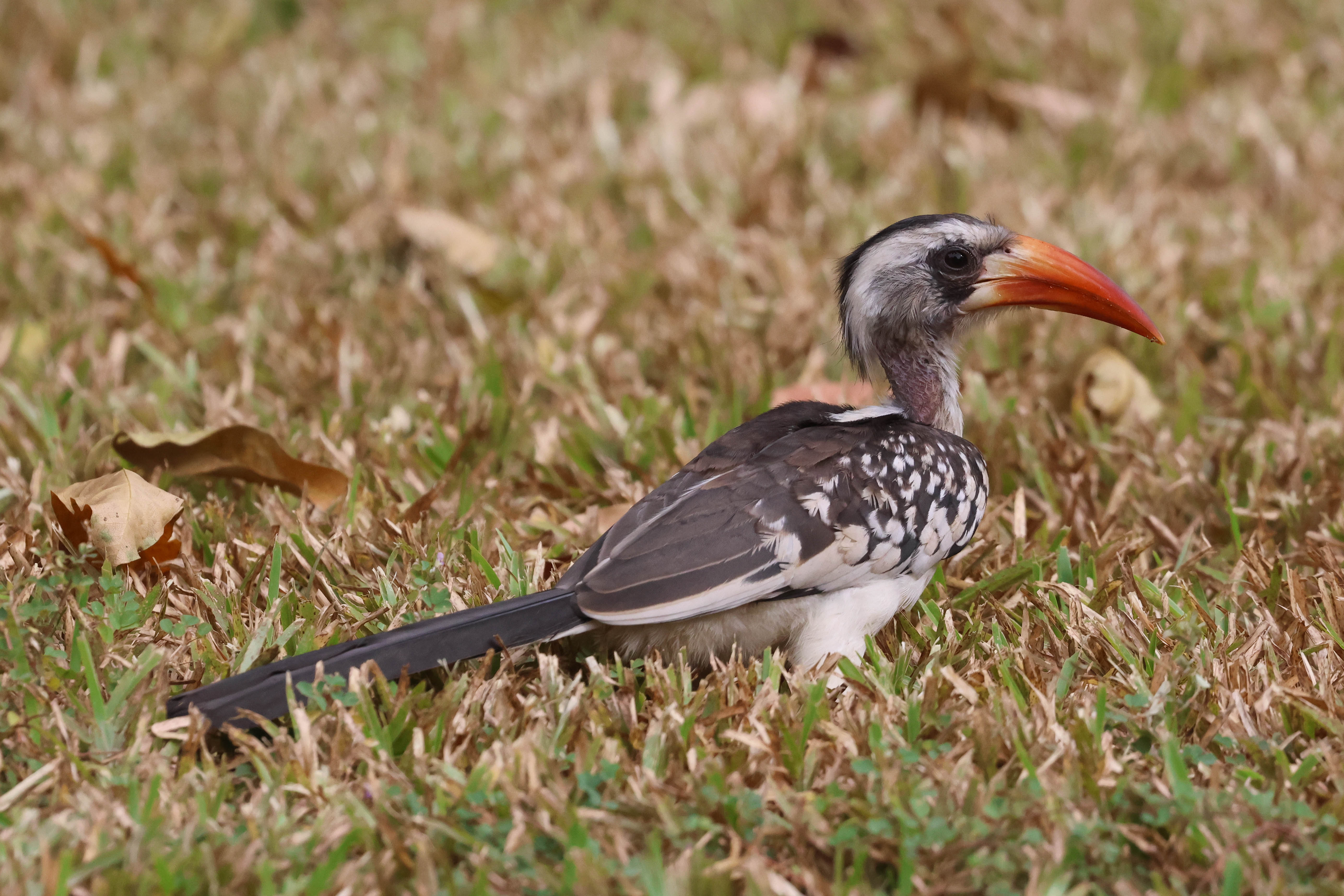
As dusk descended, we had a chance to change some money and buy some water before a slightly longer break to freshen up and for some of us to try to work out how to get the locks to their room doors to work (there is usually a technique to it!). We then met again for a quick drink before dinner. Most people were very tired after a long day, so didn’t stay up for the local drummers providing the entertainment tonight down by the pool.
Saturday 19th November
It is important to make the most of the morning here, before it gets too hot, so we were up for breakfast when the restaurant opened. A couple of Broad-billed Rollers were perched in the trees nearby and the family of Green Woodhoopoes were around their usual dead stump, where we would see them daily. A Cattle Egret dropped down onto the fence by the outside tables where it eyed up peoples’ breakfast.

After breakfast, we met up outside the hotel with Modou Taal again and our bus driver for the week, and set off on the short drive to Abuko. We stopped on the side of the road on the edge of the rice fields. A Hammerkop and Spur-winged Lapwing were down in a nearby wet field and a Black-headed Heron was perched in the top of a tree beyond. Two Violet Turacos flew over the road.
As we walked down the track into the ricefields, lots of Hooded Vultures were sat around waiting for the day to warm up. A distant Blue-bellied Roller and a Yellow-fronted Tinkerbird perched up nicely in the trees on the edge of the fields. Along the first smaller path we tried, we encountered lots of ants, so we turned back and found a different path out into the middle to scan the wetter fields. Here we found several African Jacanas and Black Crakes, Striated and Squacco Herons, Great White, Little and Western Reef Egrets. A Little Bittern flew past and a Black Heron circled round but wouldn’t land. A Malachite Kingfisher perched up briefly, then a more obliging Pied Kingfisher landed on a nearby post. Our first Senegal Coucal appeared behind us.

As we carried on further through the rice fields down towards a creek, we stopped to admire a Little Bee-eater and noticed lots of Village Weavers flying in and out of the reeds. A Palm Nut Vulture drifted over and a Shikra shot in and out repeatedly from a tree, hunting. A Lizard Buzzard perched in the trees nearby and an African Harrier Hawk flew over.
The Pied Kingfisher reappeared, hovering over the flooded field right behind us, putting on quite a show. A couple of Wire-tailed Swallows shot past. On the bank of the creek, we found several Senegal Thick-knees and lots of doves were coming to drink, including our first African Mourning and Vinaceous Doves. A Violet Turaco appeared in the trees behind, a very striking bird indeed!
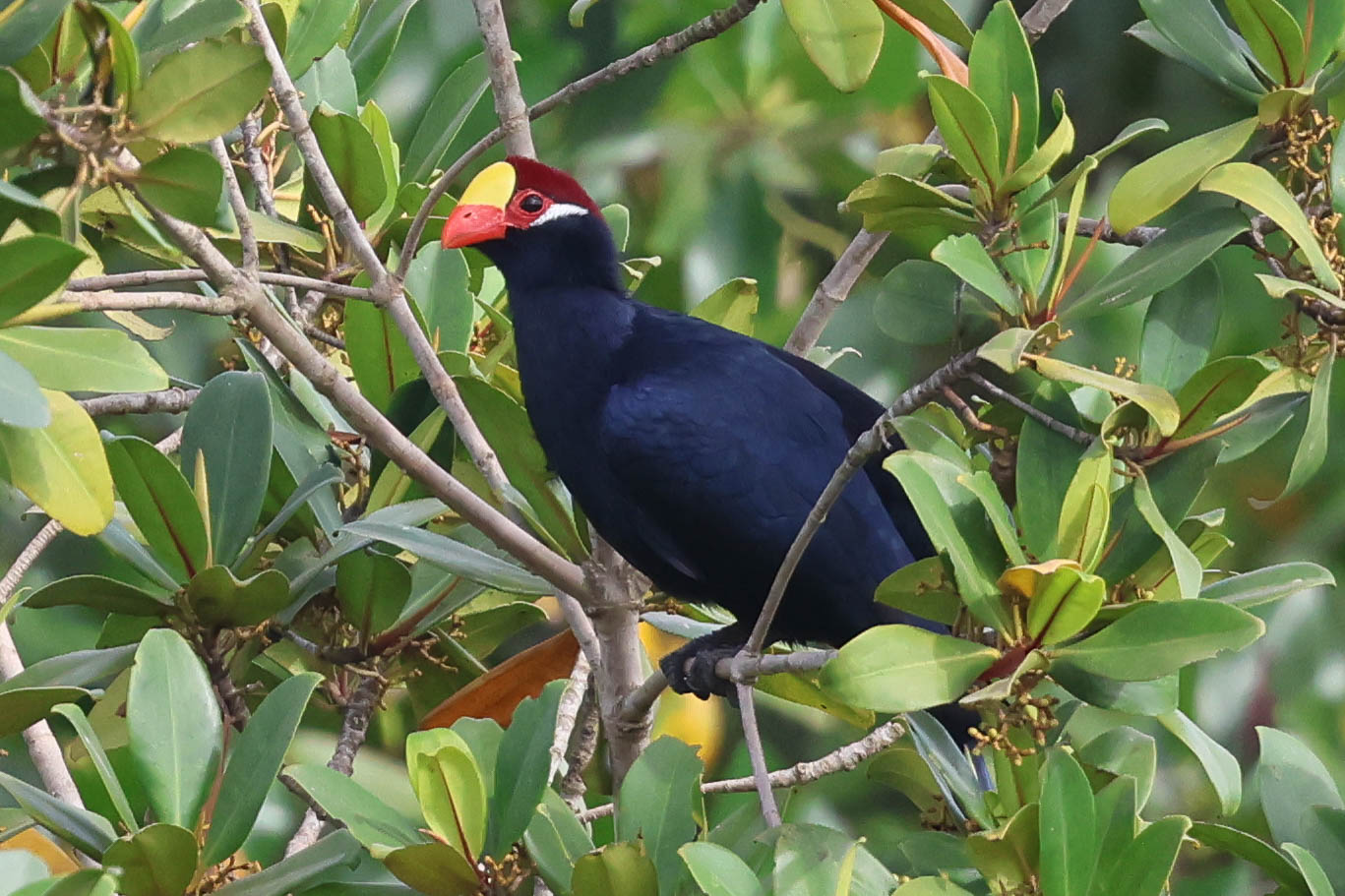
As it was starting to warm up now, the Hooded Vultures and Yellow-billed Kites were circling up overhead and three Grey Kestrels flew round amongst them. We made our way back round through the ricefields, where a Green Sandpiper was now out on the mud – a reminder that a lot of the birds here at this time of year are palearctic migrants which breed in Europe and come here for the winter. Our first Splendid Sunbird was feeding on some flowers in the trees.
Back to the bus, we had just a short drive to the nearby Abuko Forest. It was quiet at first here – not many birds but lots of butterflies and dragonflies, and several Green Monkeys and Red Colobus in the trees. We hadn’t walked far before we stopped at the Darwin Centre where a West African Crocodile was lurking half-hidden on the pool from the viewing terrace. A couple of Western Grey Plantain-eaters were in the trees just behind.
As we waited at the bottom of the steps for people to finish buying postcards inside, someone noticed a flash of blue from the base of the bushes. When it did it again, we crouched down and looked under the bush and found an African Pygmy Kingfisher hiding in the overhanging branches in the shade.
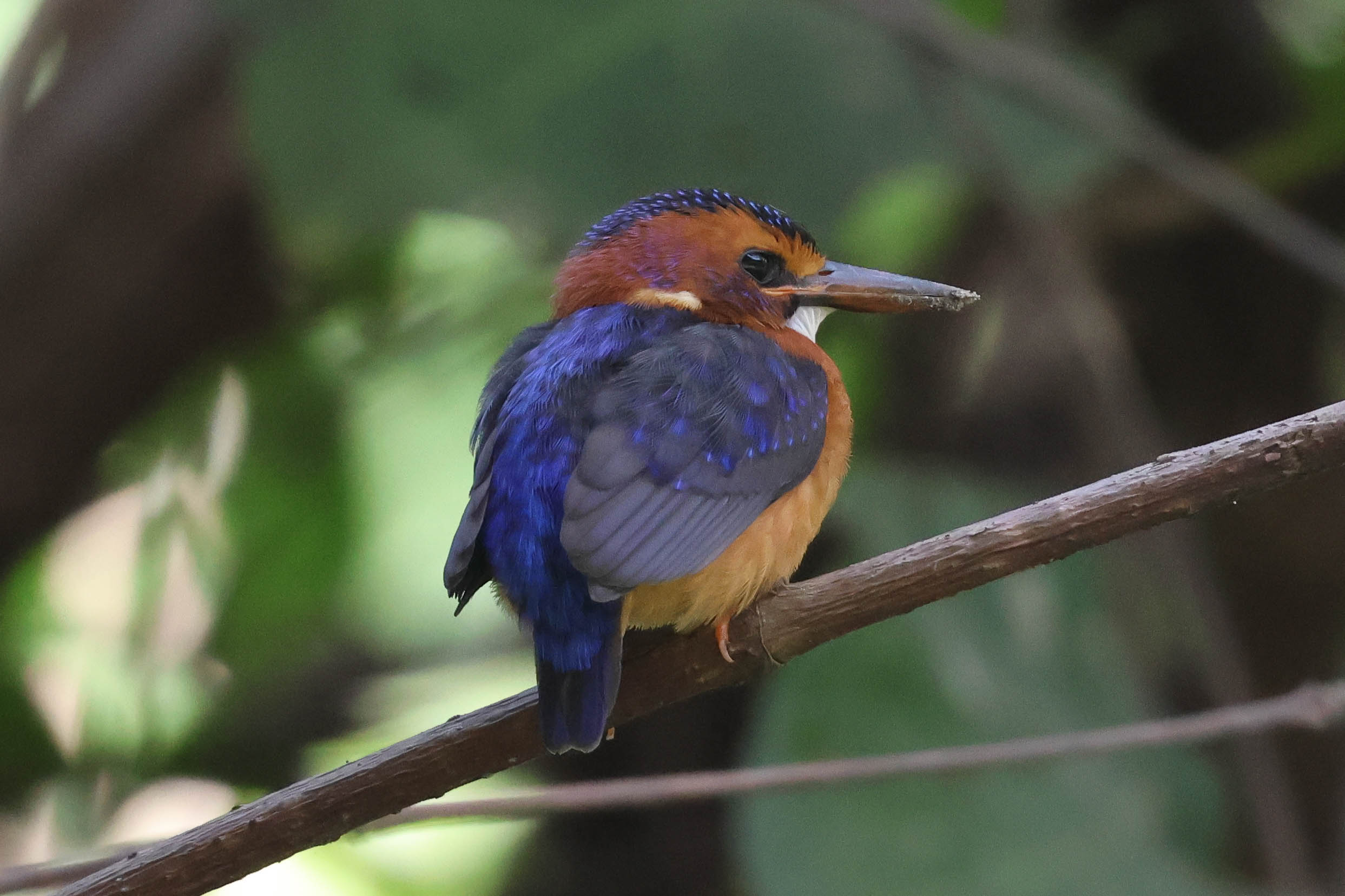
Carrying on through the wood, we started to find a few more forest birds. A pair of African Thrushes were feeding under the trees by the path and a Little Greenbul flitted around in the branches above. Further on, we came across several Red-bellied Paradise Flycatchers and as we stopped to watch them a Brown-throated Wattle-eye appeared right above our heads. Out into more open secondary forest, we looked up to see a couple of Fanti Sawwings hawking round the tops of the trees, a Grey Woodpecker flew in, as did several Bronze Mannikins and a pair of Yellow-breasted Apalis appeared in a nearby tangle.
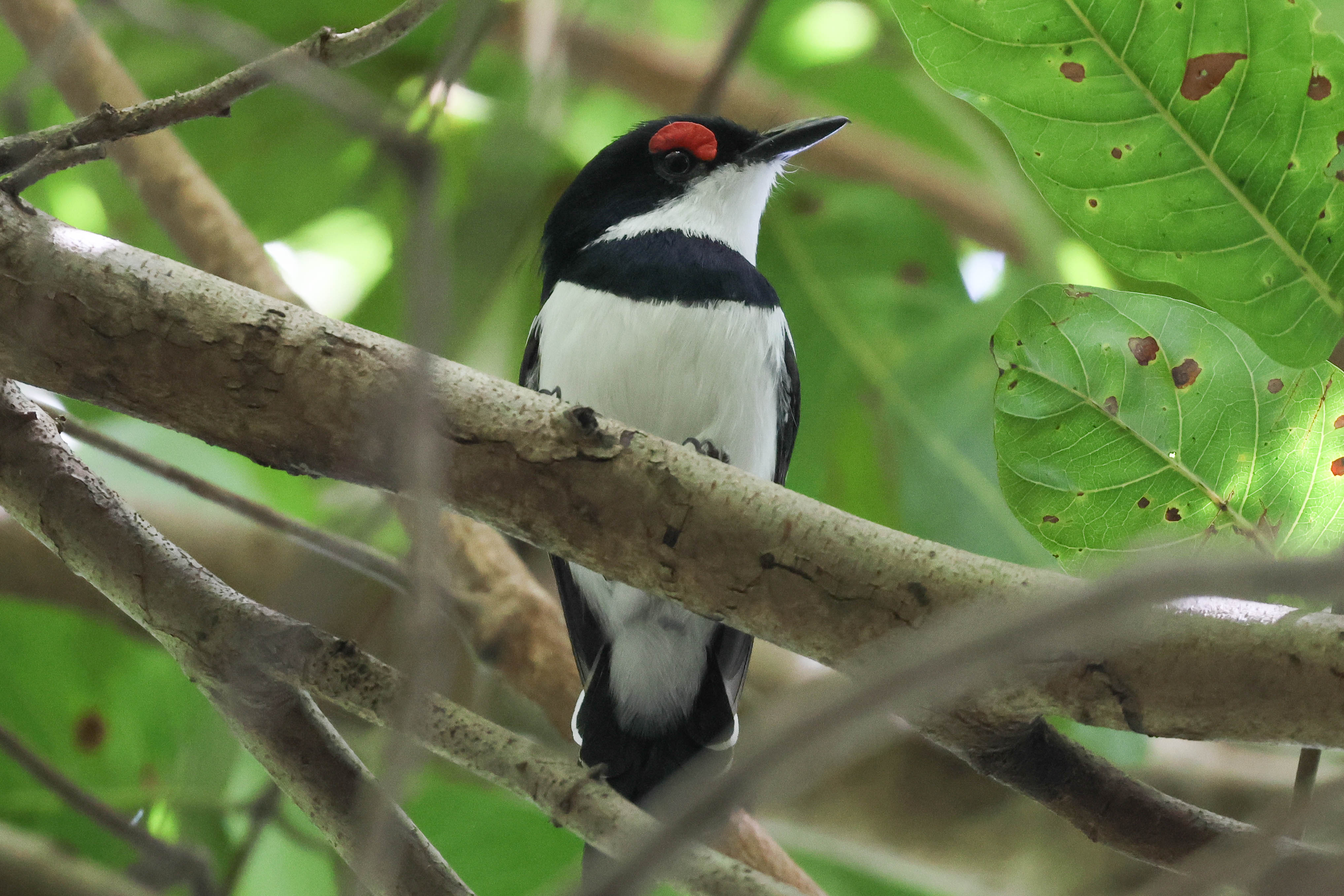
It had been all action this morning and we had worked up an appetite – it was already time for lunch now, so we made our way back to the bus. We were heading to a restaurant we hadn’t been to before, and after driving down some increasingly narrow and rutted side streets it turned out we couldn’t get all the way there in the bus. We had to get out and walk the last stretch through the ricefields, but of course that meant there were loads of new birds to see again. More distractions!
A Pearl-spotted Owlet appeared in the trees above us, mobbed by a mob of Common Bulbuls and other birds, including our first Grey-backed Cameropteras. An Osprey was perched on a dead palm trunk and a couple of Lizard Buzzards flew past. A smart male Northern Red Bishop perched in one of the ricefields, along with several browner females and a large family of Bronze Mannikins. As we got to the outside of the restaurant, a pair of Northern Crombecs were feeding in the trees above.
After our walk out here, it was nice now to have a break for lunch in the shade in the garden on the edge of the mangroves, with Little Bee-eaters hawking from the trees as we ate. A couple of Western Reef Egrets perched in the trees behind us, along with several Long-tailed Glossy Starlings and a single Bronze-tailed Starling. There were lots of Fiddler Crabs waving their claws on the muddy creeks beyond.
It was mid-afternoon by the time we walked back to the bus and although it was the heat of the day, we didn’t notice as we were surrounded by even more birds now. An Orange-cheeked Waxbill perched up in the reeds just outside the restaurant and a Senegal Coucal allowed us to walk right past it in the ricefields. We stopped to admire a Woodland Kingfisher and a Fine-spotted Woodpecker appeared in the same tree. A Bearded Barbet flew past.
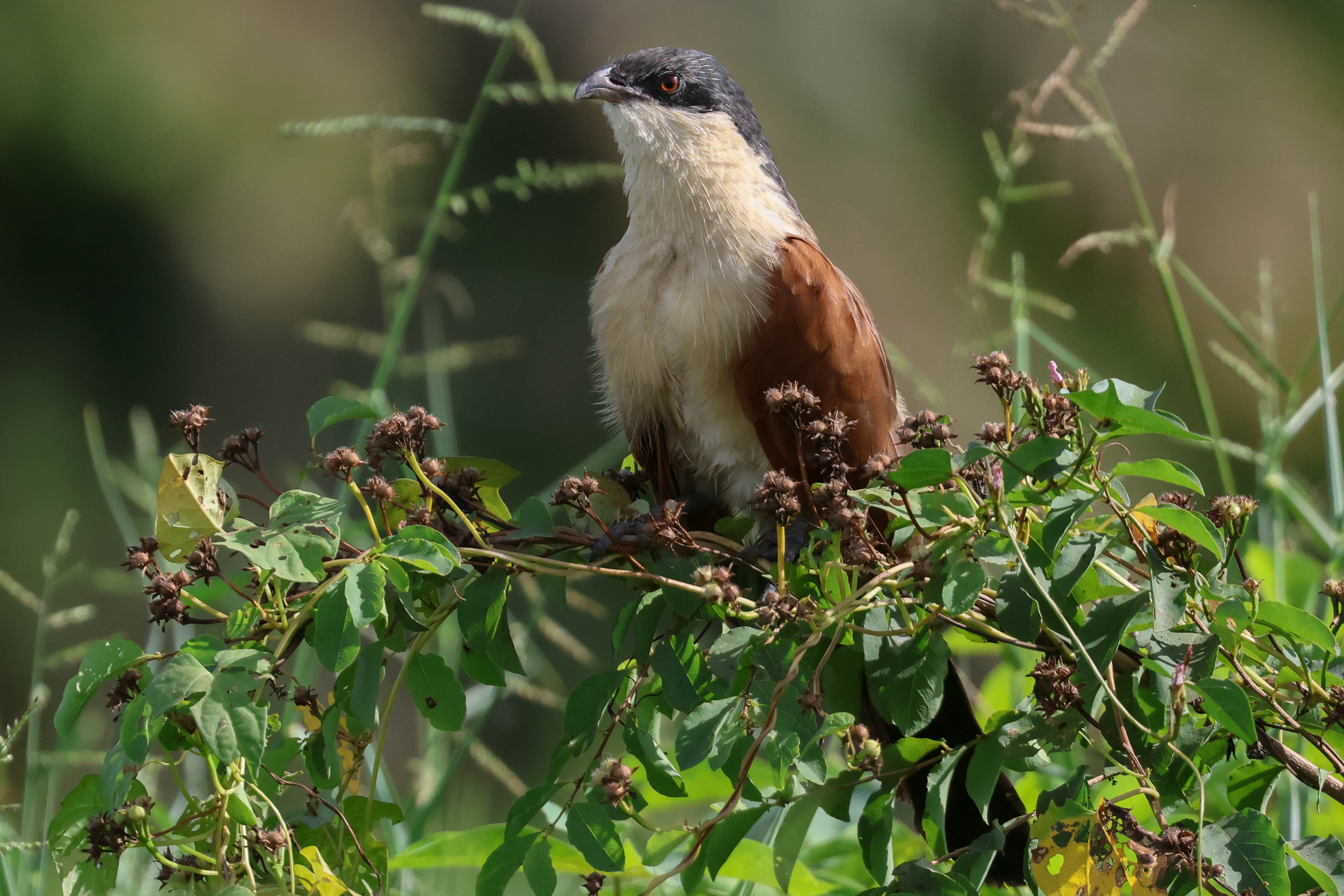
We found the Pearl-spotted Owlet again, in roughly the same place we had seen it on the way out, and some very nice views in the scope now being mobbed by bulbuls and Plantain-Eaters. We were almost back to the bus, when Modou heard a Klaas’s Cuckoo calling and after he tried whistling back for a while eventually it appeared in a distant tree. While we were watching it, a pair of Village Indigobirds chased through the bushes in front of us.
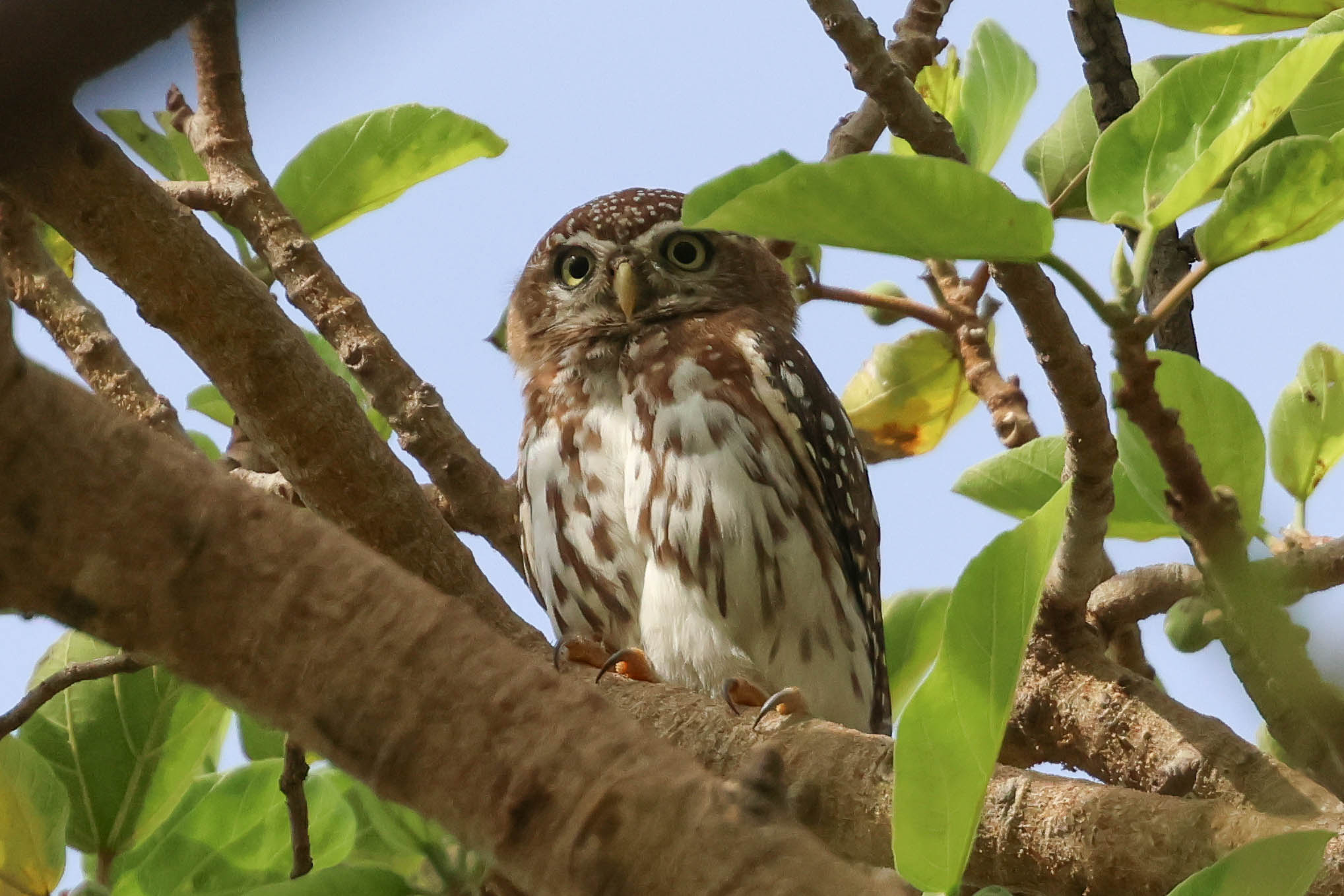
With all the birding on our walk to and from lunch, we were later getting to Kotu than planned. The bus stopped along the road to the bridge, and we walked down. An Oriole Warbler was singing on the edge of the mangroves, so we stopped to see if we could locate it. A Malachite Kingfisher was perched in the bushes but shot off as we approached.
We couldn’t find the Oriole Warbler, but the clear area by the road was full of doves and finches. We had better views of Vinaceous Dove here in particular, along with several Red-billed Firefinches and three Red-cheeked Cordon-bleu feeding in the short grass.

We tried a short way down a track through the mangroves, which produced Blue-breasted Kingfisher, then turned back and walked on down to the famous Kotu bridge. A Western Reef Egret and a Long-tailed Cormorant were both perched obligingly on a nearby stump, the latter drying its wings. A Black-winged Stilt was stalking around the shallows and both Whimbrel and Greenshank flew round calling.
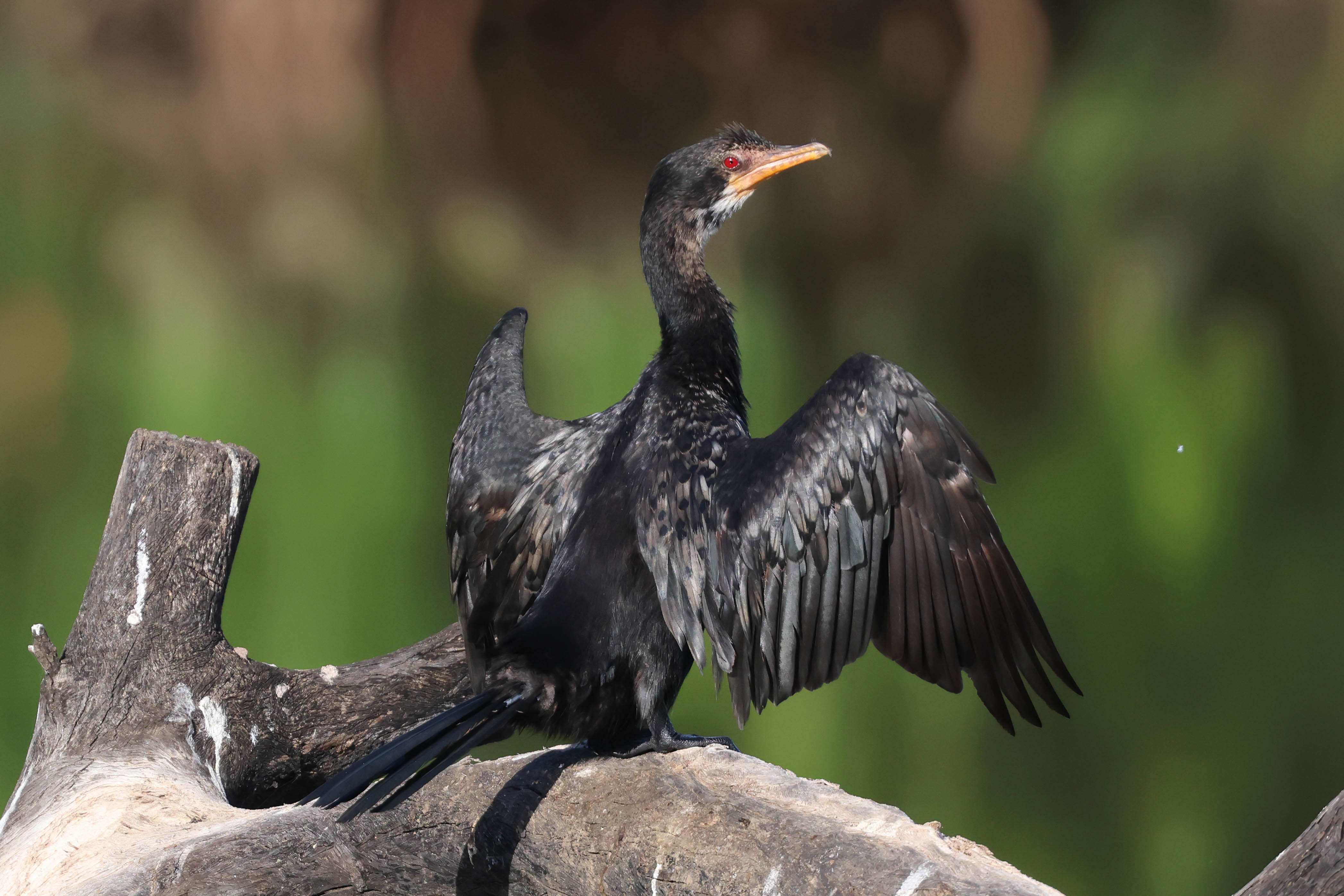
We walked back up the road to the nearby sewage ponds next. When we stopped to admire a pair of Woodland Kingfishers in the trees by the verge, a Yellow-fronted Tinkerbird appeared in a tree right next to us. When it disappeared we realised it had gone into a hole in the branch, so we waited and after a minute or so its head popped out! A Palm Nut Vulture was chased through the trees by Pied Crows which were probably after the fish it was carrying.
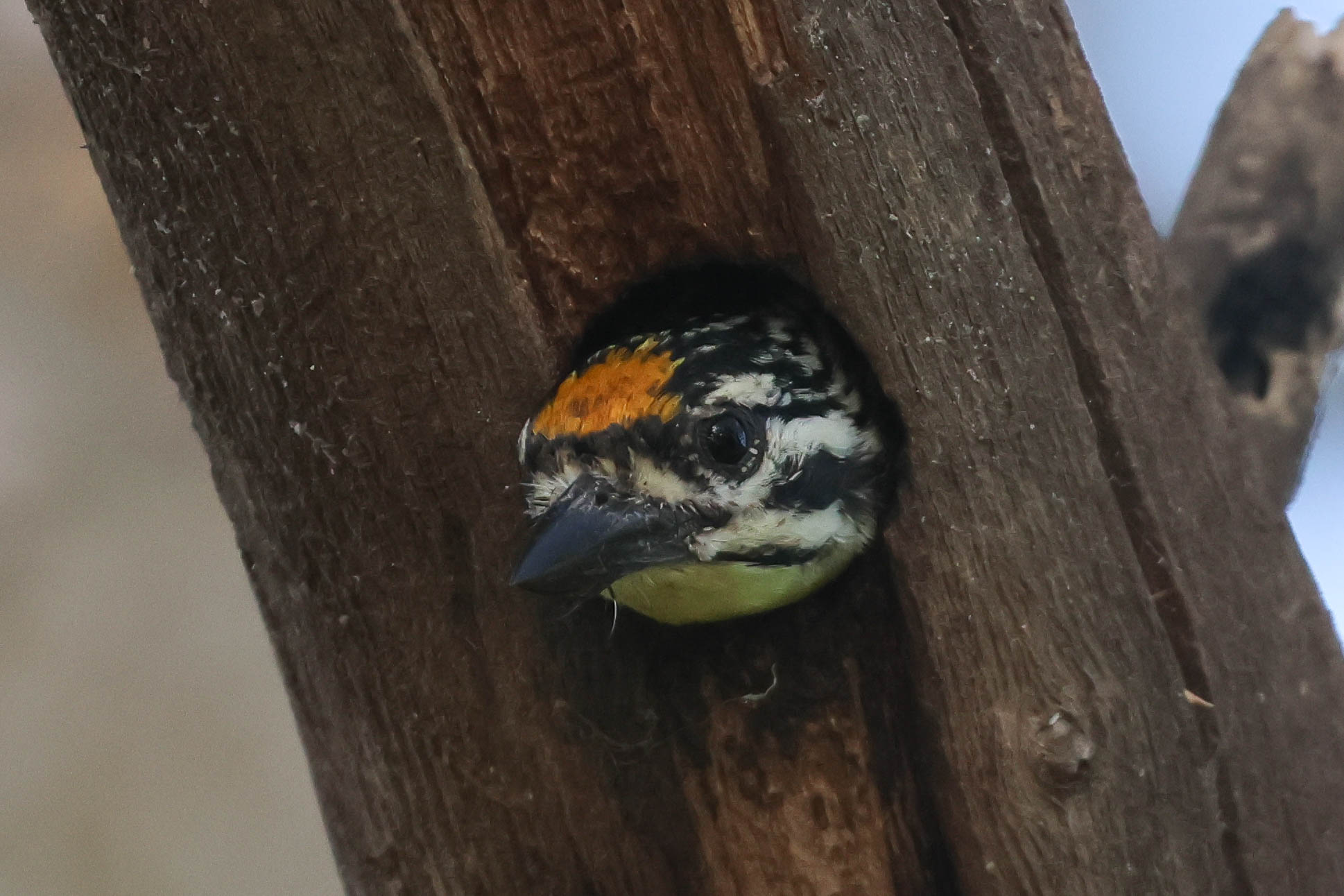
Up at the sewage ponds, there were lots of Spur-winged Lapwings and scanning round we found a Common Sandpiper on a small pool. Lots of Cattle Egrets were standing around on bund beyond. A Pearl-spotted Owlet was being mobbed in the trees just behind us, but disappeared in as went to look. We walked down to the trees along one edge, where three Yellow-billed Shrikes were perched, then cut down along paths through the fields and back through mangroves to the bridge.
A Pied Kingfisher was perched on the stump now, where the egret and cormorant had been earlier, with a large fish in its bill which it was beating repeatedly on the post. Unfortunately the light was starting to go already and it was time to head back and freshen up before dinner. It had been a great first day, an excellent introduction to some of the commoner birds of The Gambia in particular.
Sunday 20th November
After breakfast, we headed straight out again for the day. We met the bus and driver outside the hotel and had a change of guide today – Modou Jarju would now be with us for rest of our stay, along with his assistant Fanta. It was not too far to Brufut, where we disembarked and were met by one of the local forest guides, Madi. We set off down a track between the trees and a large walled garden where lots of people were working. Modou heard Yellow-throated Leaflove calling on the edge of the trees and we quickly located it in the branches.
As well as the Leaflove, birds were coming thick and fast here: our first Black-billed Wood Doves, then a smart Sulphur-breasted Bush-shrike, Northern Puffback and Northern Black Flycatchers. A Singing Cisticola perched up at the back of some abandoned building works and a Guinea (Green) Turaco flew over. Continuing down the path, an African Grey Hornbill was perched high in the trees, a pair of Shikra chased round overhead and a Yellow-breasted Apalis showed really well in a tangle of branches over the path. An African Golden Oriole flew over and a Glossy-backed Drongo landed on the wires nearby.
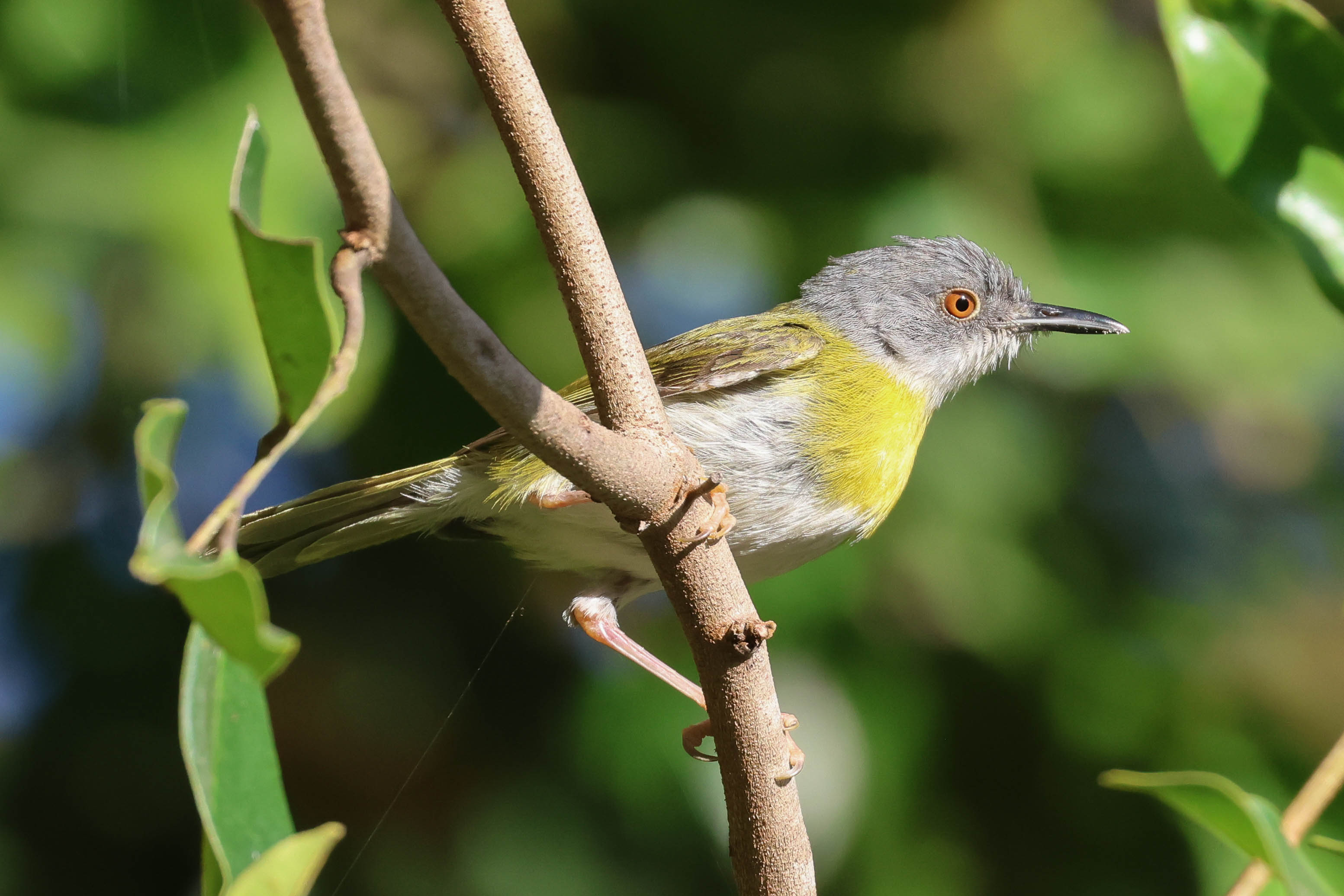
We turned back and took another in path the other side of the track, in through some more cultivations. A Grey Kestrel was perched on a large water tank way off in the distance. While Madi went off to look for owls, we stopped to scan. A variety of different sunbirds were coming and going from a nearby flowering tree, including two Western Violet-backed Sunbirds and our first Copper Sunbirds too. A Pearl-spotted Owlet flew out from a nearby tree, chased by a crowd of bulbuls and other small birds, including several Lavender Waxbills.
Madi had not found the hoped for owls here, so we walked back through some more overgrown gardens, where a male Variable Sunbird was singing and a Village Indigobird perched up ahead of us.
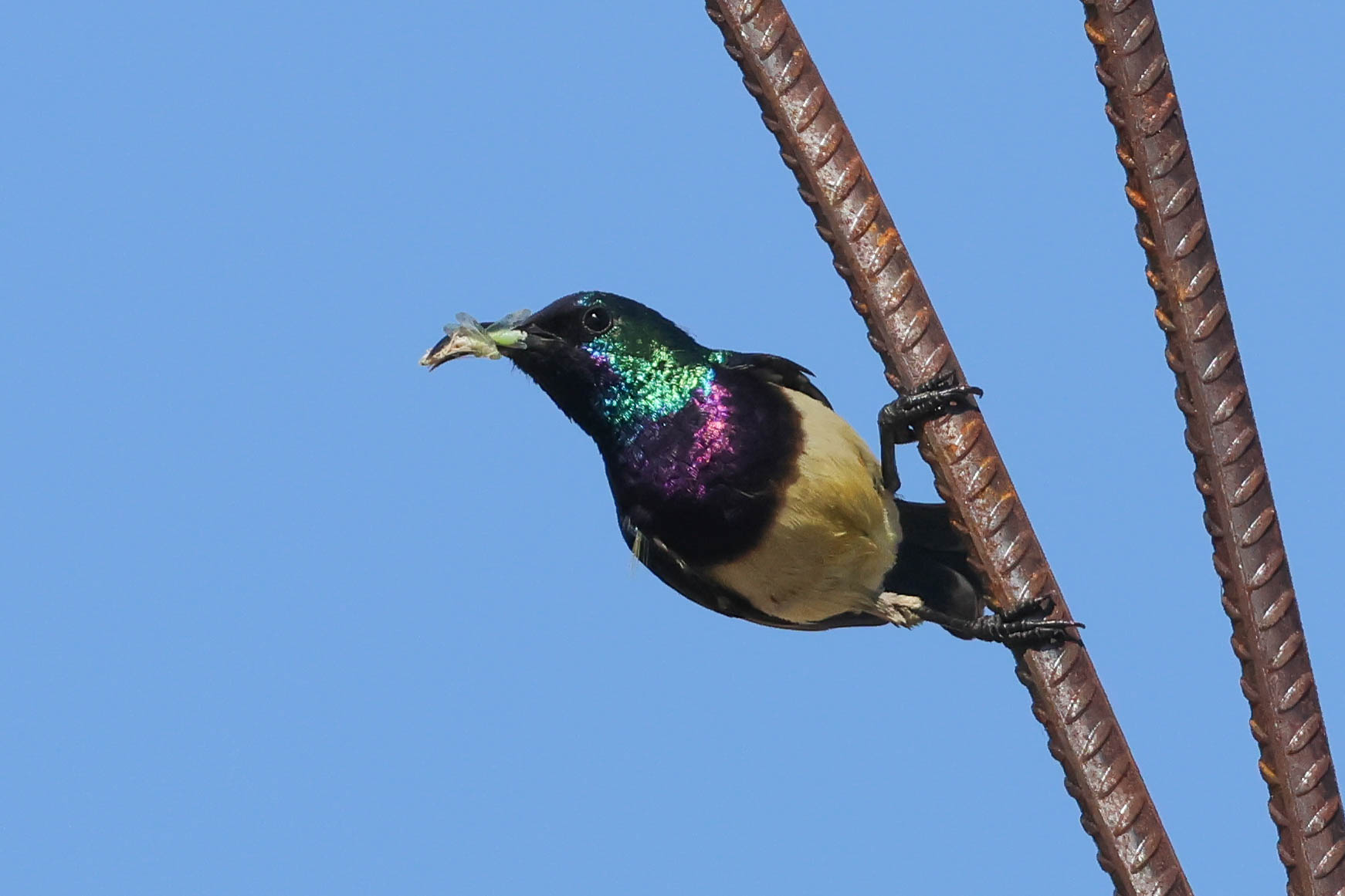
We stopped in one area to try for Black-winged Bishop. There were lots of weavers in the reeds, mostly Village Weavers but with a couple of Vitelline Masked Weavers too. First a female Black-winged Bishop appeared briefly then we found a couple of smart red and black males a bit further down.

Walking on, we cut back into the wood. A Melodious Warbler was singing and eventually appeared in an acacia by the path. Our first Yellow-crowned Gonolek came in too, one of the most striking birds here with its bright red underparts, jet black wings, back and mask and contrasting canary yellow crown.
We sat down now on the shady benches overlooking some bowls of water where a succession of birds were coming and going for a drink – and we had a chance to get a cool drink while we watched too! There were more Black-billed Wood-doves, Bronze Mannikins, Cordon-bleus and Firefinches. A Gambian Sun Squirrel came in for a drink too. Several Little Bee-eaters hawked around and a Swallow-tailed Bee-eater landed briefly. Four Pink-backed Pelicans drifted high overhead.
We were then led deeper into the woods, to where Madi knew a Long-tailed Nightjar was roosting on the forest floor and we were led in two at a time to view the bird. Always amazing that they are located here, deep in the woods and given how well camouflaged it was against the leaf litter.
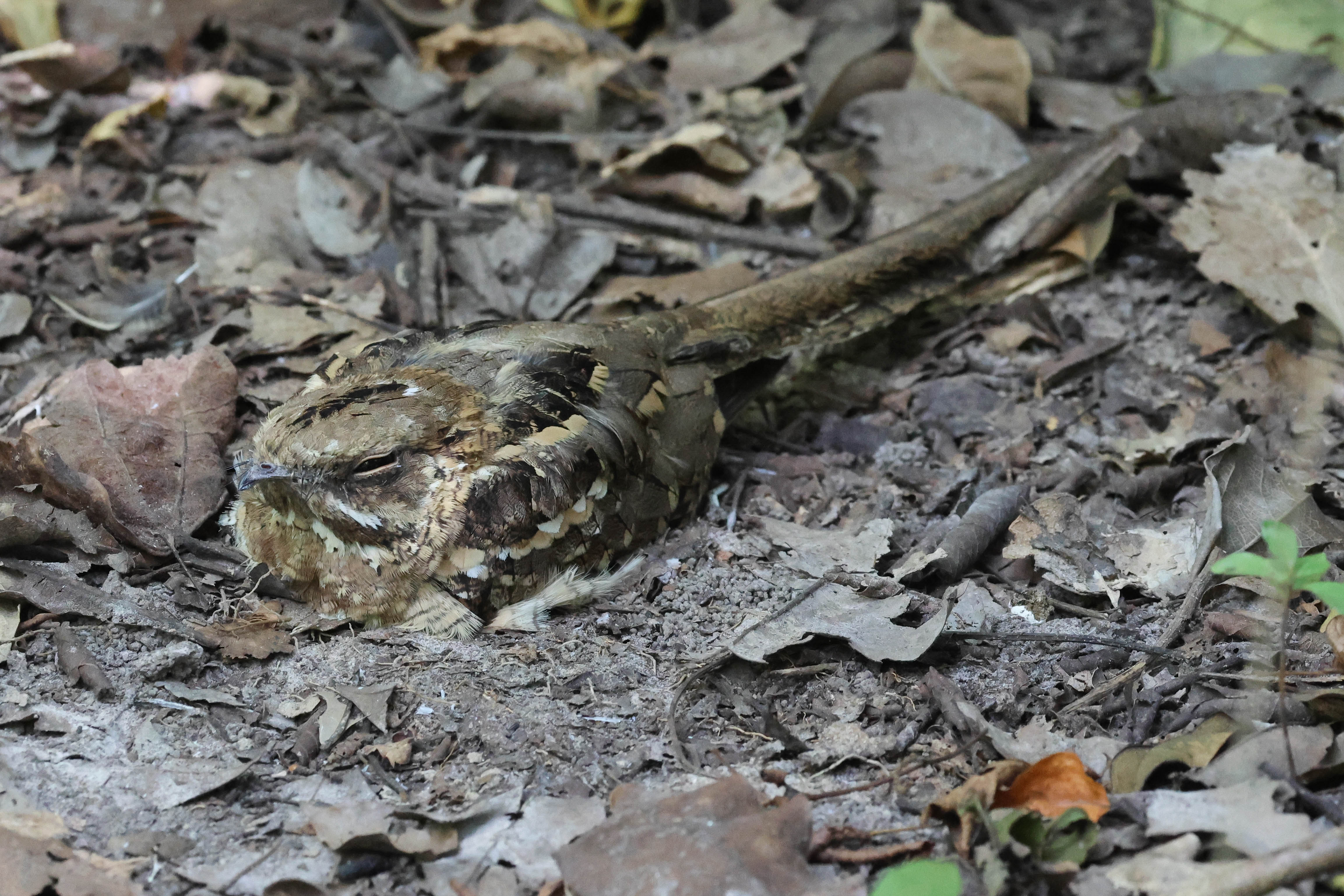
While we were here, Modou heard a Northern White-faced Owl calling nearby so once we had all seen the Nightjar, we went to look for it. We stopped to see if it would call again, and it did, from deep in some trees. Madi went in to try to locate it, and soon came the reply that he had. It was very well hidden, and we realised there was actually a pair of Northern White-faced Owls now, hiding in the leaves. An amazing find!
We went back to the drinking bowls, for another quick look and this time an African Pygmy Kingfisher had come in. Then we made our way back out to where the bus was parked. A quick look in the open woodland beyond provided better views of Swallow-tailed Bee-eater, perched in the top of a tree, and a distant Lizard Buzzard.
It was just a short drive from here to Tanji for lunch, where we found a large table and various chairs set up in the shade overlooking a small pool. Lots of Common Bulbuls and weavers were coming in and out to drink and bathe. We had heard several Oriole Warblers already but not actually seen one yet – now here one was hiding in the trees above the pool. It wouldn’t come down to water at first, but eventually we got good views when it stopped being quite so shy. Our main target here was Western Bluebill and we didn’t have to wait long before one appeared. A female came in through the branches above and eventually dropped down to the pool and nearby bowls for a drink and bathe.
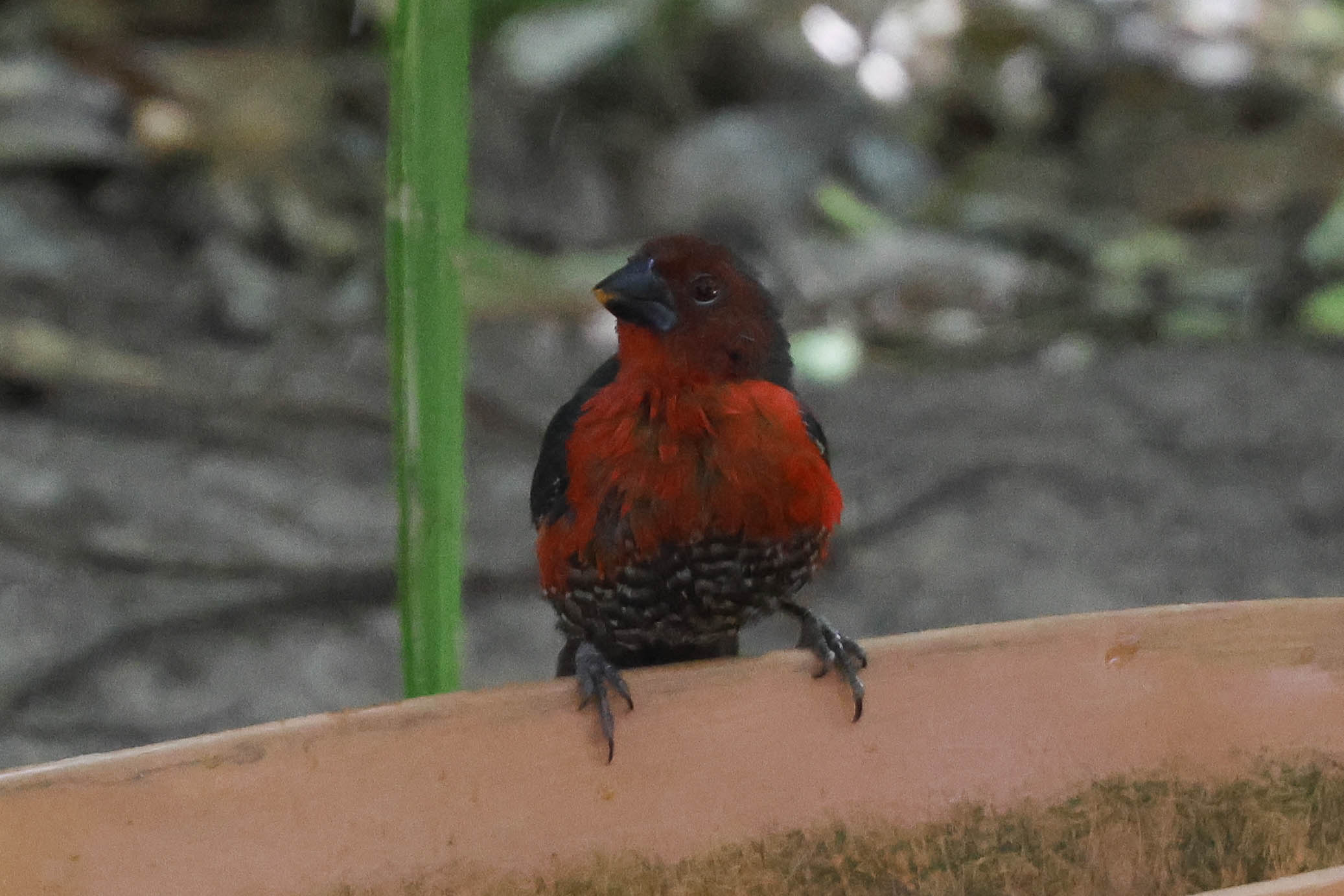
After a delicious local lunch, it was nice to sit here and relax a little while through the heat of the middle of the day and just watch the activity. Various birds came and went from the water: a Green-headed Sunbird dropped in, Blue-spotted Wood Dove, several African Thrushes, Red-bellied Paradise Flycatchers and a brief Snowy-crowned Robin Chat.
After lunch and a break watching all the birds coming and going, we got back in the bus and drove down to Tanji beach. There was rubbish everywhere and a strong smell of fish as we made our way down a narrow alley and out onto the beach, but we were soon distracted by the birds. Lots of Caspian Terns were flying up and down just offshore and Grey-hooded Gulls and Lesser Black-backed Gulls were gathered out on the water.
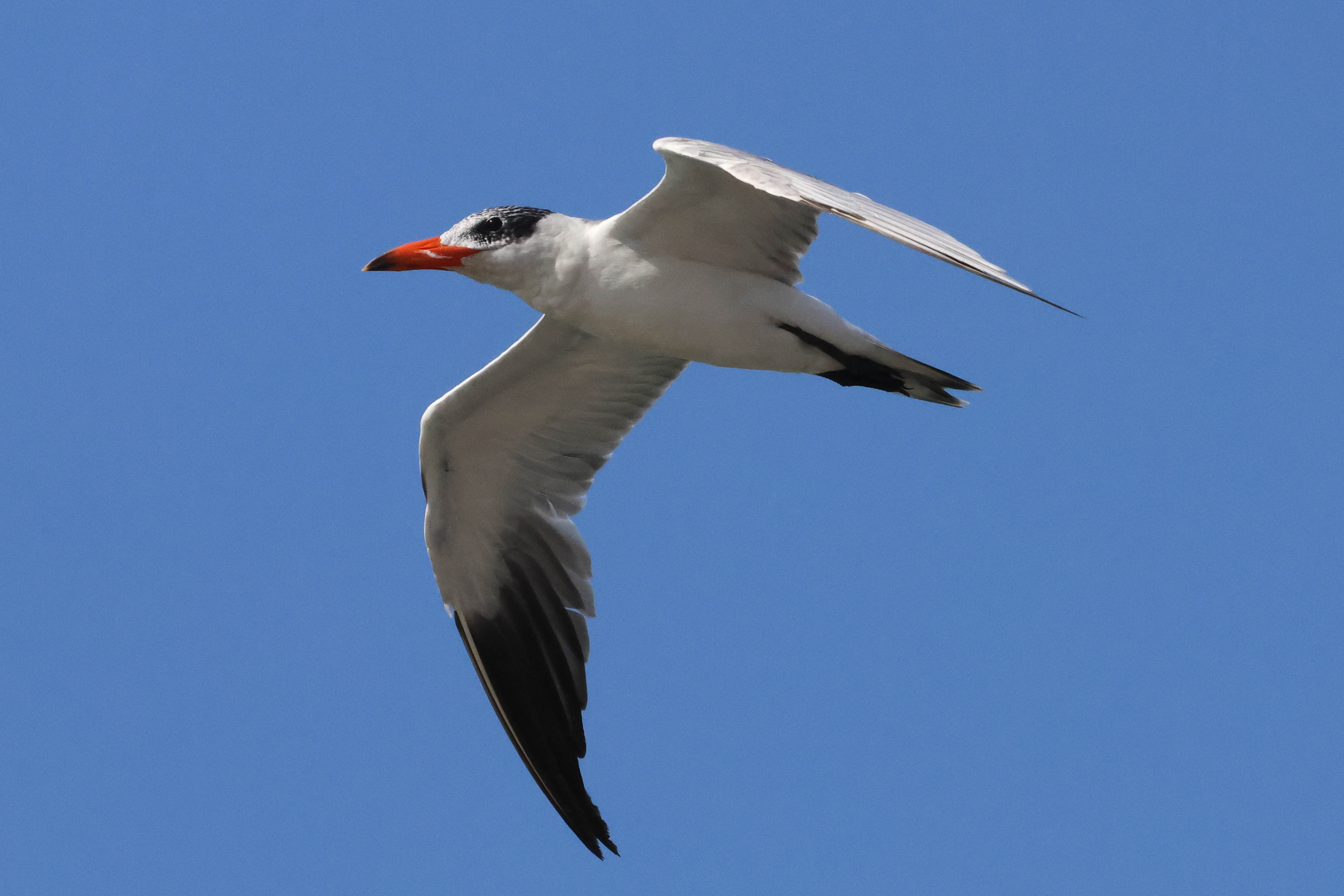
We scanned the boats moored offshore, where Sandwich Terns were resting on the gunwales and found a single Lesser Crested Tern and a Common Tern in with them. Several Ruddy Turnstones were perched on another boat and two Bar-tailed Godwits flew past along the beach, as several White-breasted and Long-tailed Cormorants flew back and forth overhead. A cloud of gulls and terns flew up from the distant sandbar offshore where they were roosting and scanning with the scope we picked up a small group of Pink-backed Pelicans out there too.
A couple of Pied Kingfishers were hovering just offshore fishing, Yellow-billed Kites kept swooping down to collect dead fish from the water and several Pied Crows were looking for scraps along the beach. A group of Little Swifts hawked back and forth over the village behind the beach.
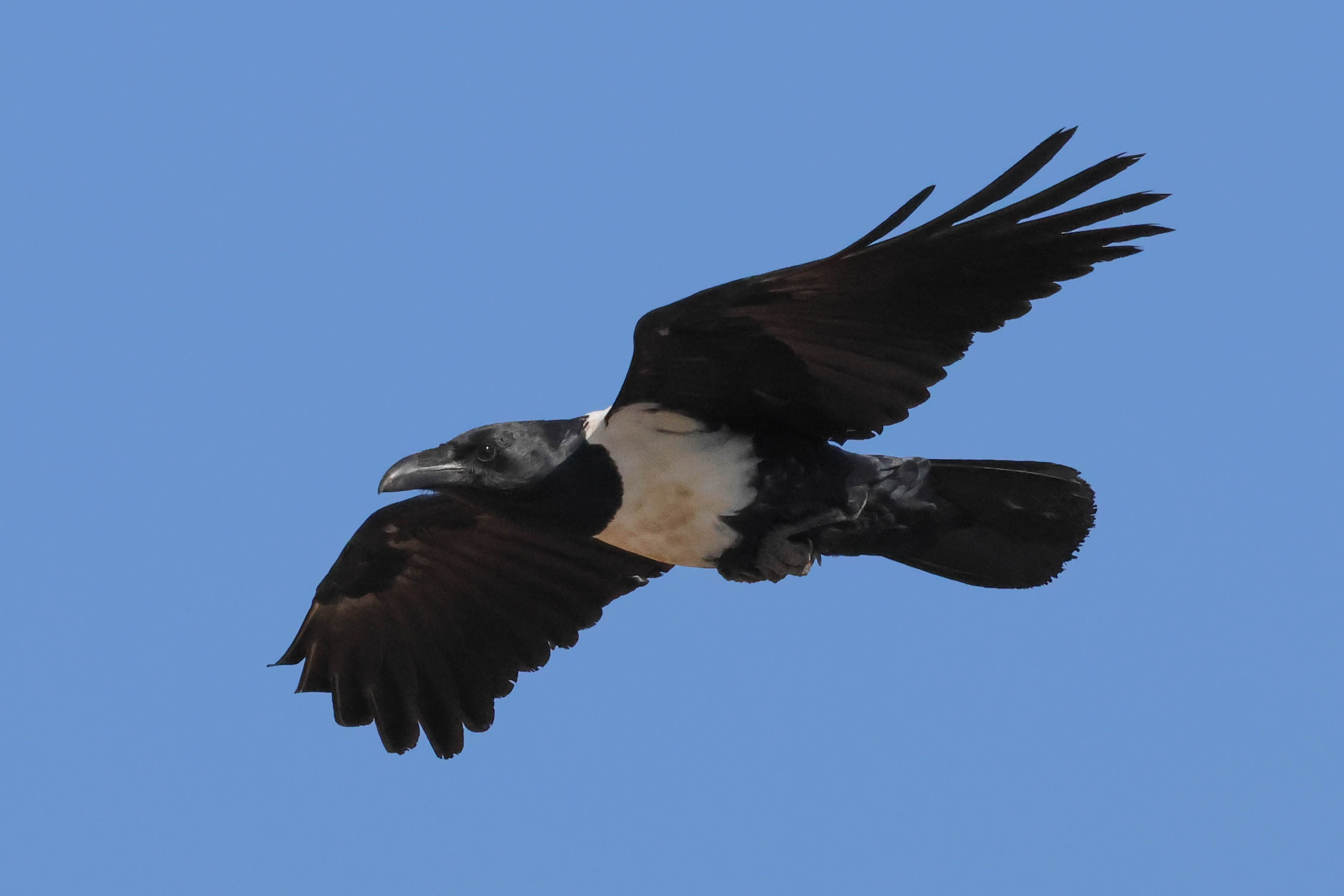
Our final destination for the afternoon was Tujerang. It had already started to cool down a little as we walked down along a track through the scrub towards the beach. There were more Palearctic migrants in the bushes here – several Western Olivaceous and Melodious Warblers, and a Tree Pipit perched up briefly. A couple of Senegal Eremomela flitted in and out, along with both Whistling and Zitting Cisticolas (the cisticola formerly known as Fan-tailed Warbler!) and a smart Black-crowned Tchagra perched up singing.
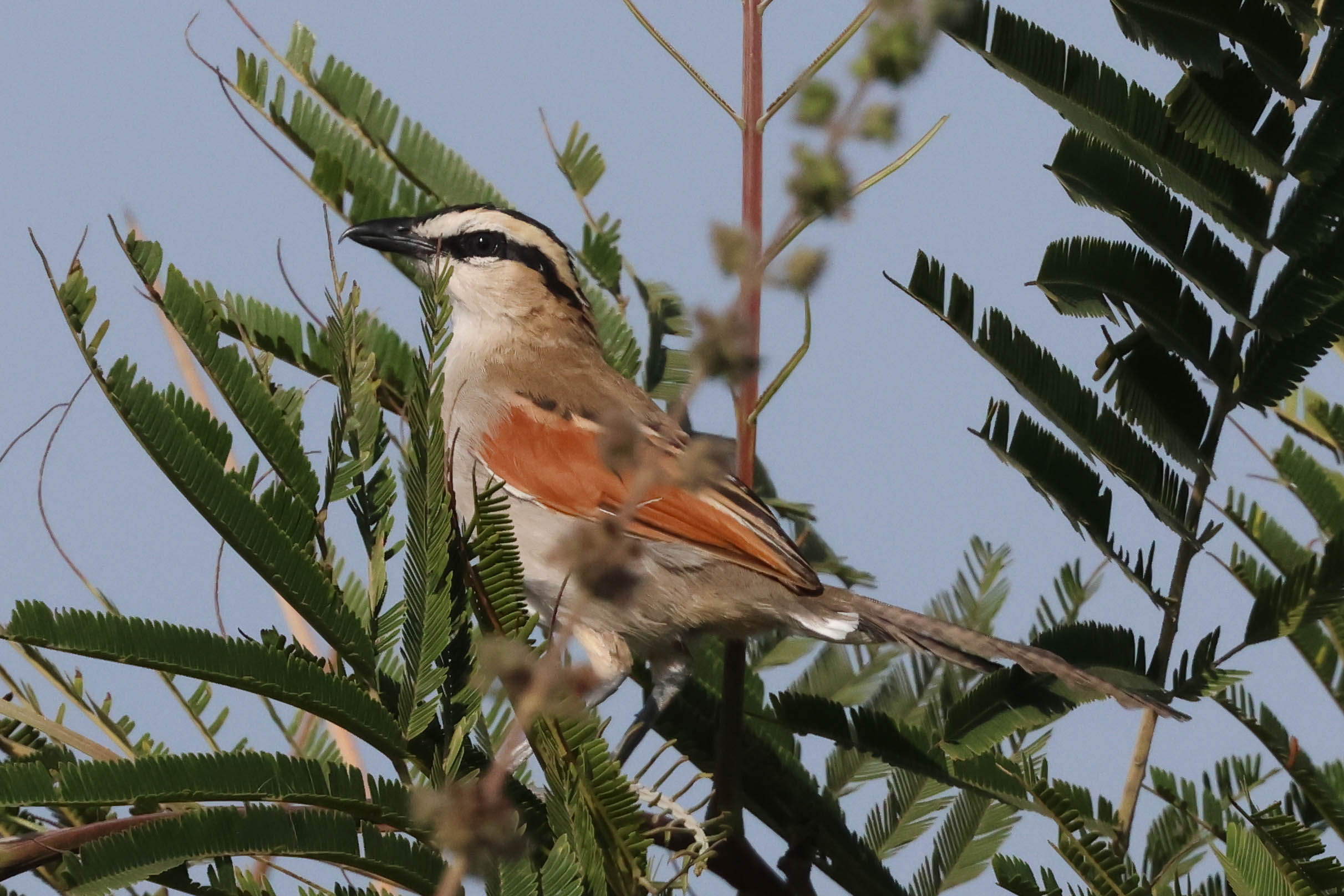
A succession of weavers flew in and out and among the commoner Village Weavers we picked out our first Black-headed Weavers and got better views of Little Weaver. But the big surprise of the day was a pair of Sudan Golden Sparrows which flew in and landed briefly in the bushes in front of us – they are nomadic wanderers, commoner further north in Senegal and normally scarce here.

We were particularly looking for some Chestnut-bellied Starlings here and eventually found them in the more open cultivated areas just behind the beach. We had some great views as they flew up and down from the fence – another scarce bird here, and another good one to see.
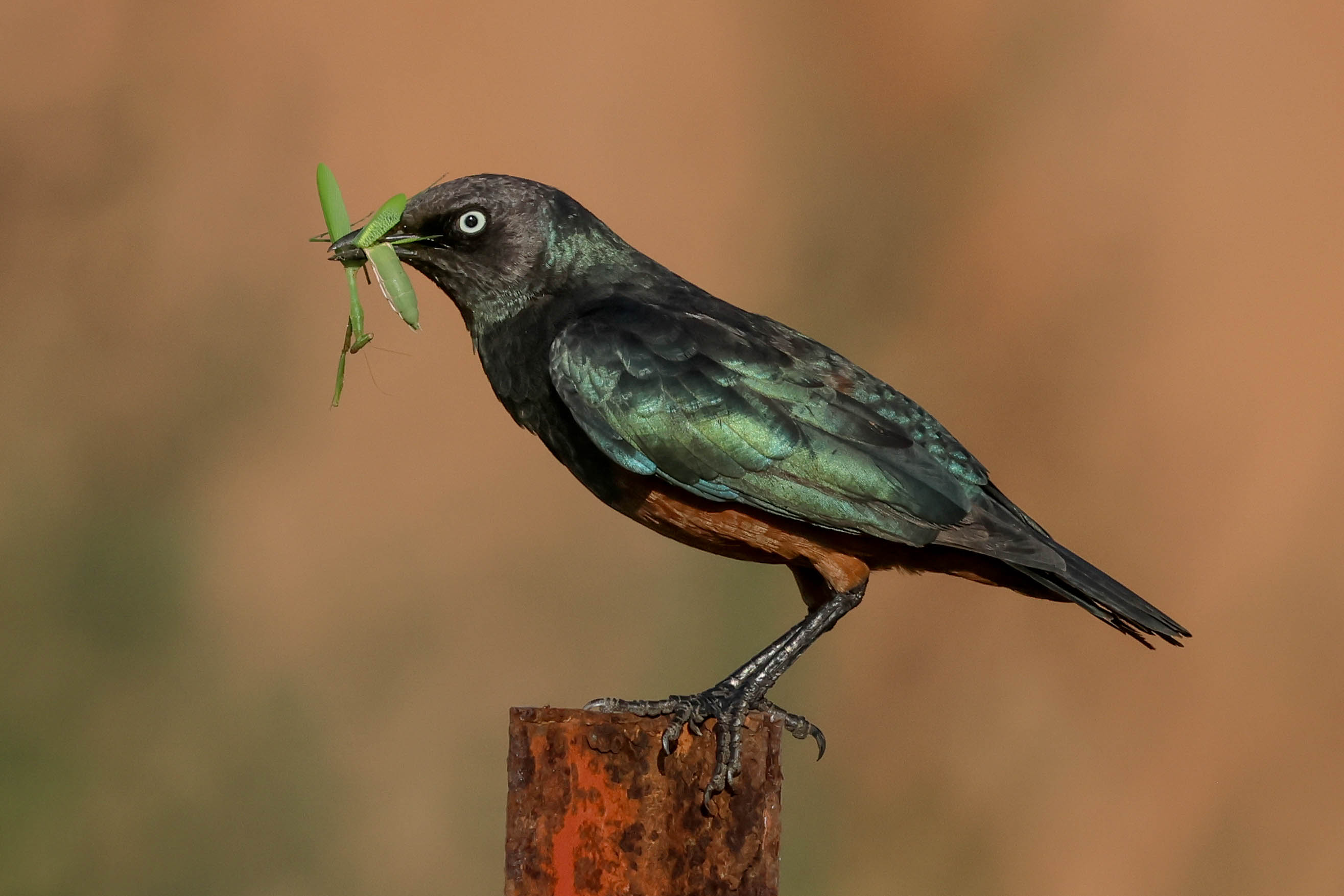
A White-billed Buffalo Weaver was feeding with them. Modou heard a Levaillant’s Cuckoo calling and eventually managed to whistle it in. A Common Whitethroat perched up briefly in one of the thorny bushes nearby.

There were some small pools behind the beach further up, so we stopped to scan. The first held Black-winged Stilt, Green Sandpiper, Western Reef Egret and several Senegal Thick-knee. A pair of Double-spurred Francolin ran in and out of the vegetation at the back. A couple of Crested Larks flew up nearby calling and an Osprey drifted over. Several African Jacana were on the larger pool beyond and an African Darter was drying its wings in the top of a low tree on the edge.
As we made our way back along the track, Modou heard Chestnut-crowned Sparrow Weaver calling, so we stopped to see if it would show itself. It didn’t, but we did get to see a pair of Red-winged Warbler instead and a Red-necked Falcon shot through low over the bushes, hunting. Little Bee-eaters and Yellow-fronted Canaries showed well in the late afternoon sunshine.
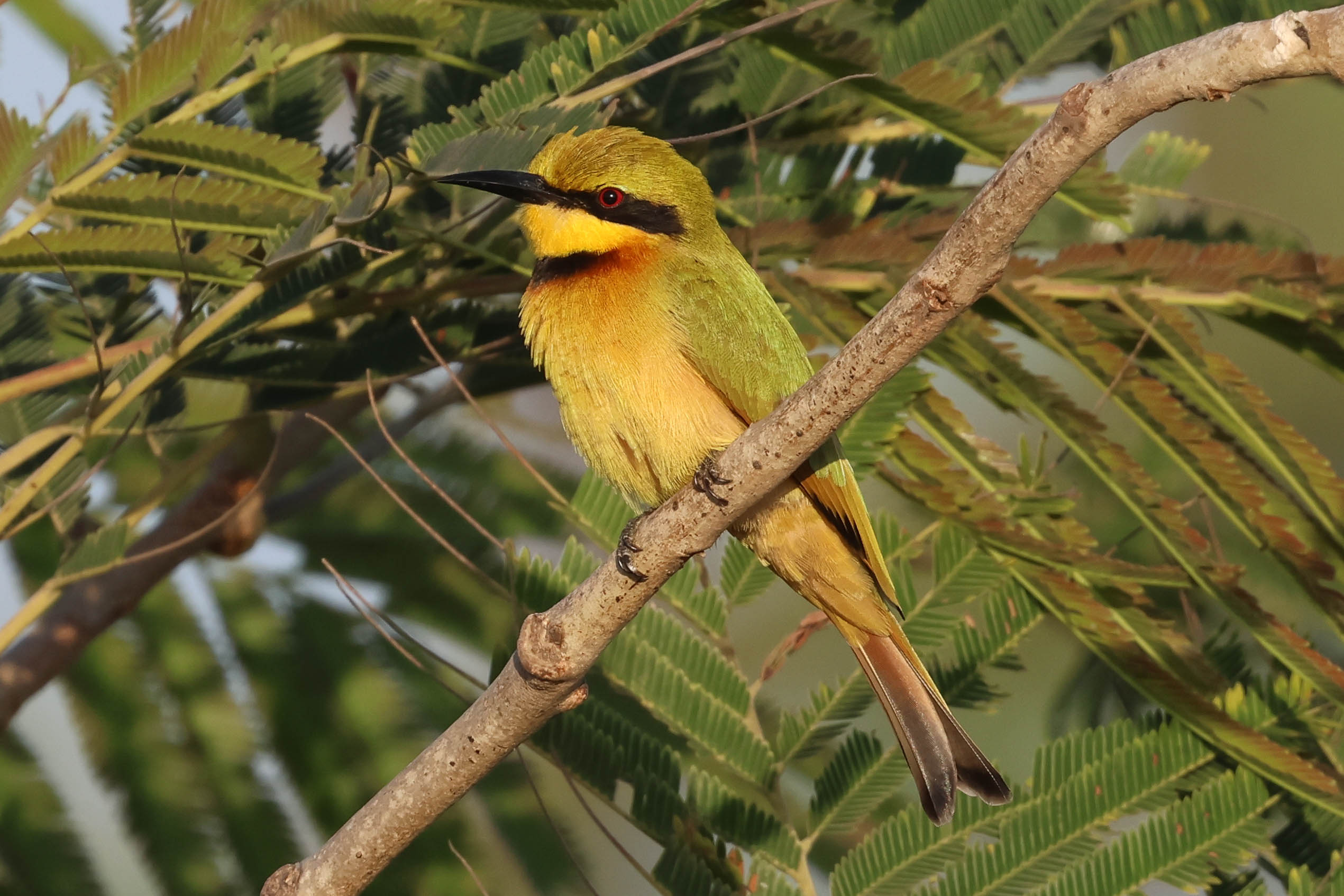
Back to the bus, we made one last stop of the day a little further down. A flock of Piapacs came up from the ground as we got out and landed in a nearby tree. A Striped Kingfisher was calling in the top of another and a Lesser Honeyguide appeared above our heads, along with a Willow Warbler. Unfortunately, we were out of time – the sun was already setting as we set off to drive back to the hotel, and we still had to battle with the congestion due to the new airport road construction again.
Monday 21st November
We had a longer drive this morning down to Farasutu. As we turned off the main road through the village, our first Purple Starling landed on the wall ahead of us and as we got out to the fields beyond there were lots of Cattle Egrets. We got out and set off down a narrow path through the fields, stopping under a large acacia tree where a small plot of chillis was being grown below.
A succession of birds came and went, starting with a selection of sunbirds – Pygmy and Scarlet-chested Sunbird were both new for the trip. A pair of Grey Woodpeckers flew in, a male Northern Puffback appeared briefly, along with Red-bellied Paradise Flycatcher, Western Olivaceous, Melodious and Willow Warblers and our first Common Chiffchaff of the trip. A Nightingale was calling in the bushes behind but didn’t show itself, but then back out on the main track, as we walked down towards the forest, another Nightingale flicked across the path ahead of us.
We stopped to look at the drinking pots by the entrance to the forest, but there wasn’t much activity here yet. A few Firefinches came to drink along with a Blue-spotted Wood Dove, and a Grey-backed Cameroptera picked around in the trees above us. We were met by one of the forest guides, ‘Bob’, who led us down along the tracks through the trees and out to the edge of the mangroves beyond. A Hammerkop was out on one of the pools along with several Senegal Thick-knees. Our first Giant Kingfisher perched up on the mangroves beyond, then flew round calling. The White-backed Night Herons we had come here to find were eventually located – two young birds flew out first, and then we managed to find an adult roosting deep in the palms.

As it was warming up now, raptors were starting to circle up. An African Harrier-hawk drifted over and then a Shikra circled right above us. Scanning in the distance, we picked up a Tawny Eagle being mobbed by a Pied Crow out over the mangroves. They were then joined by a Beaudouin’s Snake Eagle which circled with them, the Pied Crow alternating between mobbing one then the other. They were a long way off, but still impressive to see.
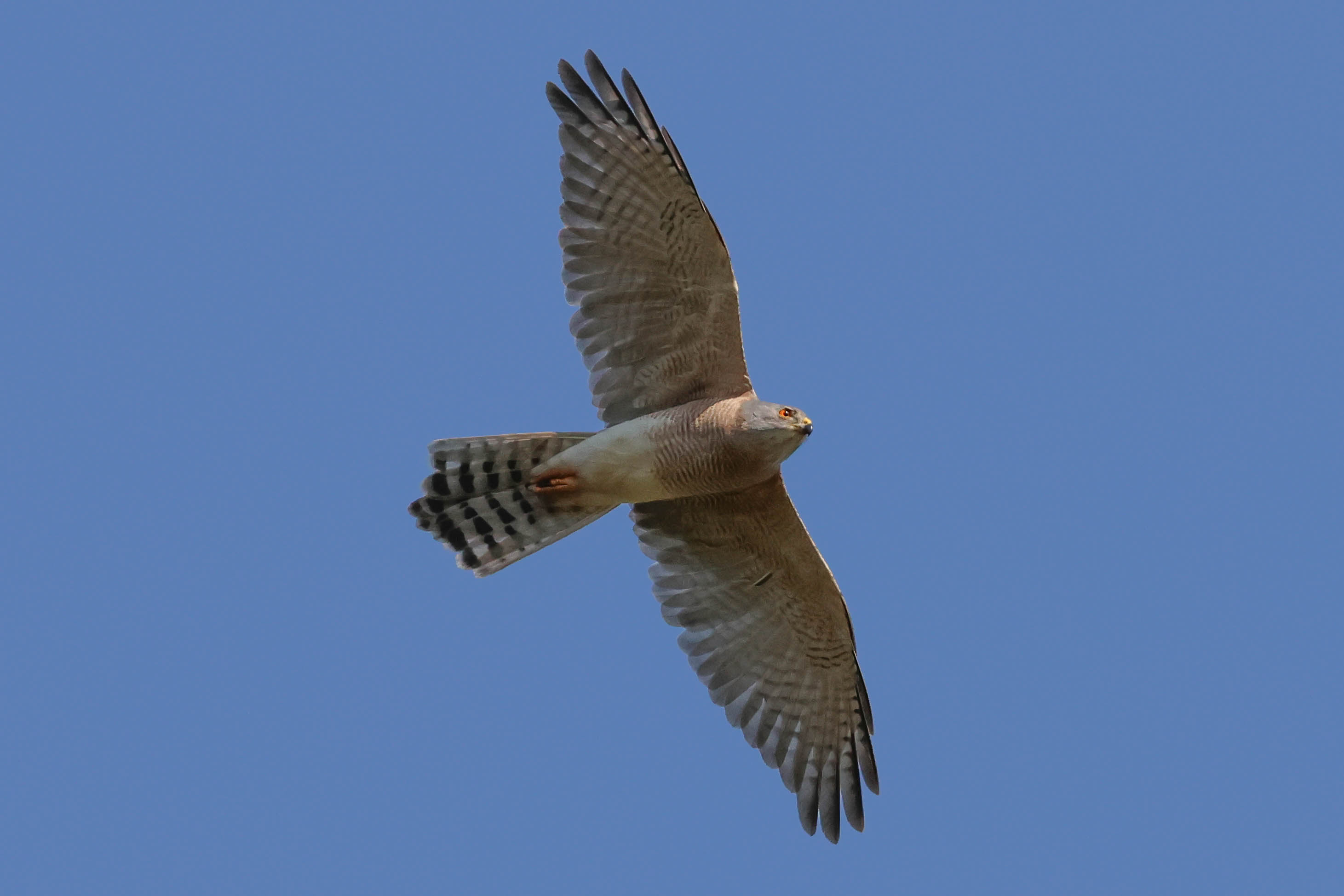
Back into the forest, Modou spotted a firefinch on the track, so we stopped to see if it might come out again. There was no further sign, but several other good birds did show themselves in the trees while we looked: African Paradise Flycatcher high in branches, Buff-spotted Woodpecker, Collared Sunbird and better views of Snowy-crowned Robin Chat. We walked back round to the drinking pots where we could get stop for a drink too. Several Red-billed Firefinches, Black-rumped Waxbills and Cordonbleus came in to drink and a Gambian Sun Squirrel was in the trees here now too.
Out into fields, a Blue-cheeked Bee-eater flew over briefly and we stopped to look at a Striped Kingfisher in one tree and a Dark Chanting Goshawk in another beyond. The latter flew across and dropped down to catch a lizard in the grass, then landed again in another tree further down the path. It flew off as we walked on, but then a Cardinal Woodpecker appeared instead and we watched it excavating a hole in a small dead branch in the same tree.
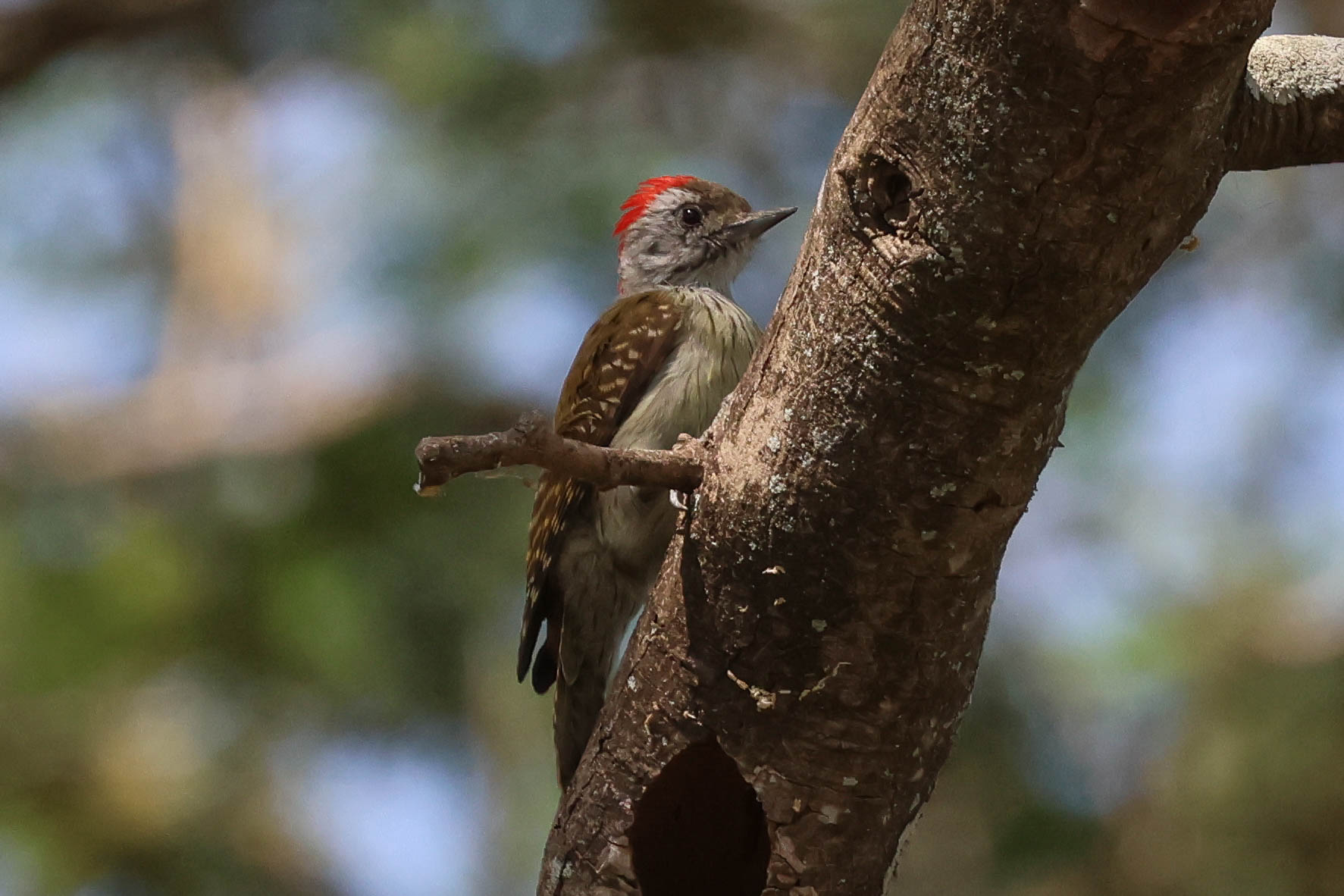
We cut across a now overgrown field which had apparently earlier been used to grow watermelons – they were in season and we saw watermelons for sale everywhere by the side of the road and had delicious watermelon most days for lunch! A couple of Northern Black Flycatchers flitted around in some trees as we passed. We picked up a Lanner away in the distance, which helpfully flew in and past us.

Then a Grasshopper Buzzard circled up over the forest beyond and again, helpfully came towards us and eventually right overhead. They are commoner upriver, more unusual here closer to the coast, so this was a really nice bonus to see.
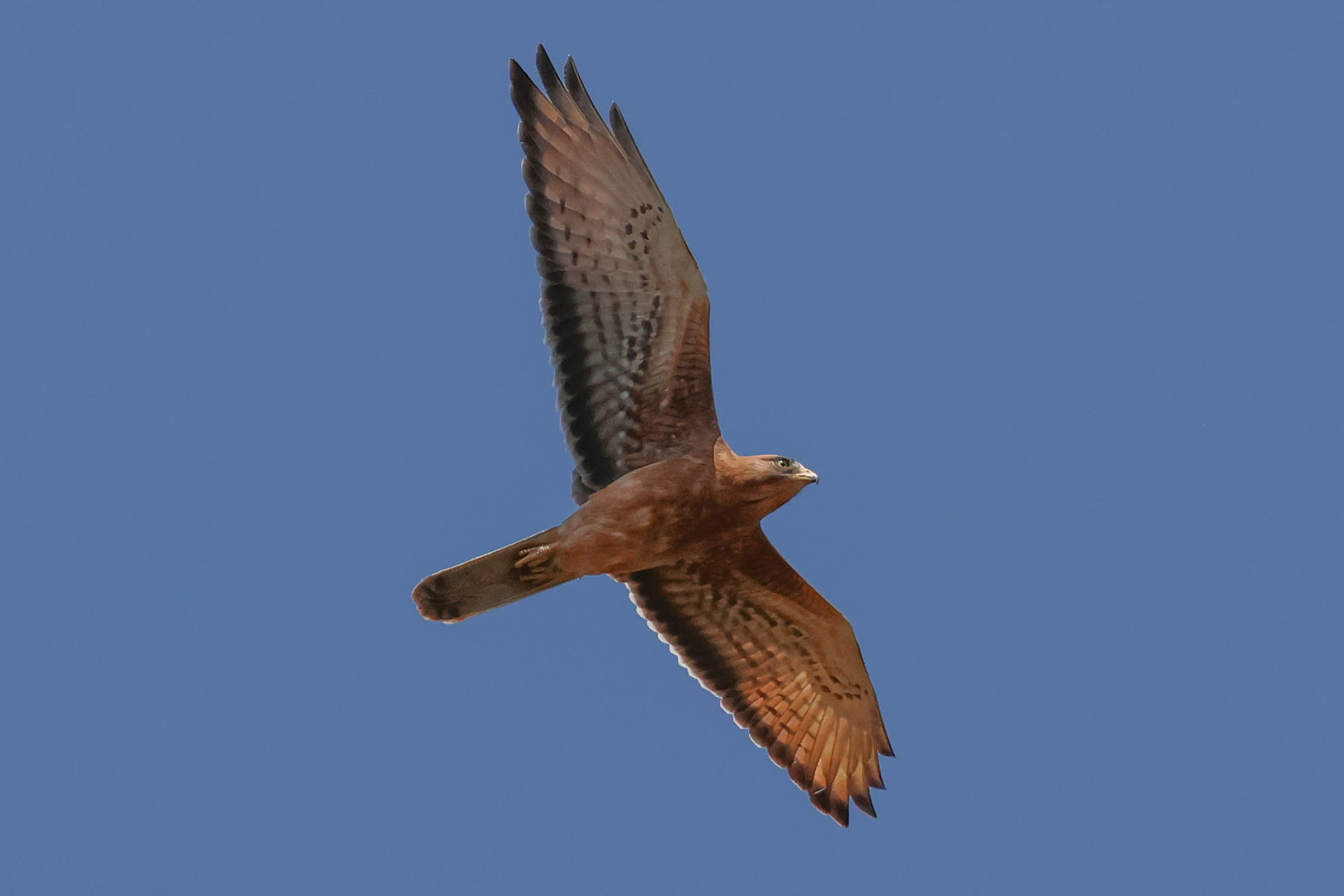
Cutting across the field and into the forest again, ‘Bob’ took us to where two Greyish Eagle Owls were roosting in the trees. They stared down at us as they had their photos taken and then we left them in peace to go back to sleep. The bus was waiting for us nearby and we had a short drive to another site in the forest with a hide and some drinking pools.
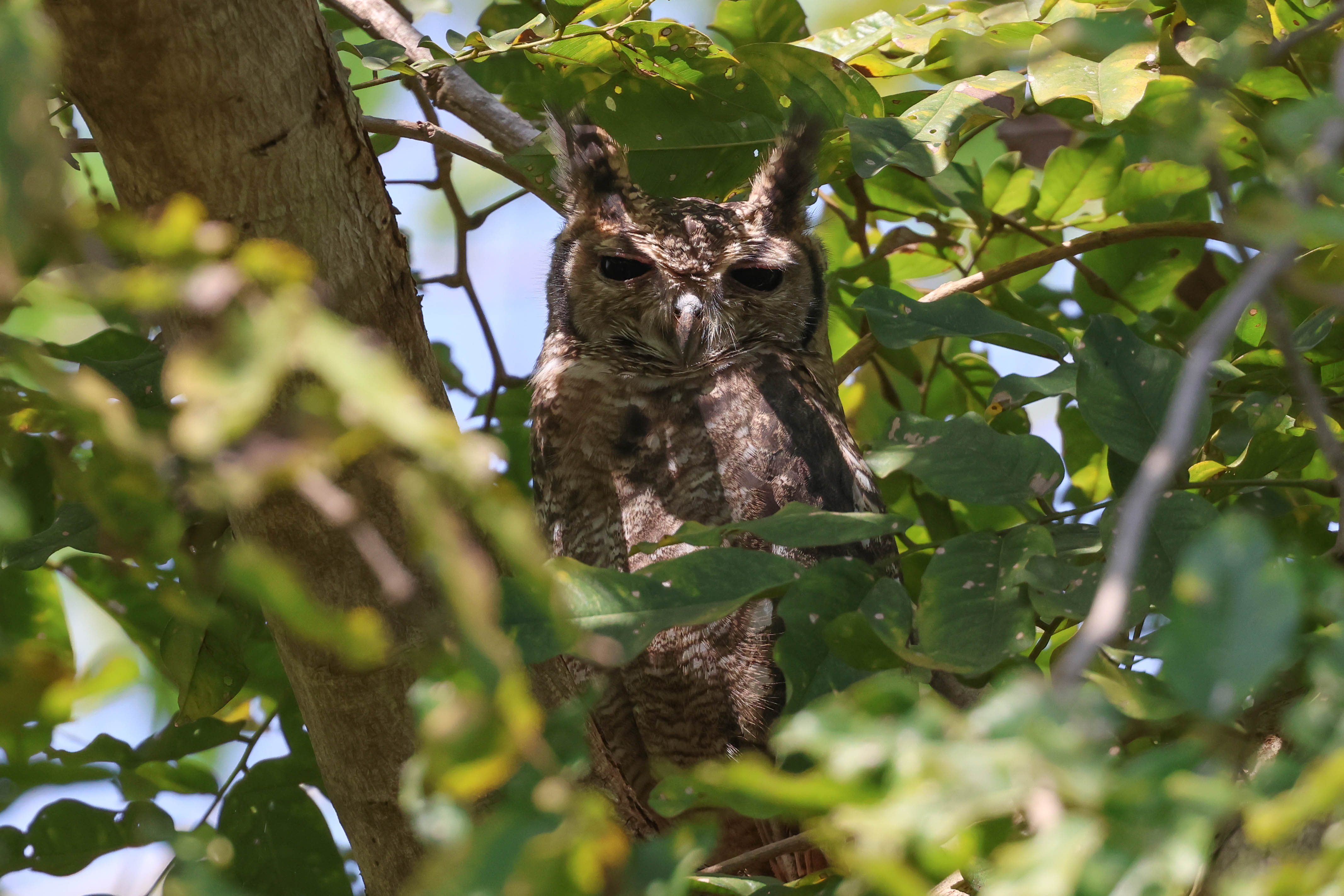
We were hoping for Spotted Honeyguide here, and one had apparently just been in, but despite waiting a while we didn’t manage to see one now. A Snowy-crowned Robin Chat was under the tree at the back and both Black-billed and Blue-spotted Wood Doves came in. We had to make do with a smart male Greater Honeyguide which came in to one of the pots for a drink. It was time for lunch, so we would come back and have another go here afterwards.
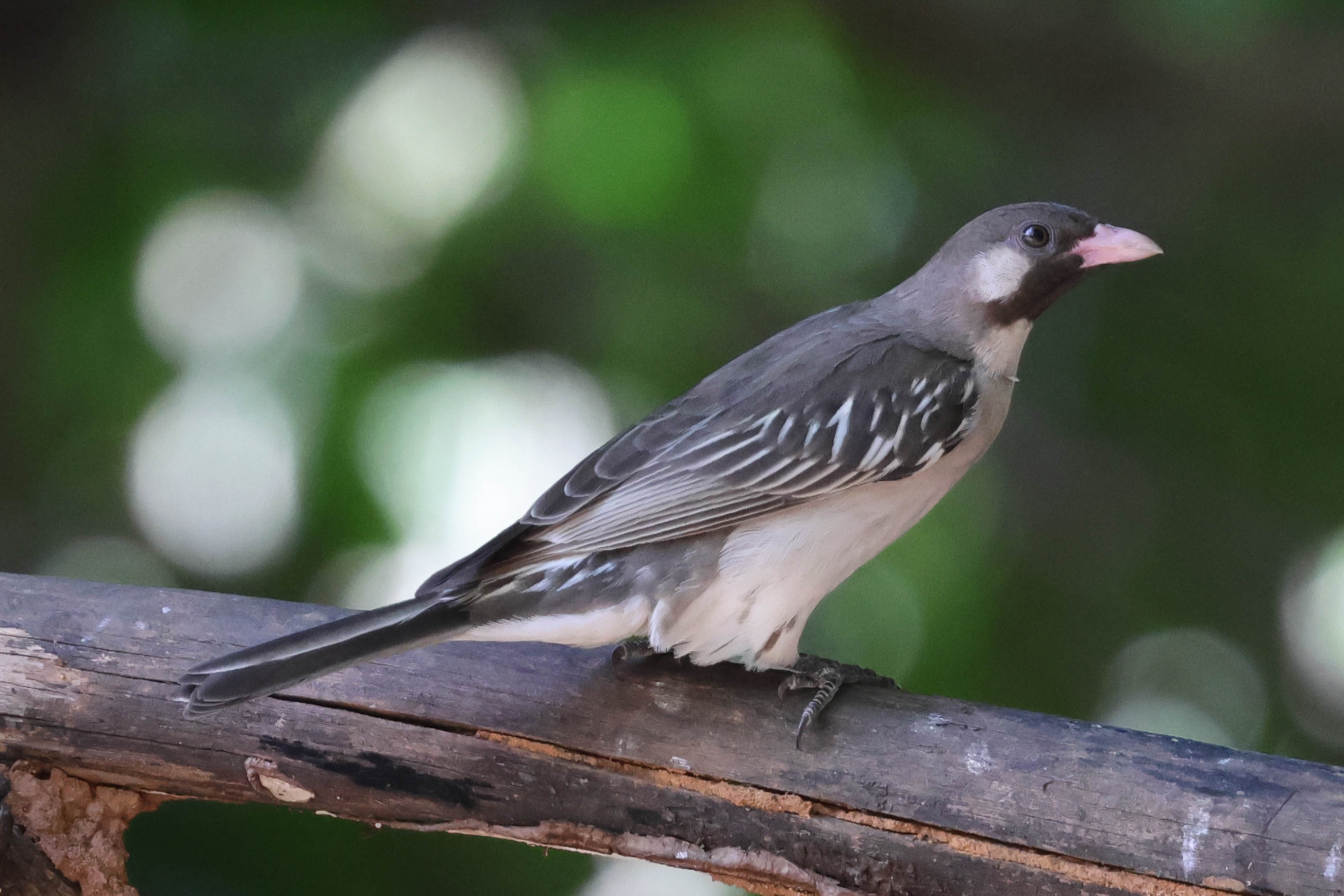
We were going over to Boabab Island for lunch, but we arrived to find that the jetty we were supposed to be using to board the boat had collapsed yesterday. Several men were now hastily attempting to finish cobbling together a new one. They appeared to have run out of planks and were now using some bamboo, which one of them was sawing to random sizes against his leg (no health and safety assessment here!).
It looked like we wouldn’t be getting lunch anytime soon at first, but remarkably quickly all things considered they made a structure which was just about passable, if a bit rickety (it would have taken years to get a new jetty erected back in the UK). While we were waiting, six Yellow-billed Storks flew past and we whiled away the minutes watching all the Mudskippers flipping around on the mud below.
Unfortunately, it was low tide now, so the boatmen couldn’t use the larger boat with an outboard and instead, they had to use a flotilla of small boats to get us across. The first two volunteers went over on a pedalo with one of the boatmen, although they possibly didn’t realise what they had volunteered for and their attempts to help with the transit resulted in the pedalo circling round and round several times at first!
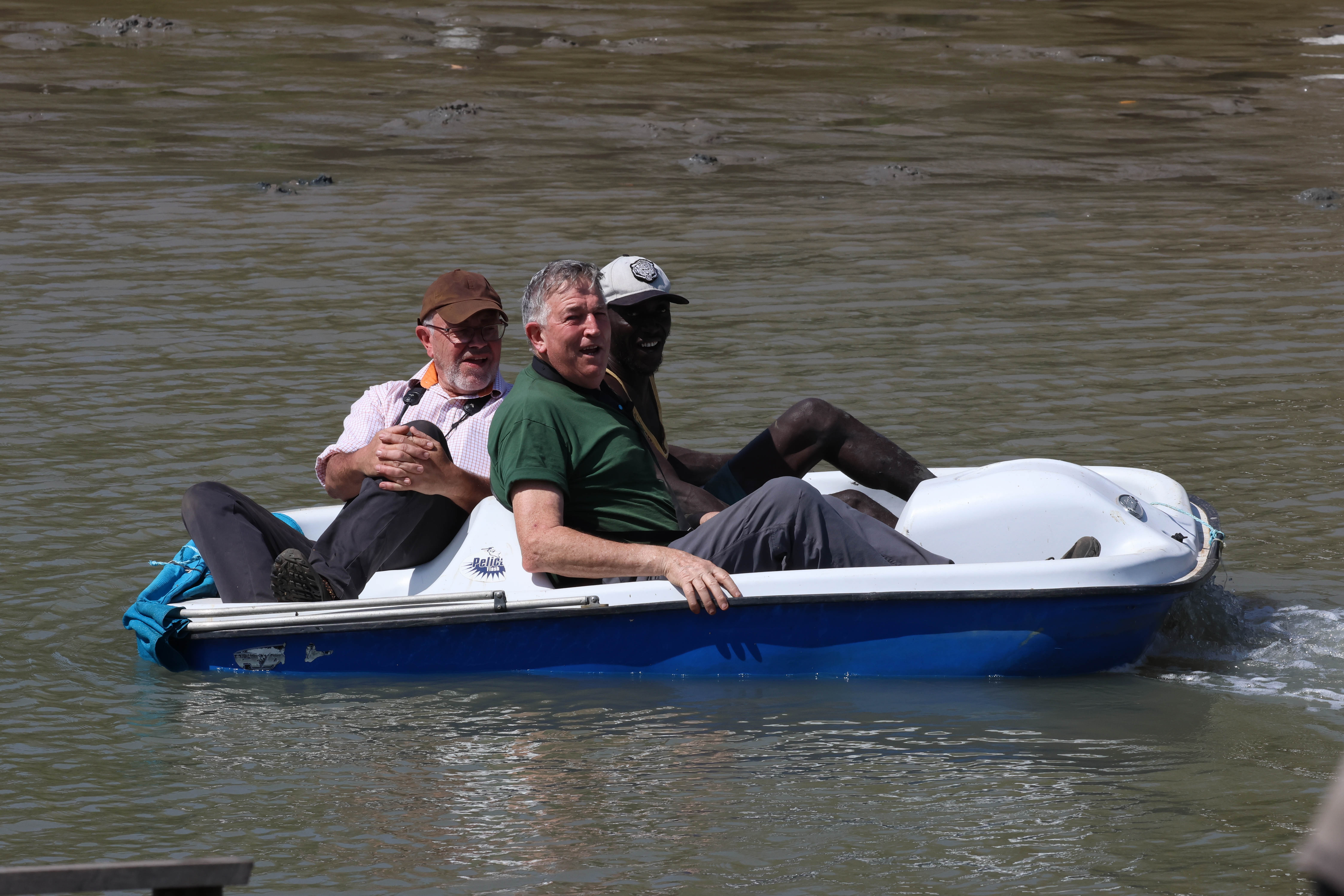
Another two went over by dugout, before the boatmen realised they could use one of the slightly larger boats and push it up the channel if one of them waded in. Finally we all managed to get over for lunch. Several Mauritian Tomb Bats were roosting in the roof of the main lodge.
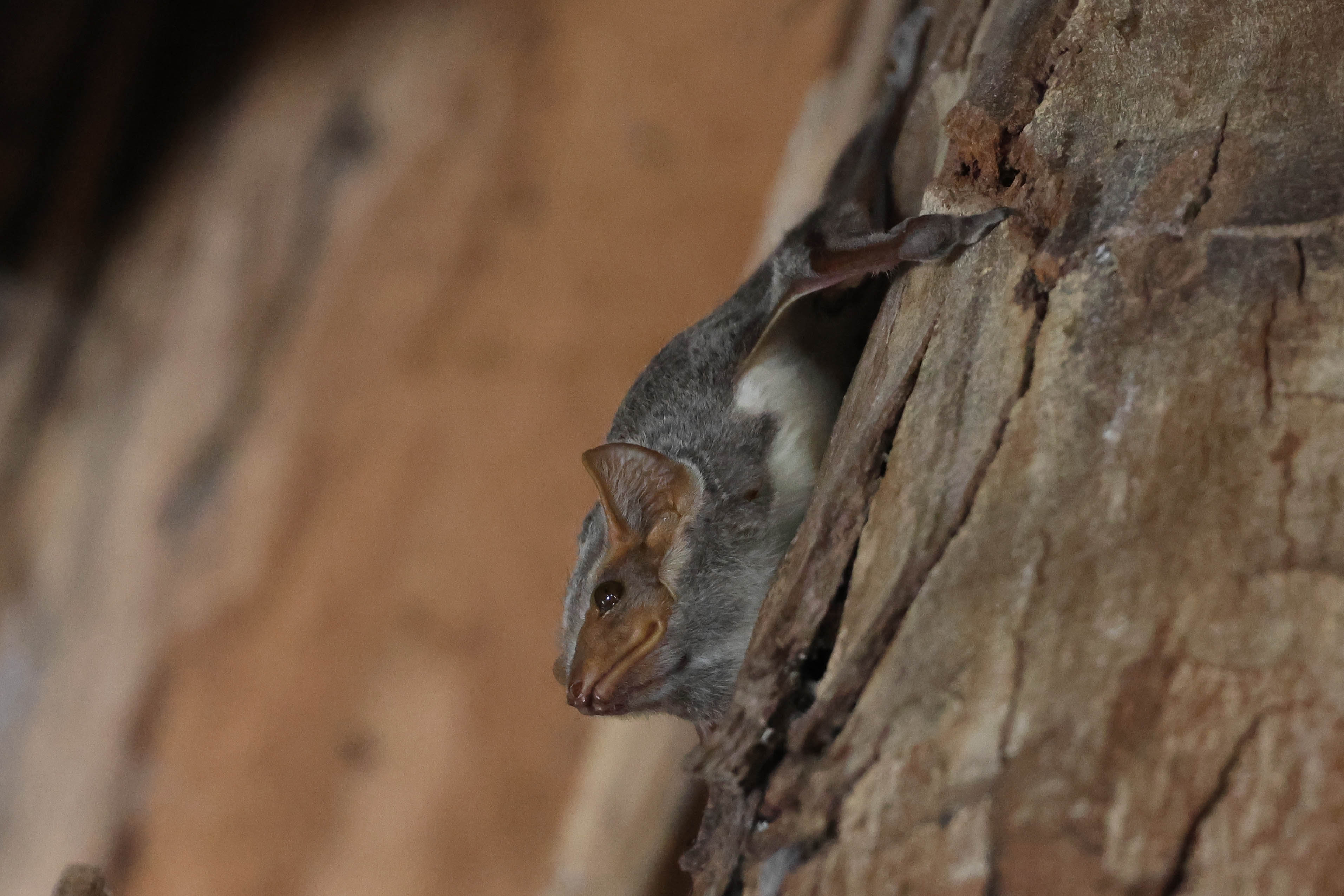
After another delicious buffet of local food was prepared, well worth the effort required to get over here, and afterwards we had enough time for a quick walk round the island. A Bearded Barbet flew across and landed briefly, but was off again before everyone could get to see it through the scope. Two Lesser Honeyguides were chasing round a tall tree.
Time was getting on and we still needed to get back across the channel to the mainland. From the jetty this side, we could see a group of Wattled Lapwings on the mud opposite, the first we had seen properly on the ground, along with several Senegal Thick-knees. The tide was slowly rising, so thankfully we could all get back on the slightly bigger boat now. On the way back, we saw Striated Heron and a Common Redshank on the edge of the mangroves. Five Yellow-billed Storks flew back the other way.
It was just a short bus ride back to the hide and drinking pots. There was a lot more activity here now, lots of weavers, doves and Common Bulbuls coming in to drink, along with Lavender Waxbills and a pair of Yellow-fronted Canaries. A couple of African Pygmy Kingfishers flew in repeatedly and splashed into one of the pools to bathe. Several Red-bellied Paradise Flycatchers were in the trees together with one hybrid African x Red-bellied with black spotting on its breast. A male Common Redstart was feeding under the trees at the back now, along with a pair of Brown-throated Wattle-eyes.

Eventually, the owner saw a Spotted Honeyguide fly in to the trees above the hide and we went out in turns to look at it through the scope. It was rather nervous, and reluctant to come down – eventually it did drop down onto the branch by its favoured pot briefly, but after a minute flew back up into the trees.
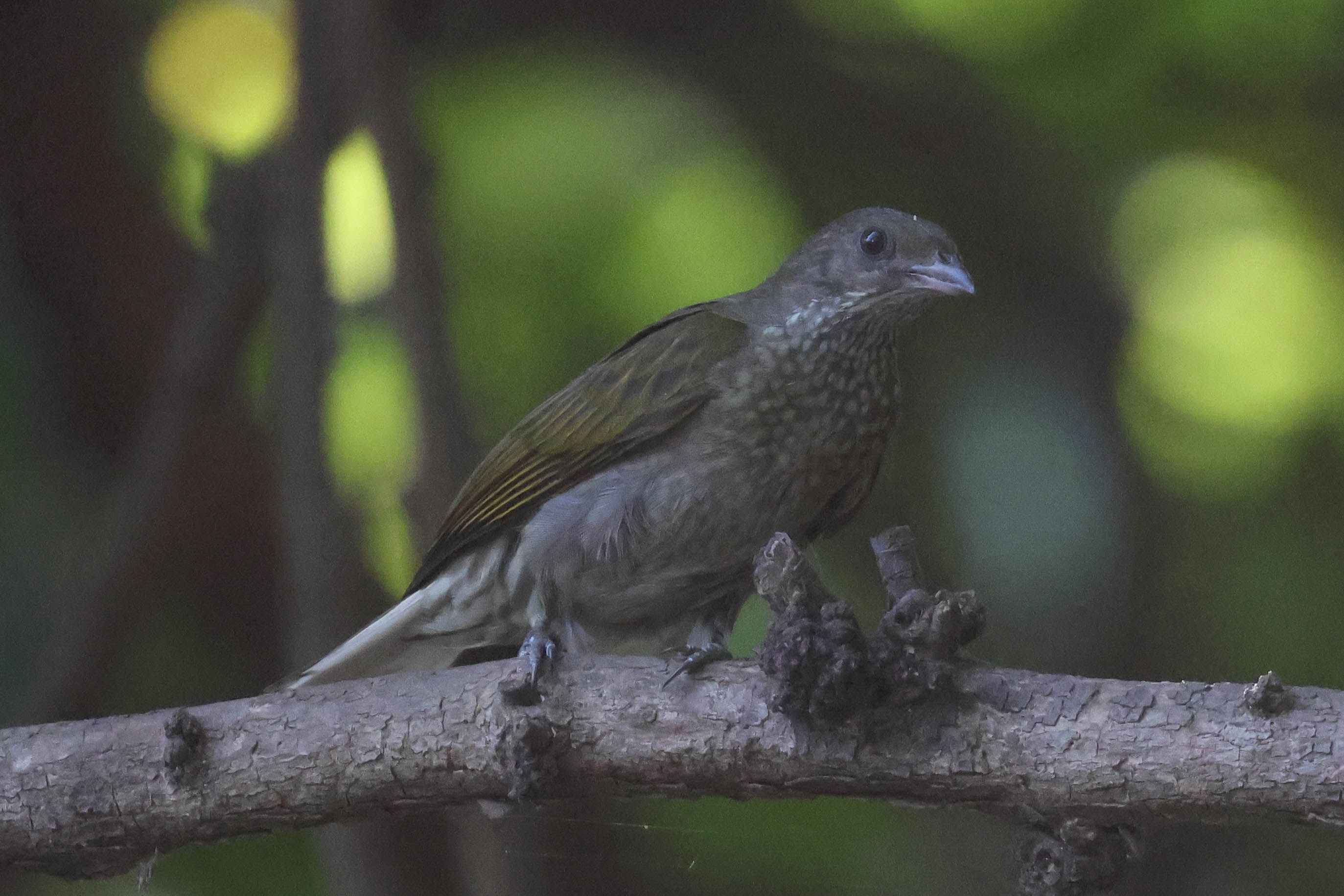
Unfortunately we were out of time, as we had a long drive back to the hotel. On the way back towards the main road, an Abyssinian Roller was perched on a half built building on the edge of the village. A nice end to another action-packed day.
Tuesday 22nd November
It was a longer drive again this morning, down to Pirang. As we set off along the track into the old shrimp farm, an African Crake started calling from the overgrown pool alongside but unfortunately remained well hidden.
We hadn’t seen many up to now, but here there were lots of swallows overhead. Most were West African Swallows (formerly the local race of Red-rumped, now a separate species) but a pair of Mosque Swallows were circling with them and a Rufous-chested Swallow and a House Martin flew through. Turning onto a smaller, overgrown path, we flushed our first Namaqua Dove from the bushes.

There was a nice selection of waders on the first pool – Avocets, Black-winged Stilts, Ruff, Ringed Plover, Grey Plover, Greenshank and a single Wood Sandpiper. A pair of Crested Larks were feeding on the bund ahead of us and several Western Yellow Wagtails flew back and forth calling. More wintering Palearctic migrants. When first a nice male Yellow Wagtail landed on the track ahead of us, we could see it was Iberian (subspecies iberiae), and it gave a slightly raspier call as it flew off too, later a British male (subspecies flavissima) landed on the mud.
A Subalpine Warbler flitted in and out of the bushes ahead of us and we found another two and a Chiffchaff further along. We flushed a Double-spurred Francolin from the bund as we walked along and lots of Crimson Speckled moths flew up from the grass, a rare migrant back home.
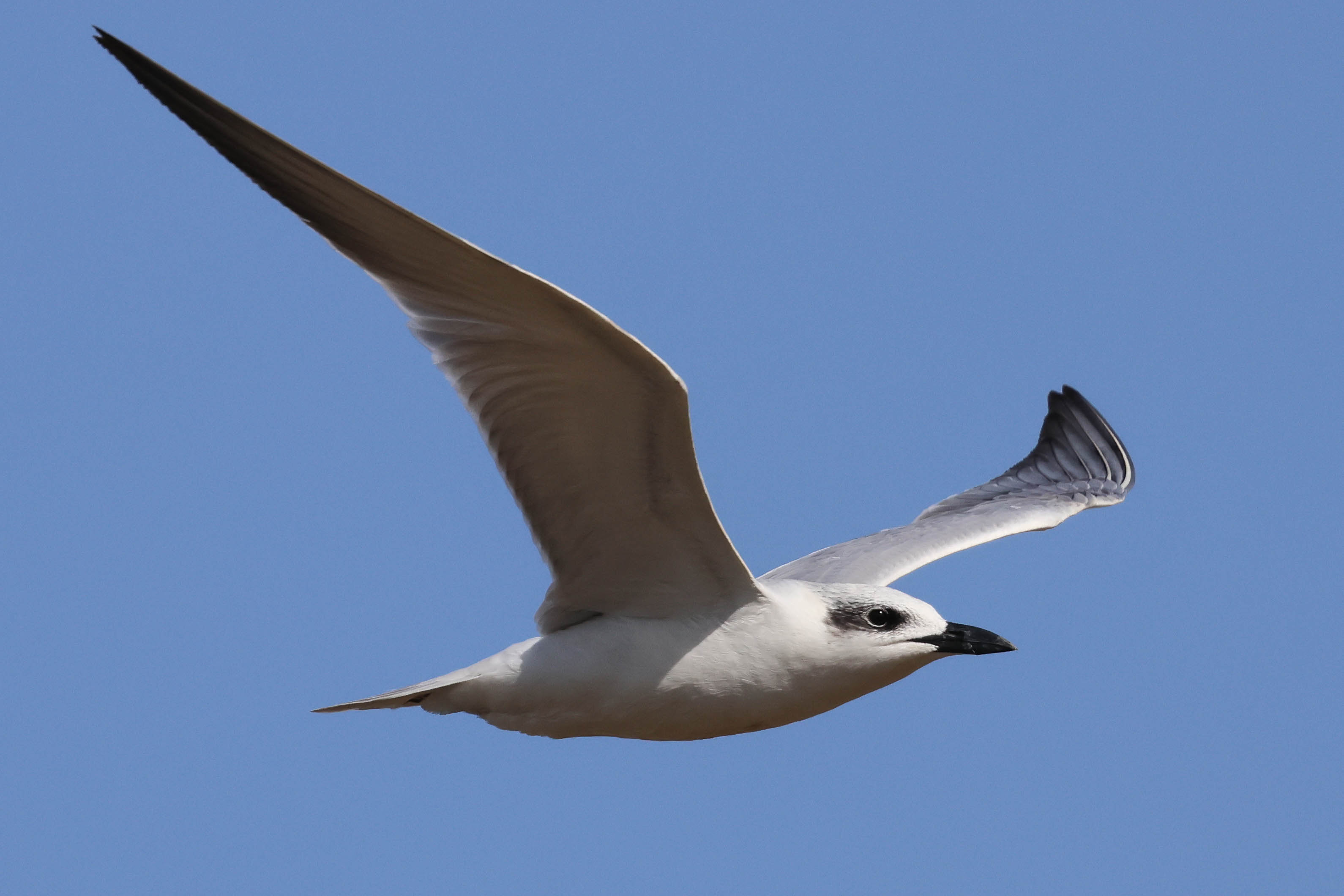
A couple of Little Terns were fishing over the pools close to the path and several Gull-billed Terns flew in and right past us. A Pied Kingfisher seemed to be following us, and hovered next to us several times. When a large flock of birds flushed in the distance by someone walking round the pools, we looked up to see a mixture of spoonbills, Yellow-billed Storks and Pink-backed Pelicans.
The next shallow pools were full of small waders mostly Little Stints and Curlew Sandpipers and significantly outnumbering the Dunlin, the reverse of what we usually see back home in the UK. We would see really impressive numbers of small waders as we made our way round. A Marsh Sandpiper dropped in, and we found a few Black-tailed Godwits and lots of Whimbrel here too. A small group of Greater Flamingoes were standing around in the middle, dwarfing the tiny waders around them.

Further up, on an island in the wide channel the other side of the bund we could see a few White-faced Whistling Ducks and a West African Crocodile which had hauled itself out onto the mud. By the time we got up there, the croc had retreated to the water, but from here we could see a Kittlitz’s Plover on the mud just beyond.
On the next pool, there were good numbers of Northern Shoveler and a large mixed flock of roosting gulls and terns – mostly Caspian and African Royal Terns, with one or two Sandwich and a single Lesser Crested Tern with them. The gulls were mostly Slender-billed Gulls with a smaller number of Grey-headed Gulls. There were some larger birds standing in with them – a spoonbill sandwich, with a single Eurasian Spoonbill in the middle flanked by two African Spoonbills giving us a nice comparison, and a lone Pink-backed Pelican.
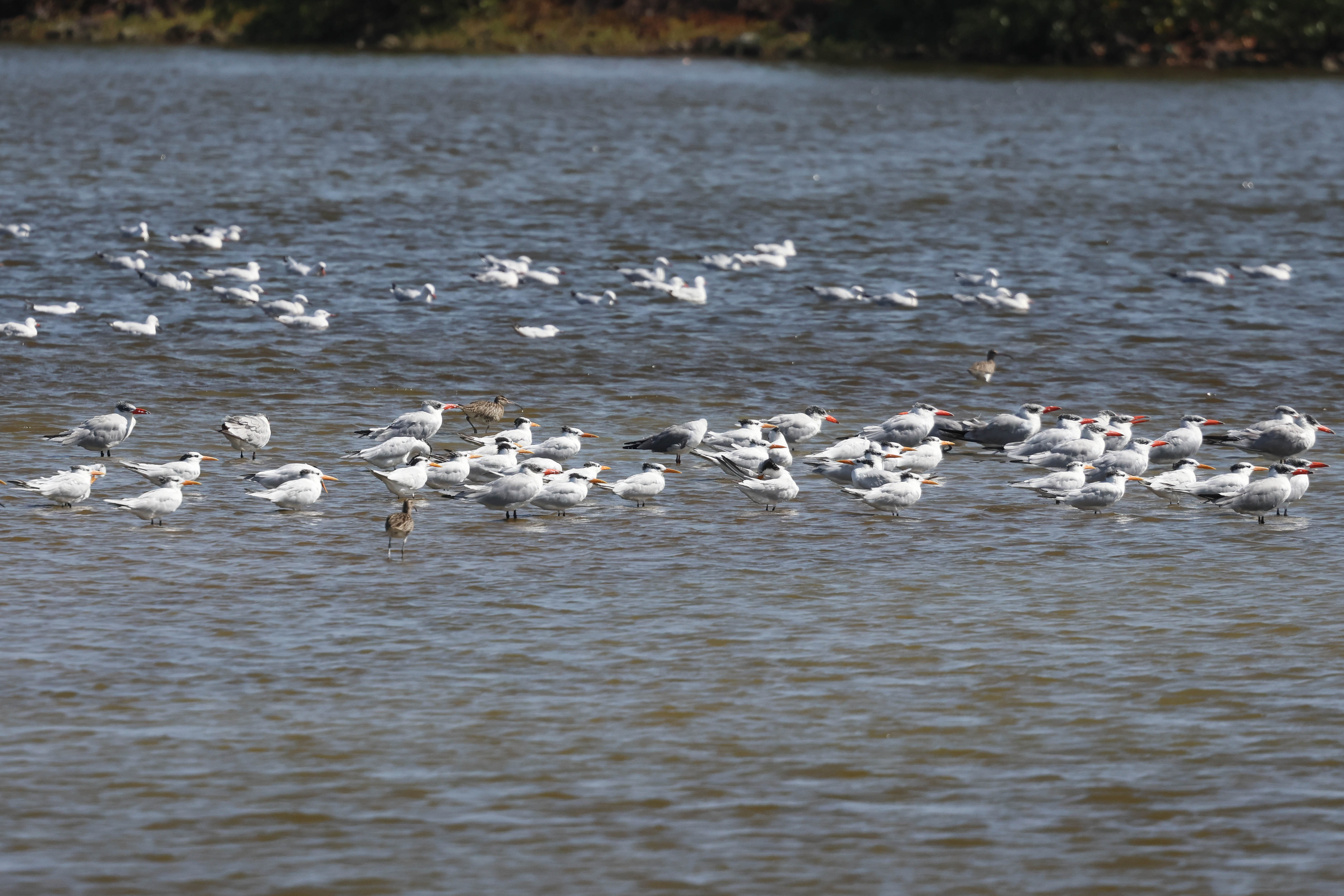
Further up, we could hear Blue-cheeked Bee-eaters calling and looked over to see several flying across the back of the pool. Modou picked up a single White-throated Bee-eater too, perched in a tree right over the other side, which everyone eventually managed to make out in the scopes. Small groups of swifts hawked overhead, a mixture of Little Swift and Pallid Swift, and an Osprey flew over.
There were more huge flocks of waders as made way back across. In with the stints and Curlew Sandpipers, we picked out one or two Knot and Ruddy Turnstone. As well as Ringed Plover there were several Kentish Plovers on the mud this side too but scanning through we were more surprised to find a single White-fronted Plover with them. They are normally only seen on the coast and it seems that this was perhaps the first one ever to be found here. We were just watching the plover when a Collared Pratincole flew over behind us and we didn’t quite know which way to look!
Continuing on, a young Palm Nut Vulture drifted right across in front of us. A Northern Wheatear was hiding around the small bushes on the edge of the mud. We could easily spend all day here, but it was already the middle of the day and we had more to do. We were met by the bus and drove back out of the shrimp farm.
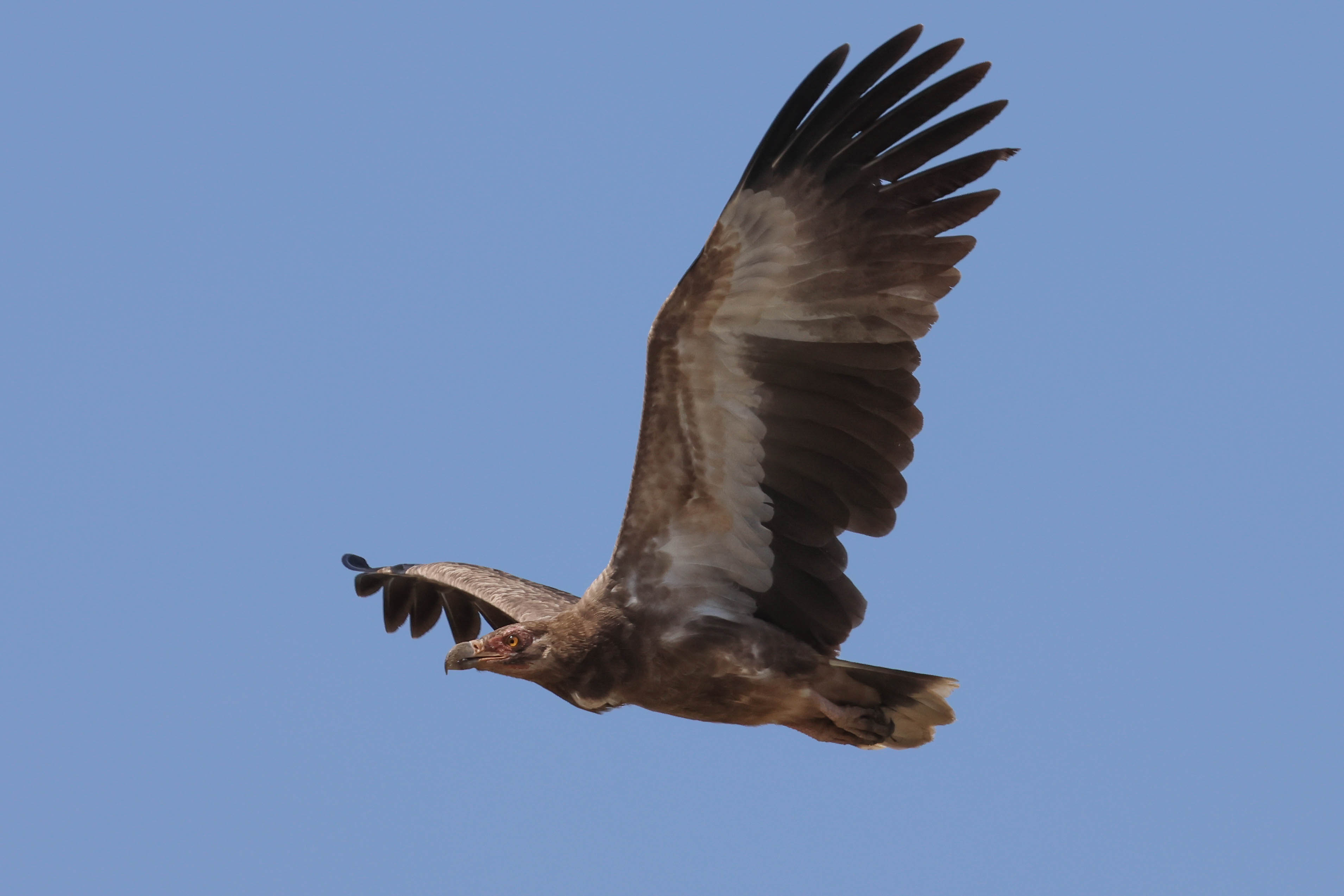
Unfortunately, we were unable to go to the usual venue for lunch today as they had cancelled on us and the alternative restaurant was quite a drive away. We still needed to visit the nearby Bonto Forest and this meant it would be a quick stop here and then a late lunch.
We were met at the entrance by one of the forest guides, who took us straight in to look for White-spotted Flufftail. A very secretive species, they can be hit and miss here but he eventually managed to whistle one in for us and we watched it creeping around deep under the trees. A Green Hylia appeared briefly right overhead just as we were watching the Flufftail and had unfortunately disappeared when we turned our attention back to looking for it.
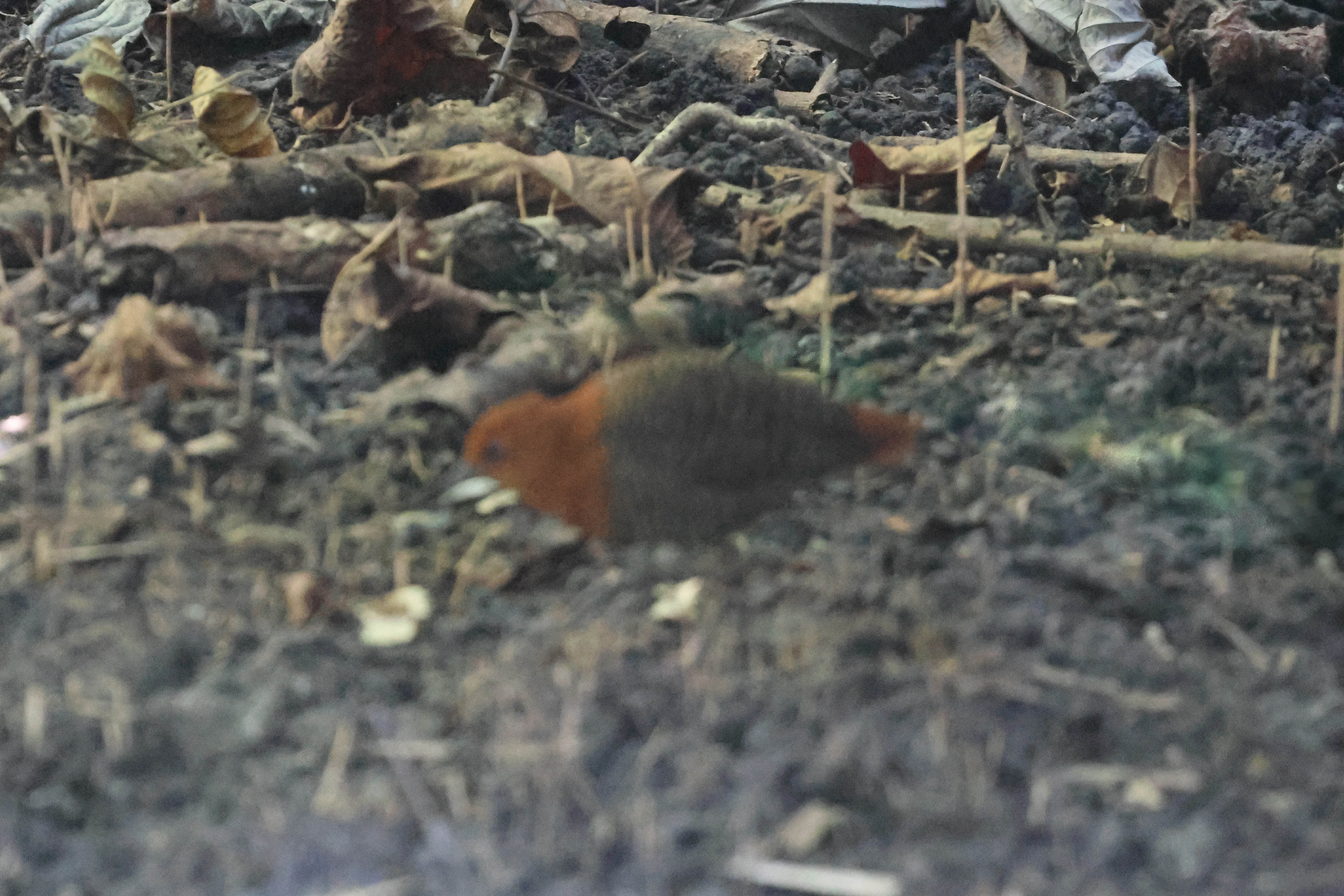
On the walk back out to the main track, we stopped to look at a Green Turaco high in the canopy above. Then we turned down another narrow path and after what was possibly a little over the advertised 200m (Gambian metres!), we were pointed to a Verreaux’s Eagle Owl roosting high in the trees. We had great views of it through the scopes and the chance to admire its distinctive pink eyelids.
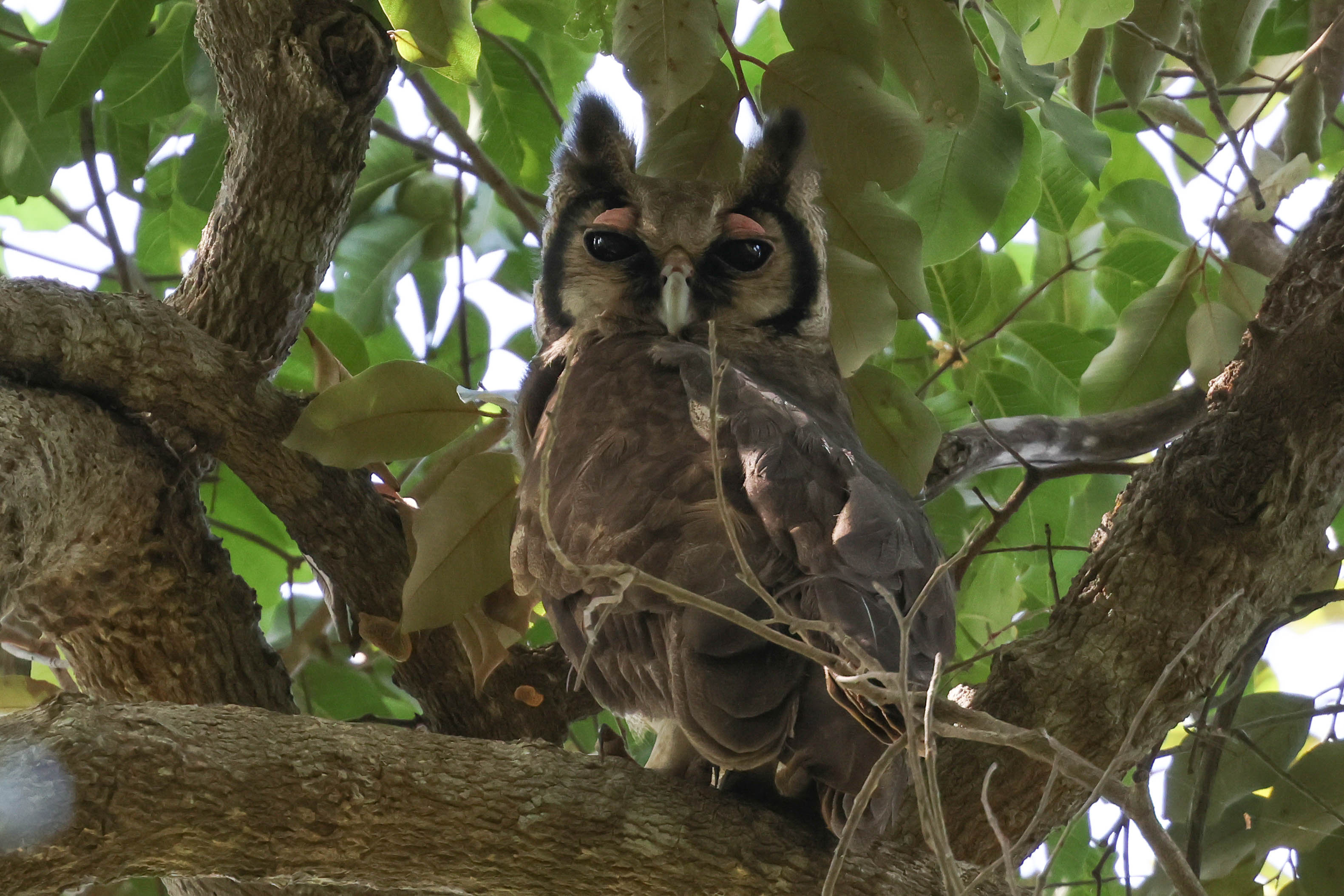
Unfortunately there just wasn’t time now to explore the forest further, and after the best part of an hour’s drive to Marakissa River Camp it was then a very late lunch – more like high tea! It was nice to sit down with a cold drink overlooking the river, where a Pied Kingfisher appeared on a post with a fish and a West African Crocodile surfaced briefly.
After another delicious lunch of fish, chicken and fried vegetables with rice and peanut sauce, we walked out to the road. A Violet Turaco was feeding in the tree opposite and several African Green Pigeons were in the top of a fruit tree a little further along, even if they were at times difficult to see, very well camouflaged in all the green leaves.

Continuing on down towards the bridge, we scanned the pools – a Black Heron was doing its umbrella fishing and there were several Black Crakes and African Jacanas. We saw our first Intermediate Egret, along with a couple of Squacco Heron, and a colony of Cattle Egrets in the trees behind. An African Darter flew over, and a Common Snipe flew past.
A couple of African Grey Hornbills flew in and landed in the afternoon sunlight right behind to us and a Blue-breasted Kingfisher landed in a dead tree the other side.
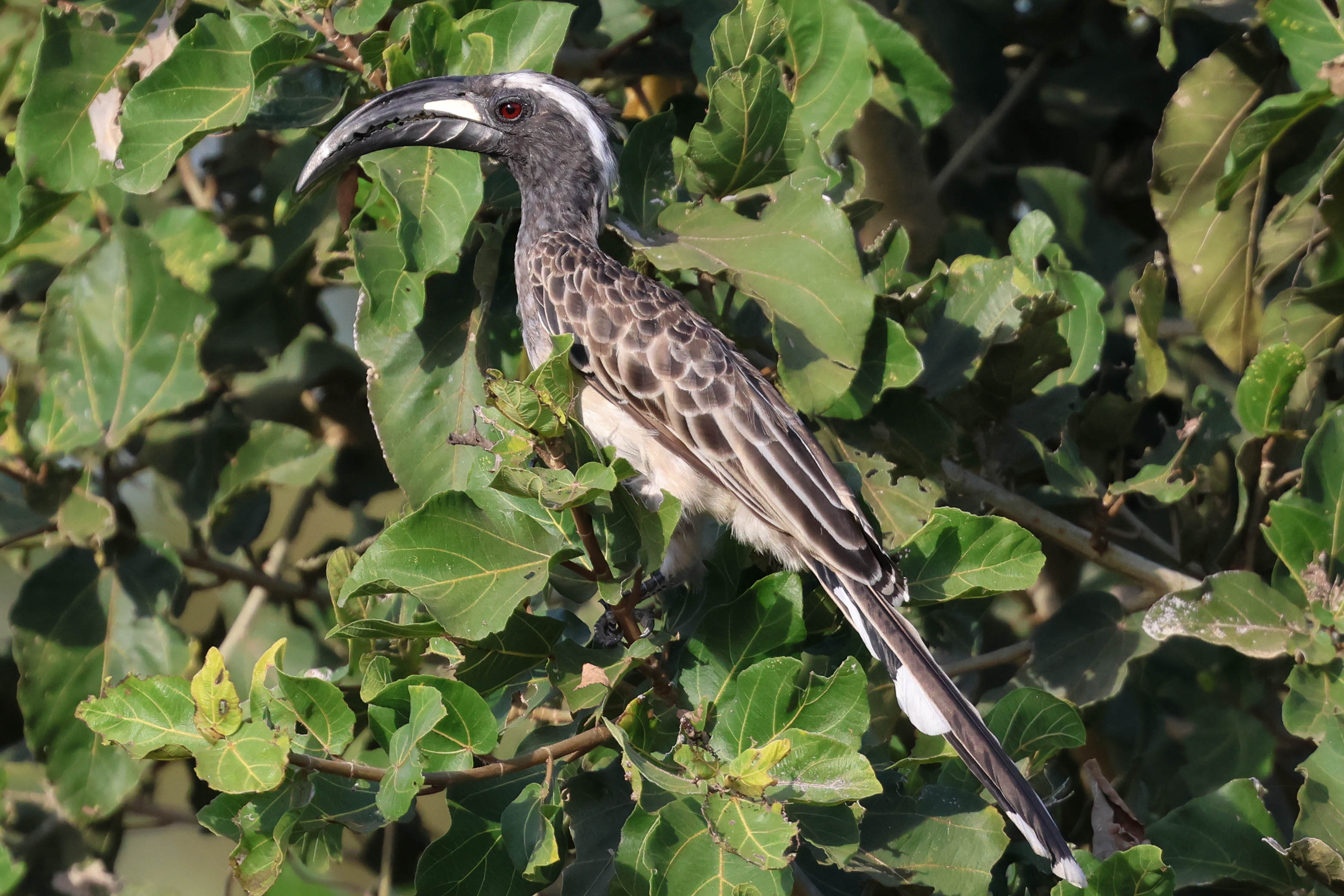
Unfortunately, we were out of time again. As we walked back along the road an Ovambo Sparrowhawk flew across the fields and landed in the top of a tree where we could get it in the scopes. A couple of Blue-bellied Rollers were in the small trees opposite the entrance to the camp now.

There was one last surprise waiting for us back at the camp. The crocodile was waiting in the water just behind where we had eaten lunch earlier and when the owner started calling, ‘crockie, crockie’, it came straight out of the water and up onto the bank right in front of us. Thankfully it was more interested in the chicken it was being fed than us, but it was quite a thing to stand right there and watch.
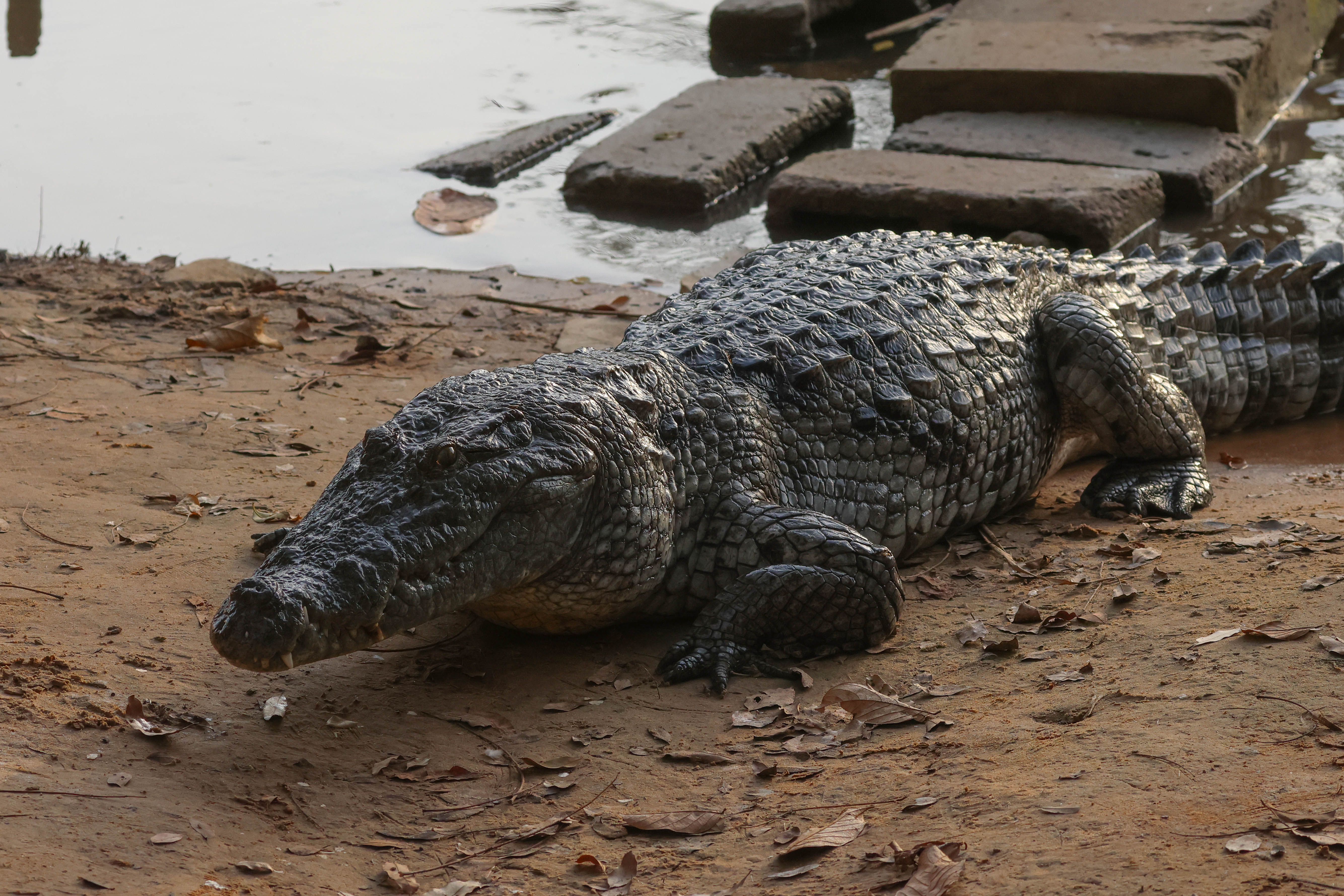
It was a long drive back and the traffic was even worse than normal tonight. Our driver tried everything he could to get round the congestion, turning down small dirt roads through houses and shops, but there were a couple of vehicles broken down, and others blocking the small roads. At one point we hit complete gridlock and it meant we were late back tonight. The new airport road cannot be finished soon enough!
Wednesday 23rd November
It was an extra early start this morning, leaving before breakfast, as we were driving down to Kartong, close to the Senegal border. On the upside, it did mean we beat the traffic and had a smooth run down. It was getting light as we got to Kartong and several Hooded Vultures were still sitting around in the middle of the road, although they were nearly mown down by a speeding taxi.
It was still quite cool as we got out of the bus, with a fresh breeze blowing this morning. There were lots of Squacco Herons and Cattle Egrets around the pools and a pair of African Silverbills flew off from beside the path as we walked through the houses to Kartong Bird Observatory. Here we were met by Colin Cross and his wife and ushered out onto the terrace where we were served tea and coffee and ate the packed breakfasts we had brought from the hotel while Colin talked to us about the history of the Bird Observatory. Several Marsh Harriers and Ospreys circled over the marsh in front and those who had not stayed to listen to the talk saw a Rufous-crowned Roller.
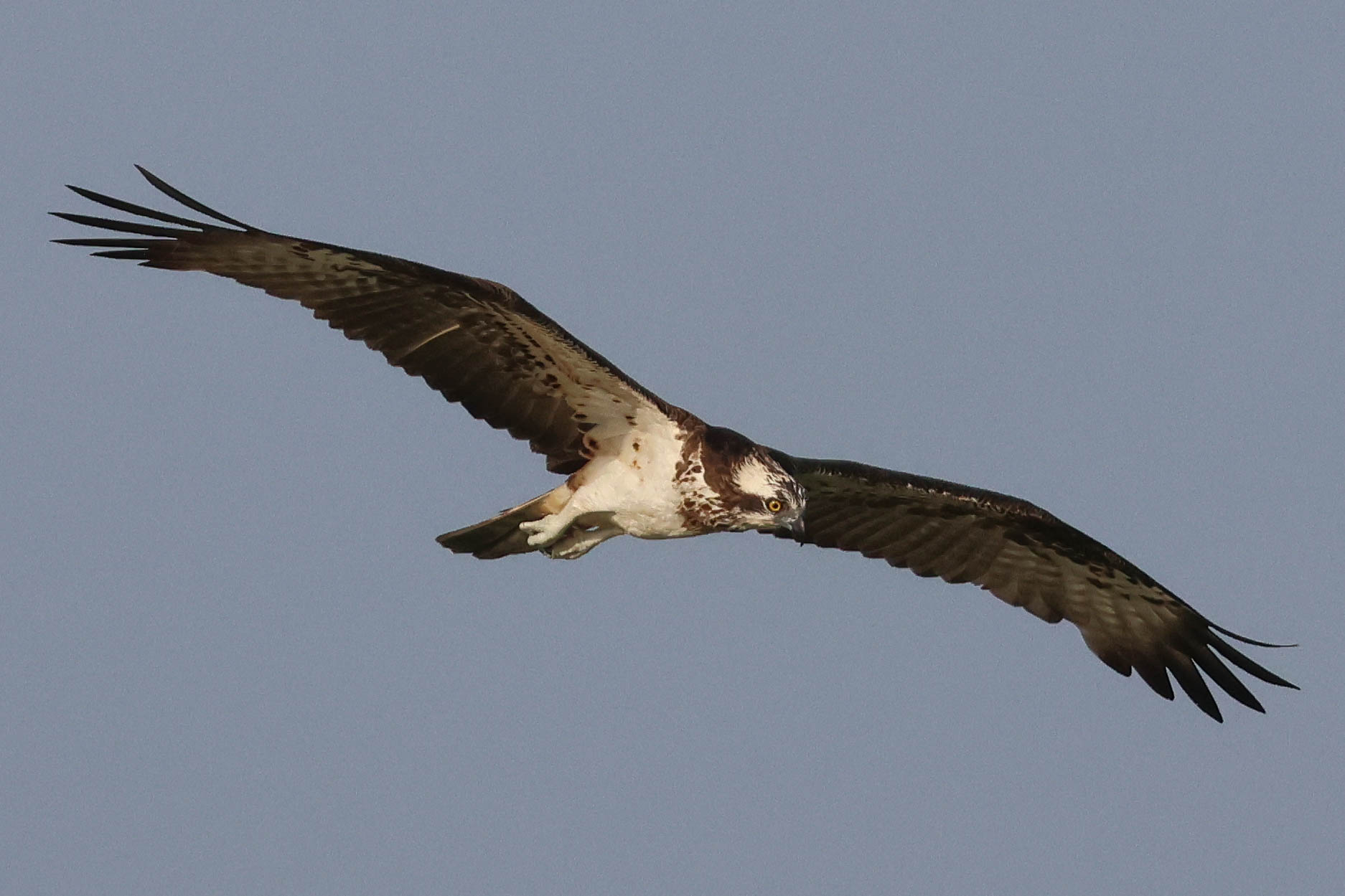
After breakfast, we walked back out to the track and down through the old sandpits. There were lots of White-faced Ducks on the pools, along with several African Jacanas and a remarkable number of Pied Kingfishers perched on just about every bush. A single Little Grebe was out on the water and a young Lesser Moorhen flew across. A few Pink-backed Pelicans and African Spoonbills flew over, along with a lone Spur-winged Goose. Two Red-necked Falcons flew past in front of us and a female Namaqua Dove was feeding on the track.
We turned off the track and cut across into the acacia scrub beyond. We had seen several flying round on previous days but a Citrus Swallowtail finally posed for us in the vegetation now, probably still warming up.
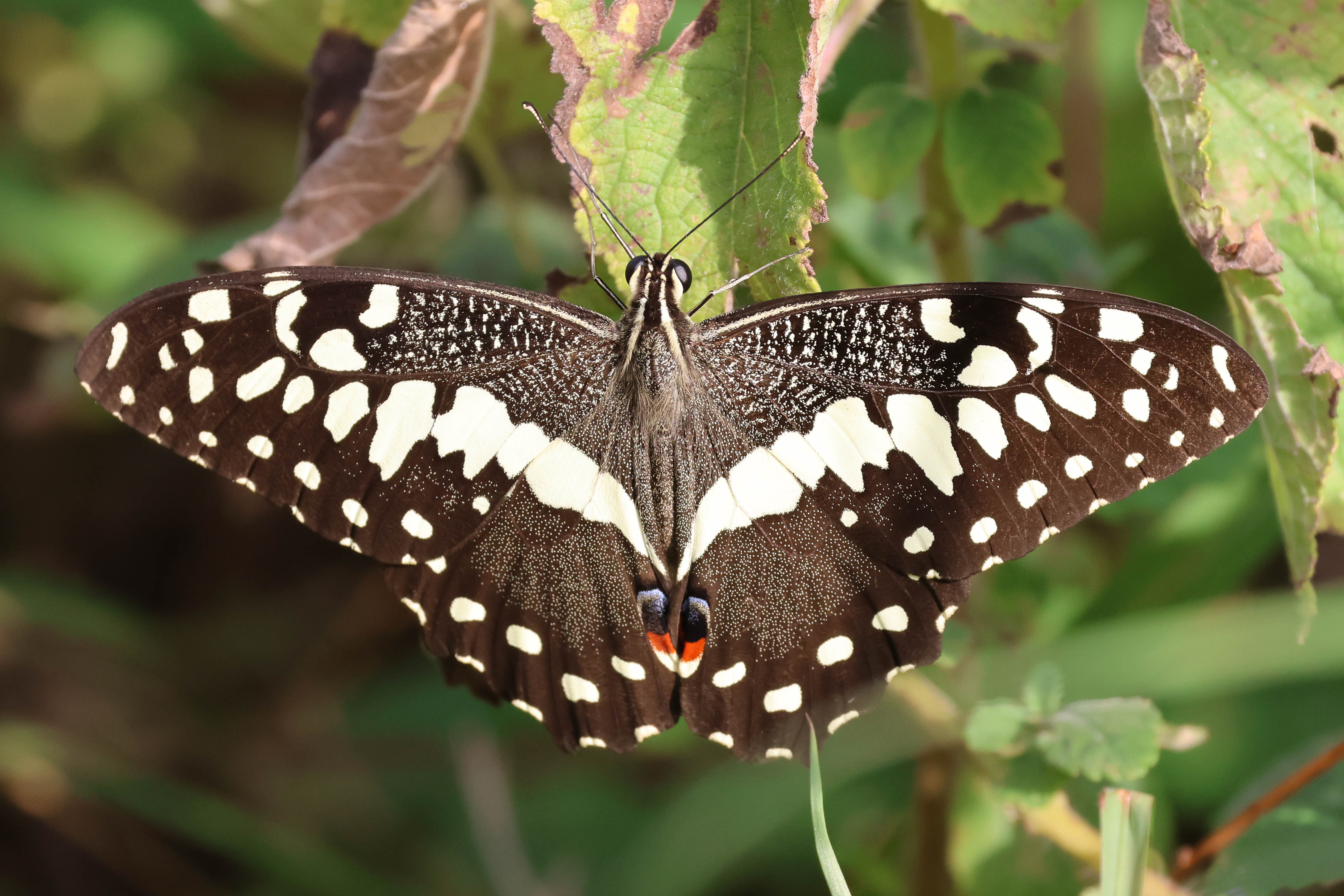
We first flushed a Tree Pipit which flew up from the ground and landed in a tree briefly, and then a couple of British Yellow Wagtails and several Plain-backed Pipits too, one or two of which perched nicely for us to get in the scopes.
There were lots of birds in the acacia trees – Splendid Sunbird, Northern Crombec, Senegal Eremomela, a smart pair of Yellow-crowned Gonoleks. We could hear Vieillot’s Barbet calling, but it was distant and didn’t come in to Modou’s whistled imitation of its call. A couple of Abyssinian Rollers were in the bushes nearby and were more obliging for the photographers.

Continuing on, we skirted round some shallow pools in the grass. There were lots of Spur-winged Lapwings and a couple of Wattled Lapwings with them on the first and the second looked fairly empty as we approached until a Dwarf Bittern came up in front of us from the near edge. It flew away and round behind some bushes ahead of us where it appeared to be dropping down, so we walked over to see if we could find it, but unfortunately there was no further sign.
Modou had been whistling Vieillot’s Barbet on and off all the way round and when we stopped to admire a Black-crowned Tchagra in the top of a nearby bush, a Vieillot’s Barbet started calling again. It was closer this time and flew in and landed in the top of the trees neat to us. Persistence pays off! A Senegal Batis was in a nearby acacia, along with a Woodchat Shrike, and Olivaceous and Melodious Warblers all in same tree. A Nightingale called from the undergrowth behind.
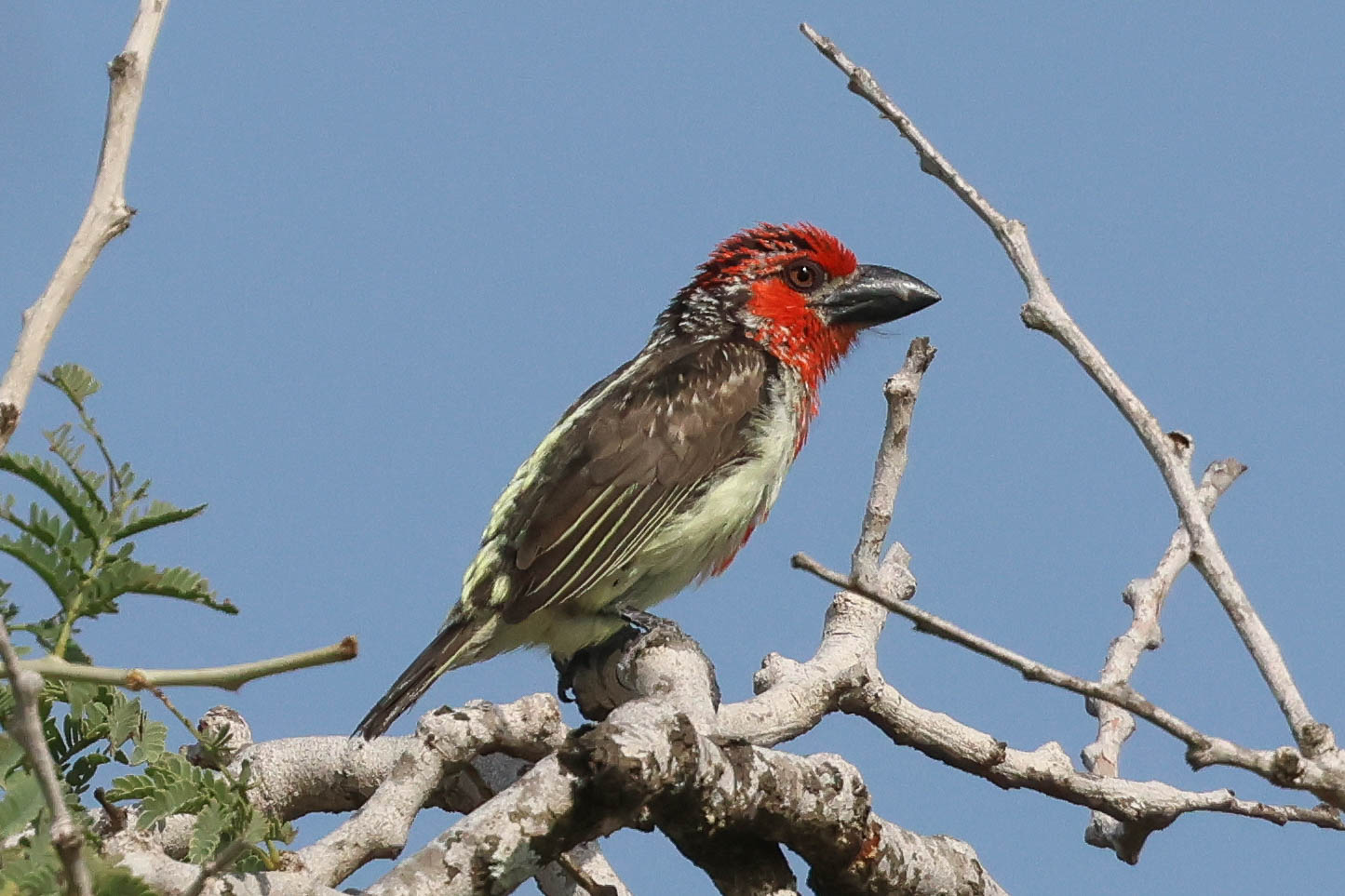
As we made our way back out onto the main track, a European Turtle Dove flushed ahead of us and landed and briefly in a tree. Walking on down towards the beach, a small flock of Red-billed Quelea appeared in the bushes along with a Western Orphean Warbler briefly. After the walk, it was nice to take a break in the shade in the shack on the beach and get a cold drink. The grapefruit juice which was freshly squeezed as we watched was truly delicious!
There were a few birds moving offshore as we sat and scanned, mostly terns today. Venturing out onto the beach, some waders were feeding on the rocks on the corner – two Sanderling with the Ruddy Turnstones, one or two Grey Plover and Whimbrel. A couple of the group had seen a Eurasian Oystercatcher earlier but there was no sign of it here now. Another Woodchat Shrike was hunting in the scrub behind the beach.
We walked on further down the beach, along the tide line. Lots of Blue-cheeked Bee-eaters were perched in the mangroves, and hawking above, nice views in the scope. White-fronted Plover is one of the main targets here – we found a female standing higher up on the beach, and through the scopes we could see it was on a nest scrape, standing above its eggs and shading them from the sun. We didn’t disturb it and after a good look we left it in peace.
We all managed to catch up with a couple of Oystercatchers now, further down the beach, together with a larger flock of Sanderling feeding along the water’s edge. We could see a large gathering of gulls and terns more distantly down the beach – but despite scanning through carefully we couldn’t find anything new in with them. Then we walked back up the beach and found the bus waiting for us now by the shack.
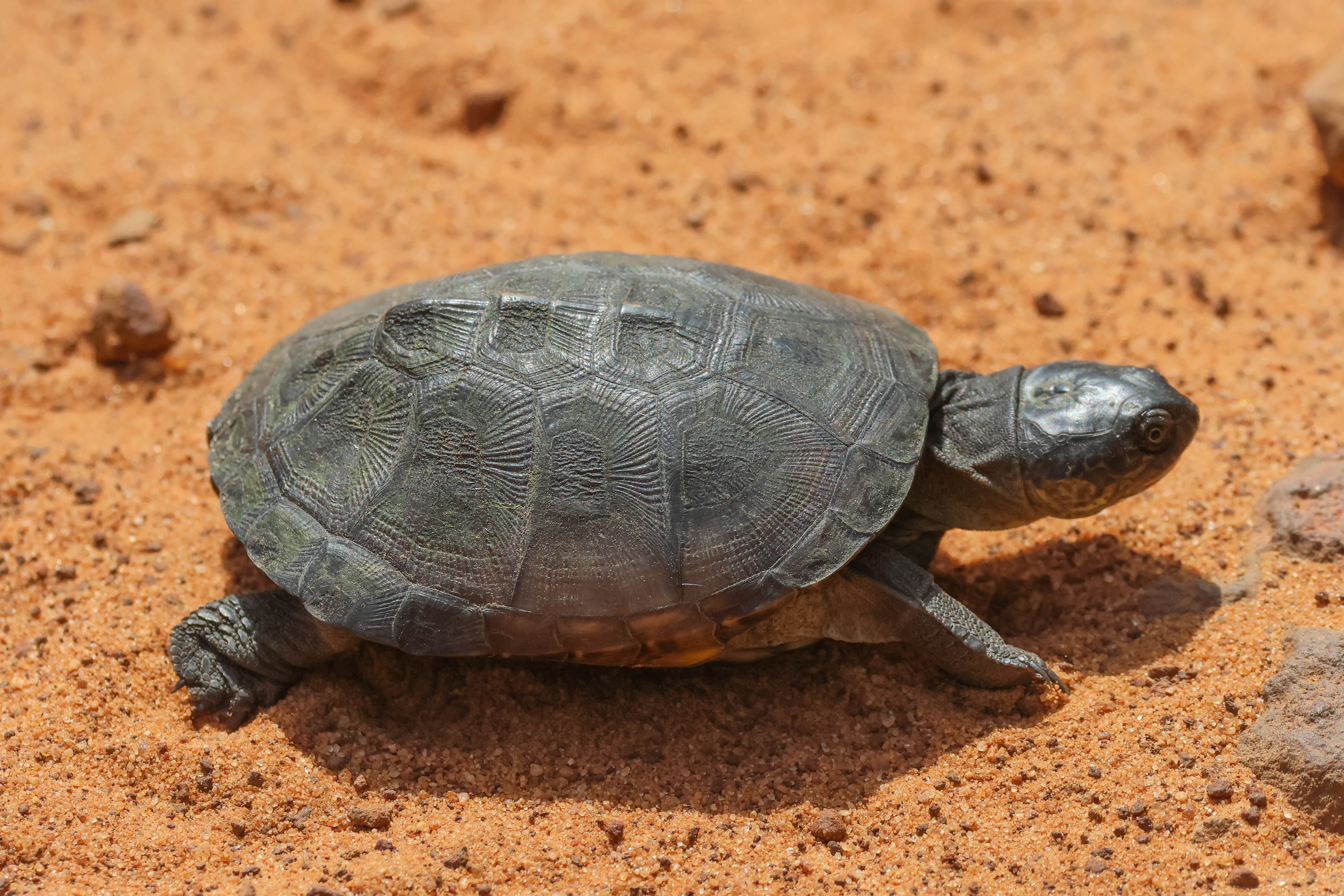
As we drove back up the track, we stopped for a West African Mud Turtle which was crossing the road. We had another quick look at some pools further up, where there was no sign of the hoped for Painted Snipe but a Common Snipe came out of the vegetation and a juvenile Black-crowned Night Heron flew across. Our first Yellow-billed Oxpeckers were actually on a donkey here (not an ox!) and a Purple Heron flew through the trees beyond.

We were heading to Stala for lunch and there were lots of Fiddler Crabs on the mud as we drove out through the mangroves to the lodge. Again, it was a nice place to sit, in the shade, overlooking the river beyond, and another delicious local lunch was laid out for us. Afterwards, we had arranged a boat trip on the river.
Heading downstream first, we came across several more Ospreys first – we saw amazing numbers of them today. There were lots of terns loafing on the bank, including Caspian, a few Royal and Sandwich and one or two Gull-billed Terns. Two pairs of Wattled Lapwings on the water’s edge were our best views yet, and there were lots of Whimbrel, plus Greenshank, Redshank, Common Sandpipers and a couple of Ringed Plover on the muddier stretches.
We got down almost to the mouth of the river, before we had to turn back. We could see a raptor circling now, way off in the distance, and the boatman accelerated back up the river to get us a little closer, at which point we could confirm it was an African Fish Eagle. Unfortunately, it remained rather distant, over on the Senegal side of the river, but a Beaudouin’s Snake Eagle circled up too. We continued on past Stala, upstream a short way where there were more Senegal Thick-knees and a nice Blue-breasted Kingfisher, but no sign of the Goliath Heron we had been hoping to find.
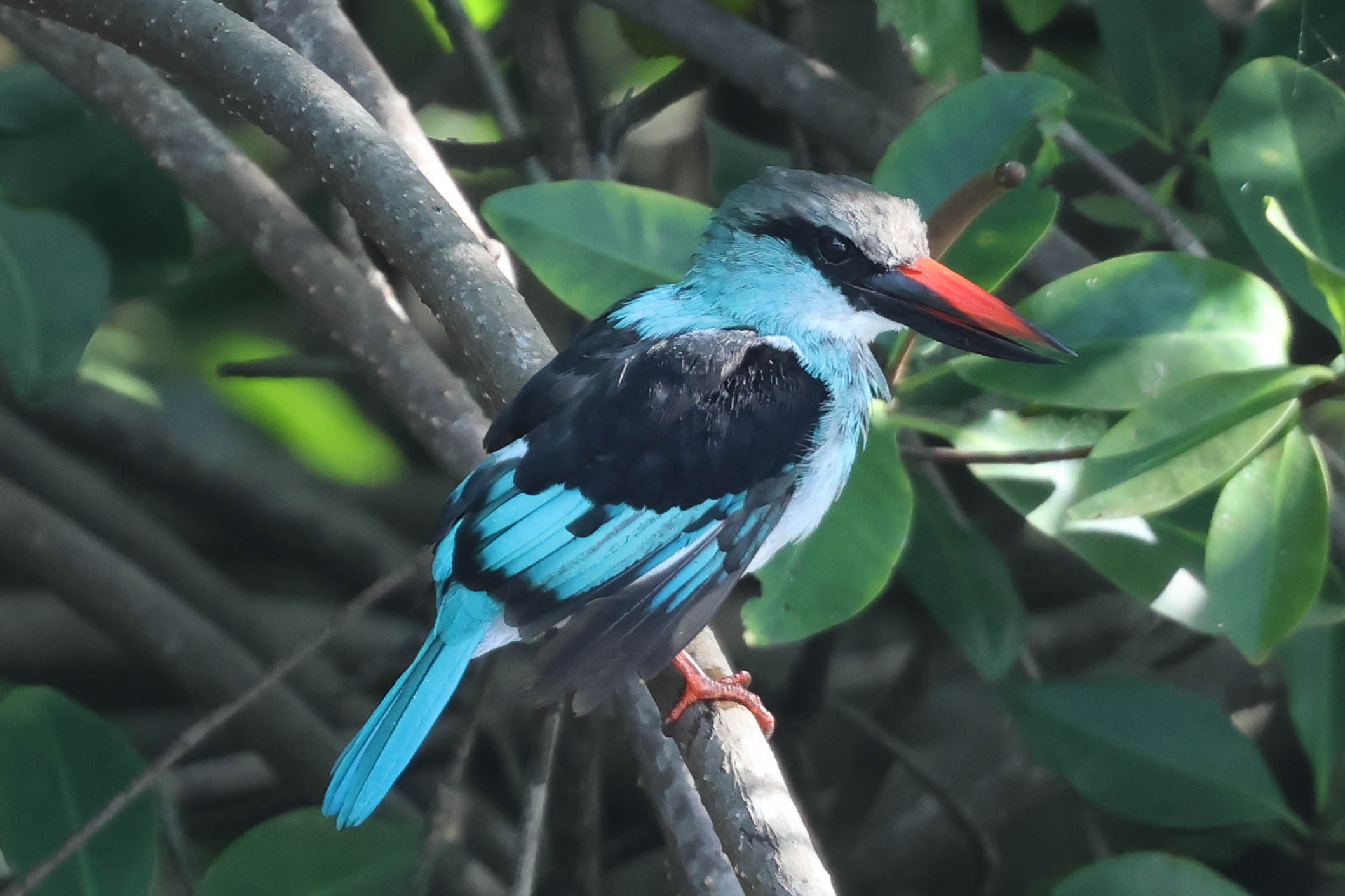
It was a long drive back, and after the early start this morning we decided to call it a day. A Lanner Falcon flew over as we got back on to the road. The traffic was not so bad today, and we got back to the hotel in good time tonight. We even had time for a little bit of birding in the grounds to round off the day, watching the Green Wood-hoopoes going in and out of their nest hole in the stump just behind the restaurant and nice views of several Long-tailed Glossy Starlings in the trees.
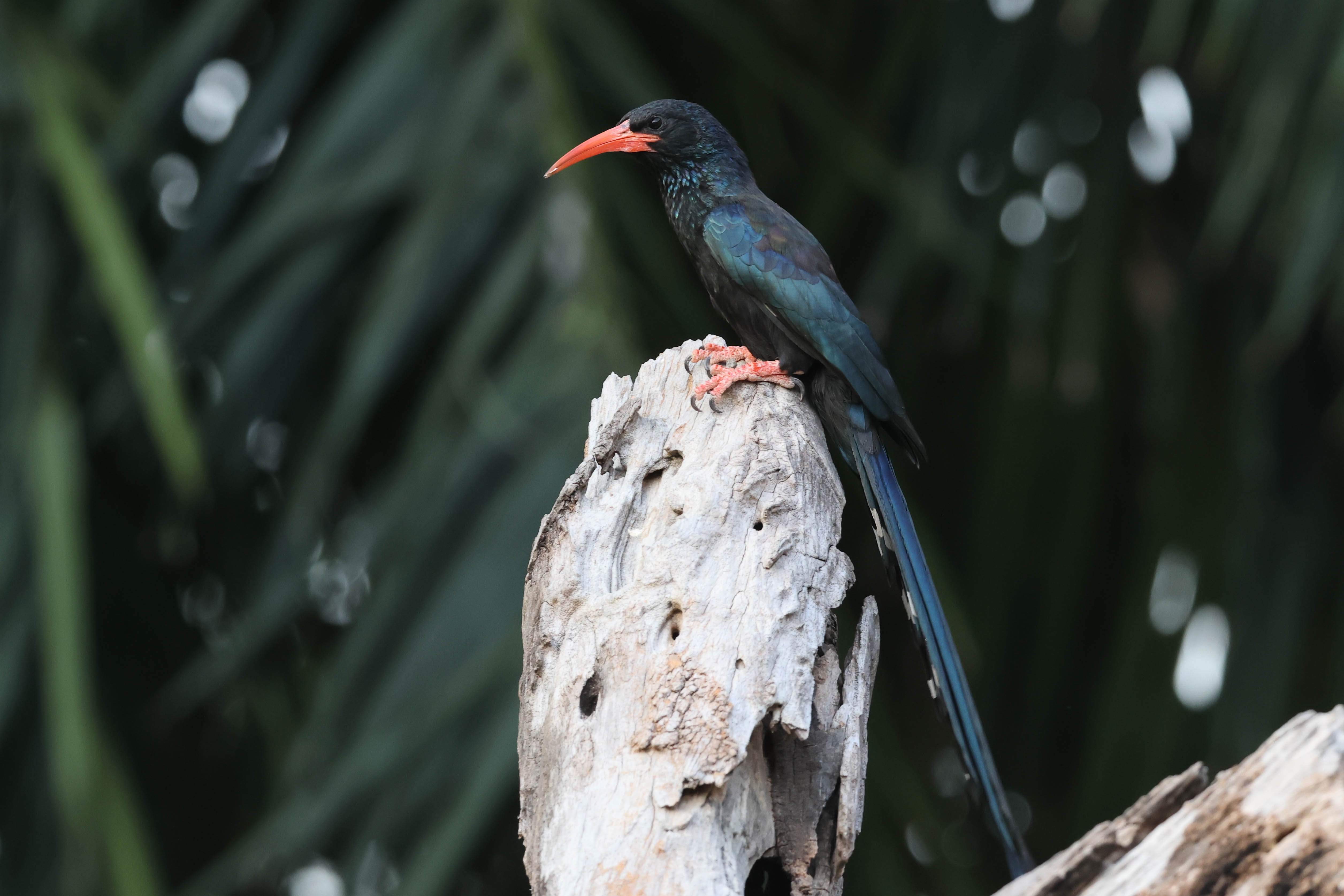
Thursday 24th November
After breakfast at the hotel again today, we drove down to Sohm, close to the border with Senegal. We turned on to a dusty track, through the village and then out through overgrown cultivations. A male Black-winged Bishop was perched up in the vegetation by the track as we passed and several Mottled Spinetails zoomed in and out of trees.
We got off the bus and walked in on a small track through the vegetation, and despite this being our last day’s birding the birds were still coming thick and fast. There were lots of sunbirds here, including a couple of Copper, a Pygmy and a smart male Scarlet-chested Sunbird.
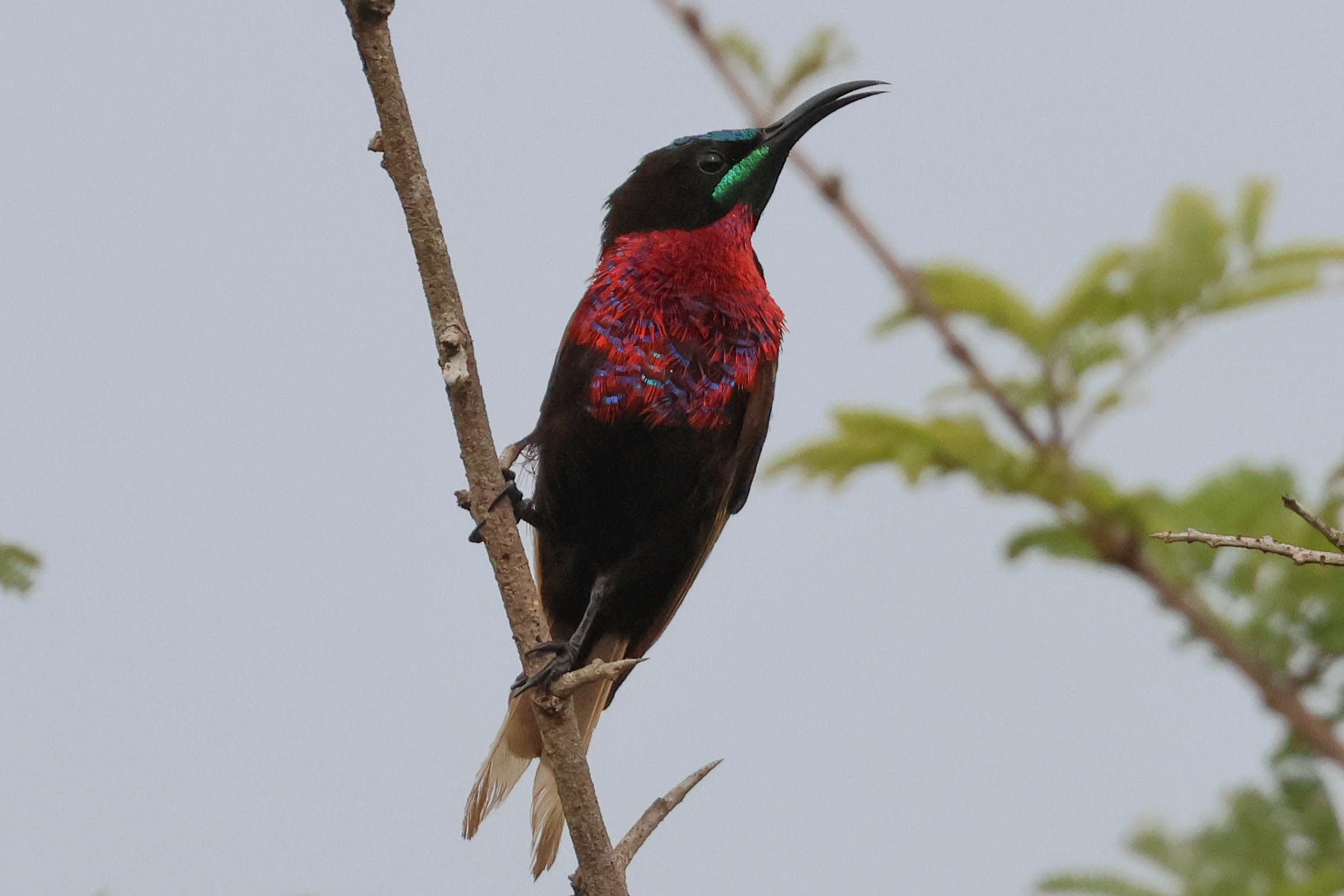

It didn’t take long to locate one of our first targets here, with a couple of African Yellow White-eyes, and we also had great views of a pair of Senegal Batis, several Senegal Eremomela and one or two Melodious Warblers in the bushes. A Dideric Cuckoo came in too, but kept low down and was hard to see.

An amazing number of African Golden Orioles appeared, hard to tell how many but five flew over together at one point and a smart male dropped in briefly. There were several species of weaver too, and Modou had a brief glimpse of a Heuglin’s Masked Weaver. But the highlight here was the smart pair of Black-faced Firefinch which flew in, a scarce species here and a pretty one too.

We decided to try a bit further in to try to get better views of the weaver. As we walked through the vegetation a large bird flew up just ahead of us, flashing lots of white in the wing – a male Black-bellied Bustard! We had good views of it as it flew off, another great bird.
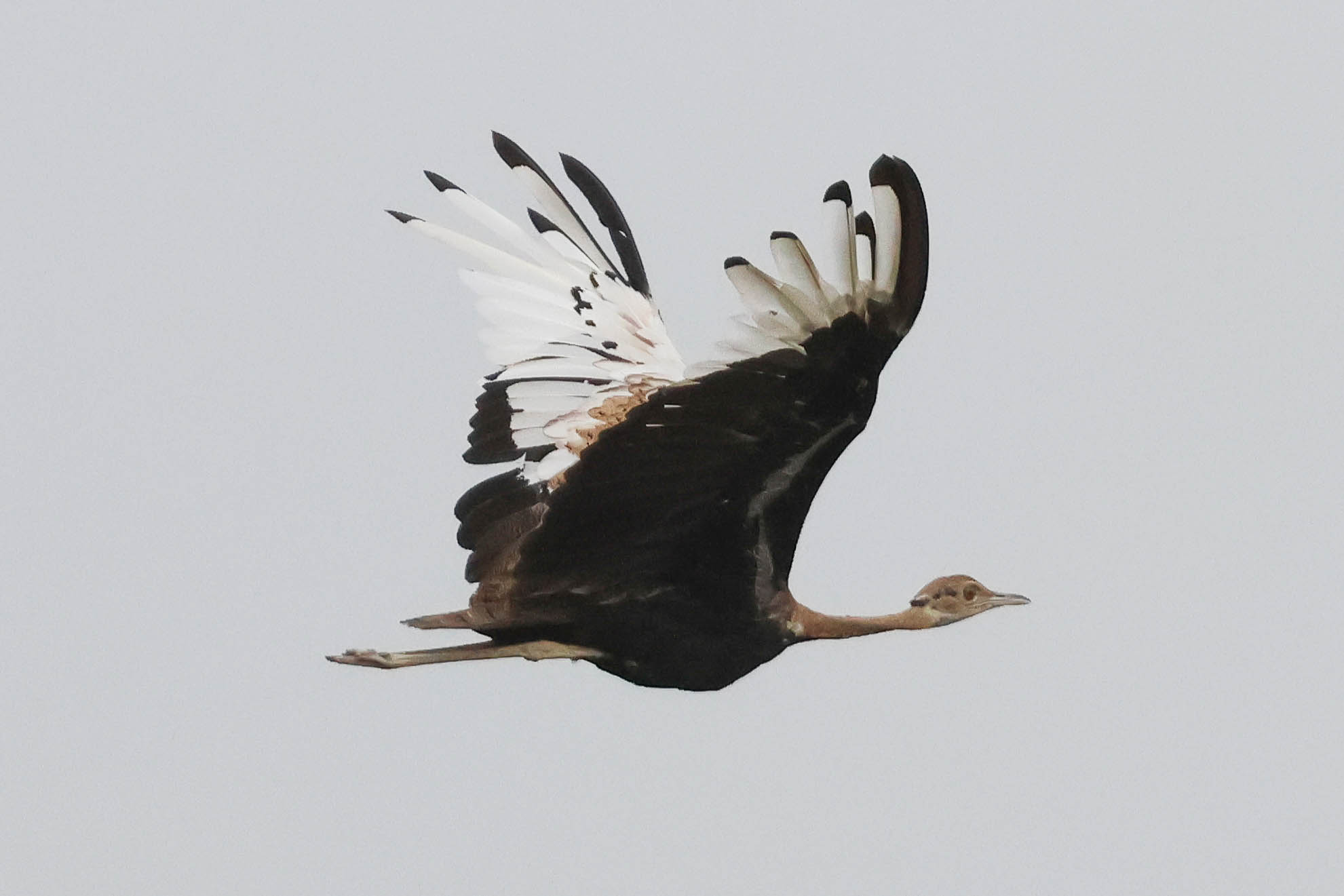
We positioned ourselves overlooking some small trees now and waited. The Dideric Cuckoo flew back in and this time perched in full view for a long period, allowing us to get it in the scopes and have a really good look, and a Levaillant’s Cuckoo flew over. A Brown-backed Woodpecker appeared in the trees too and we eventually got better views of a Heuglin’s Masked Weaver. Both Whistling and Singing Cisticolas perched up nicely in quick succession.

We had already seen a fantastic selection of birds here, then as we were making our way back out, a Yellow-bellied Hyliota started calling in a tree by the track and dropped down into the bushes right ahead of us.
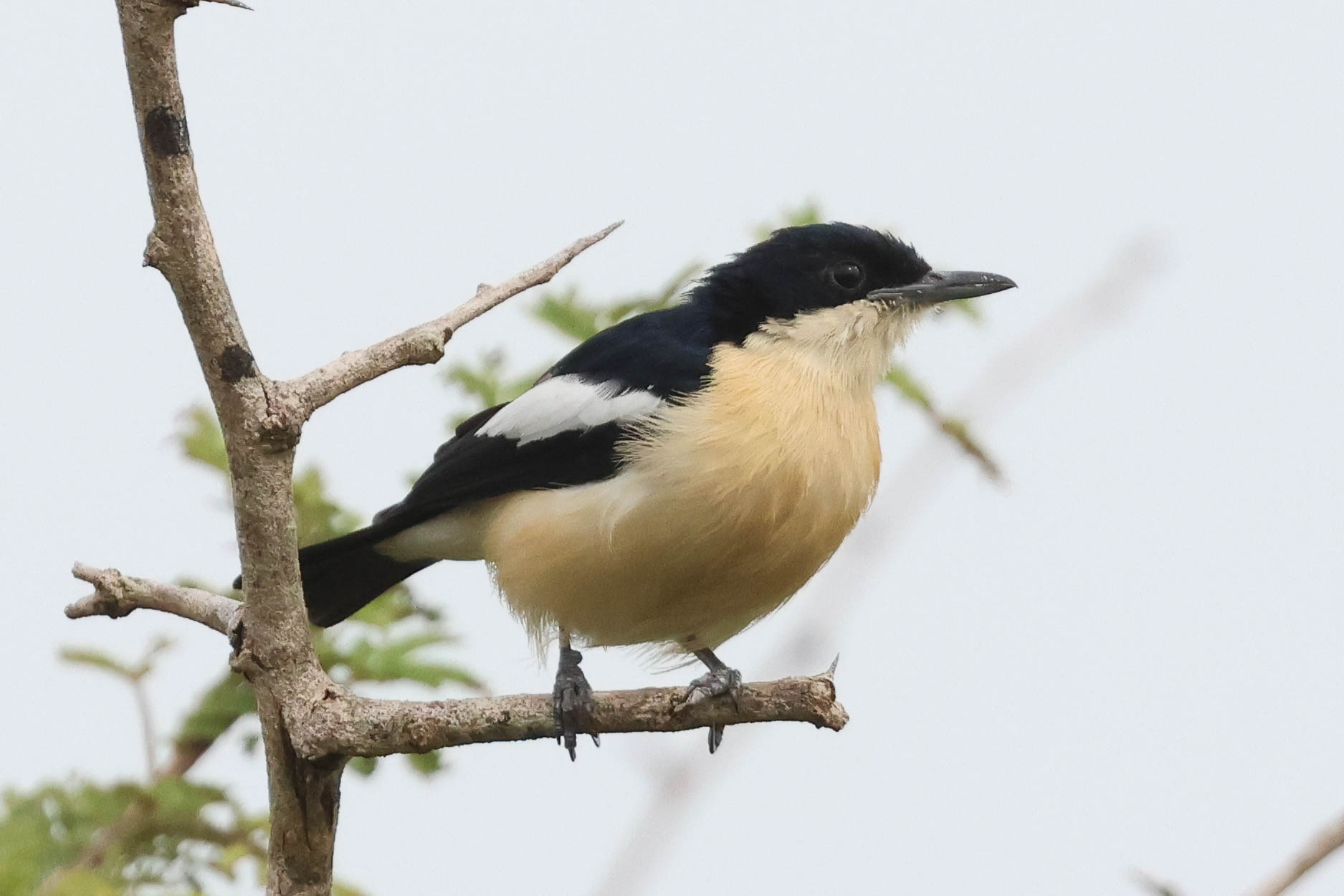
Back on the bus, we drove on to a nearby area of forest. A pair of Western Violet-backed Sunbirds, a Klaas’s Cuckoo, another Hyliota and a couple of Pearl-spotted Owlets came in to investigate and a Dark Chanting Goshawk flew over and landed in the trees nearby but there didn’t seem to be anything different here today so we moved on again.
We drove deeper in to an area of more open savannah woodland and again it seemed to be alive with birds here. Lots of European Bee-eaters were hawking from the overhead electricity wires and nearby trees and several Swallow-tailed Bee-eaters perched up on the bushes in front of us.
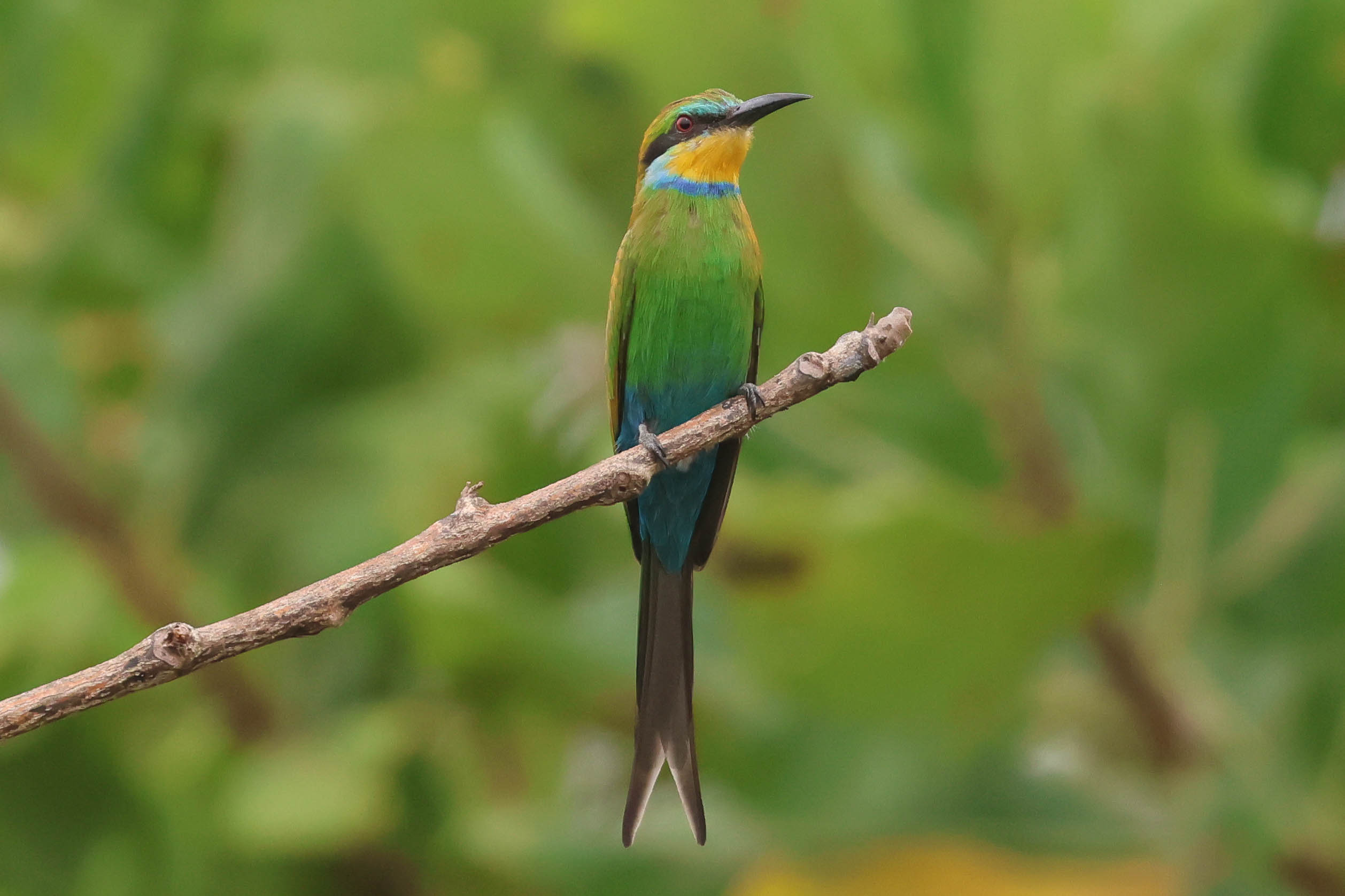
A Yellow-billed Shrike, male Northern Puffback and Northern Black Flycatcher all appeared in the same tree. There were lots of sunbirds, another couple of White-eyes, Melodious Warbler, Red-winged Warblers, Tawny-flanked Prinia and a pair of Grey-backed Cameroptera. A Yellow Penduline Tit flashed through but unfortunately didn’t stop.
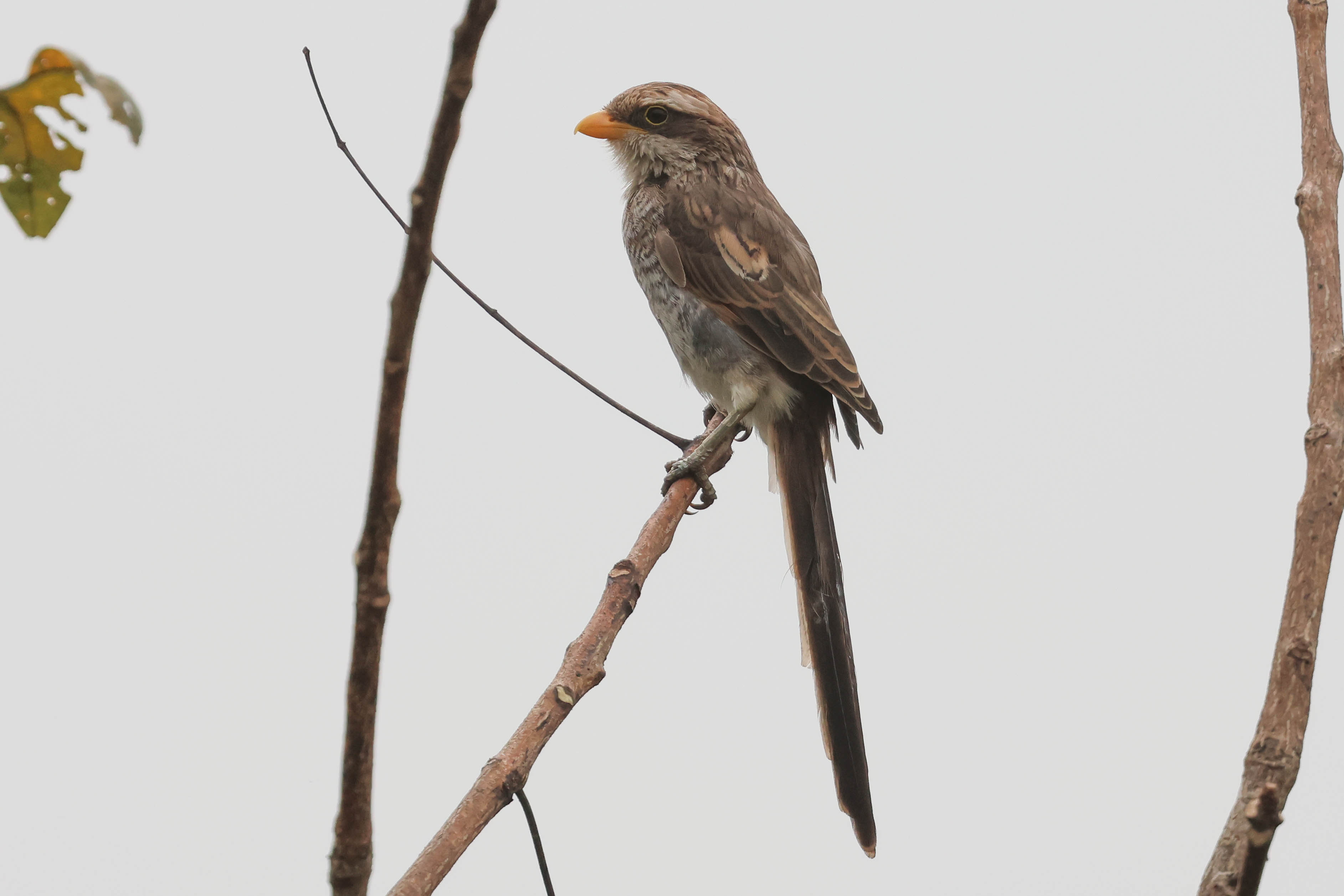
That was a good enough supporting cast but there were lots of new birds for us here too. A White-shouldered Black Tit came in to investigate, although kept its distance and then a Black Scimitarbill flew in to the top of the trees above us. A Pied-winged Swallow appeared briefly over the trees and a male Blackcap was new for the list but probably less exciting for us.
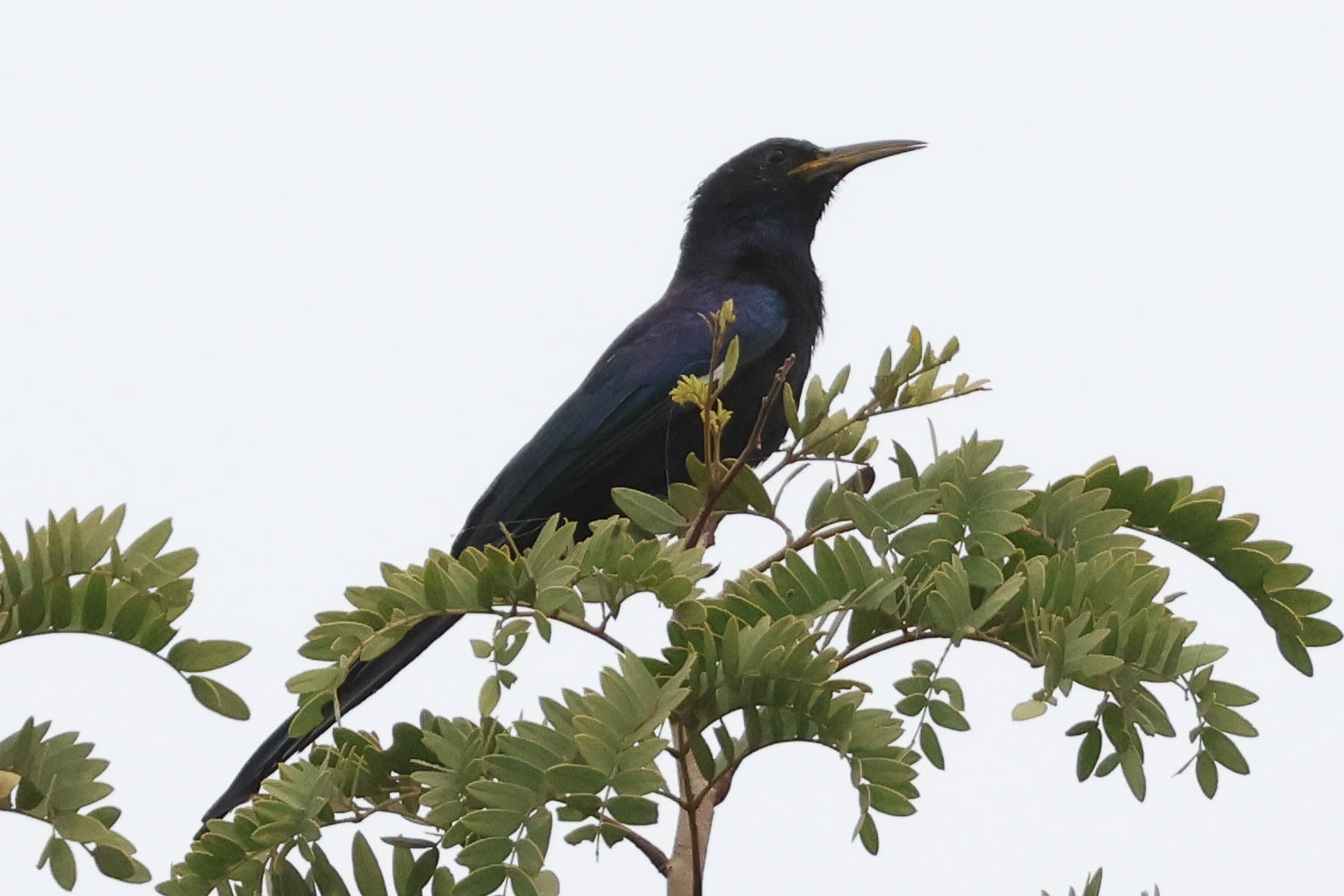
A Brubru started calling and eventually one appeared in the trees. The Yellow Penduline Tit was calling too now, but still wouldn’t show itself properly. As we turned to walk back, a Greyish Eagle Owl flew up in and landed in the trees ahead of us. We were hoping we might find some different larger raptors here, but it was rather cloudy today and still and just a few Hooded Vultures were trying to circle up now.
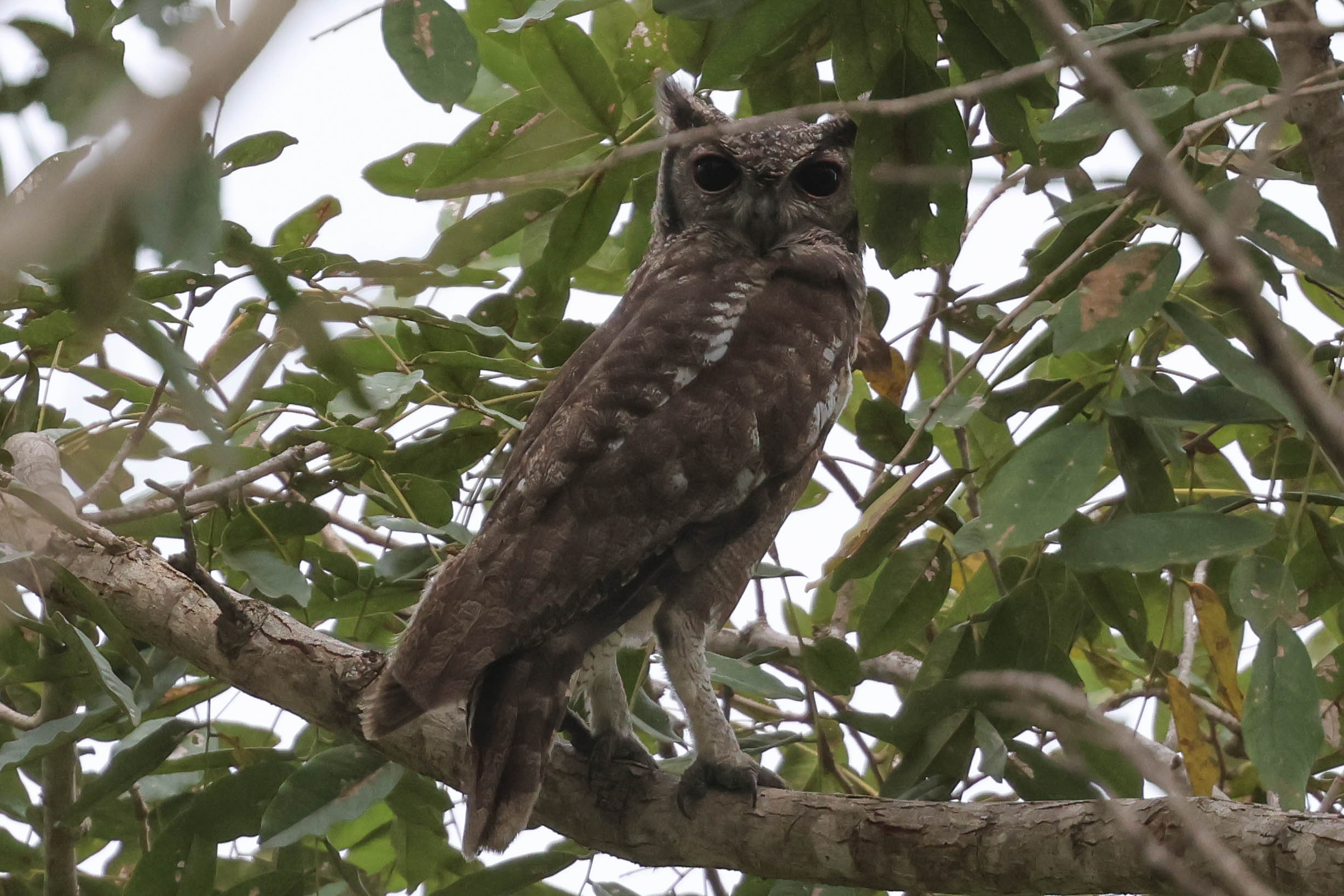
We walked on and out into a more open area where cattle were grazing. Several Yellow-billed Oxpeckers were on the backs of the cows – nice to see them on an ‘ox’ this time – and a couple of Wattled Lapwing flew up from the grass. A Mottled Spintail seemed to come in to investigate us, making a single low pass right over our heads then gone. Two Western Bonelli’s Warblers and one or two Willow Warblers flitted around in the acacia scrub and two moulting male Pin-tailed Whydah appeared with the weavers in a nearby tree.
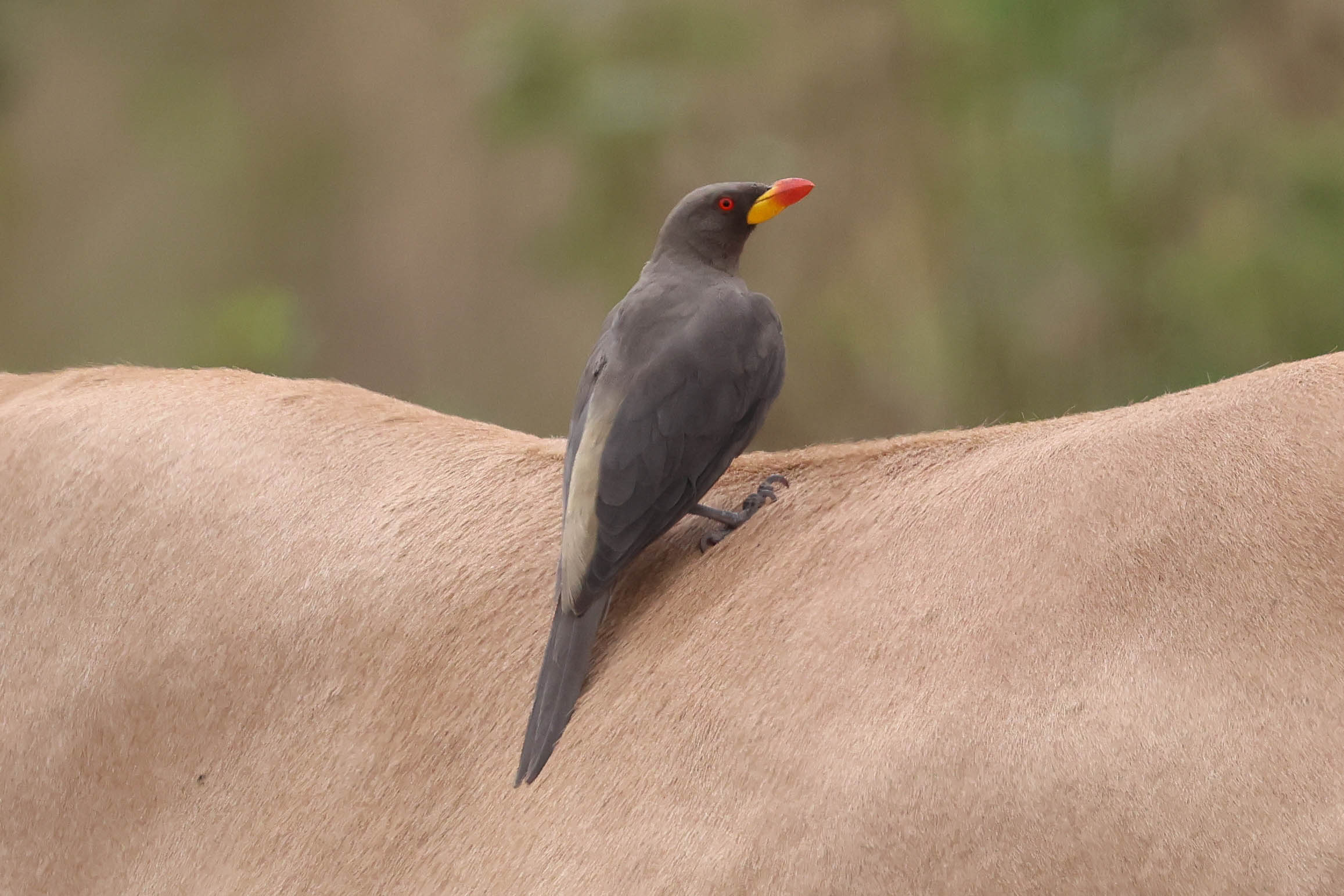
Something spooked all the European Bee-eaters out of the trees beyond and it was an impressive sight as a hundred or so of them took to the sky. There were some small pools here, and as we walked round we flushed lots of Bronze Mannikins and several Namaqua Doves. A couple more Black Scimitarbills were probing around a dead tree, another pair of Brubru were in the bushes, a Greater Honeyguide flew into the top of the tree above and the White-shouldered Black Tit appeared again.
As we were making our way back to the bus, there were still more distractions. We found the Yellow Penduline Tits now in an acacia right in front of us and they stayed to allow us a good look in the scopes.
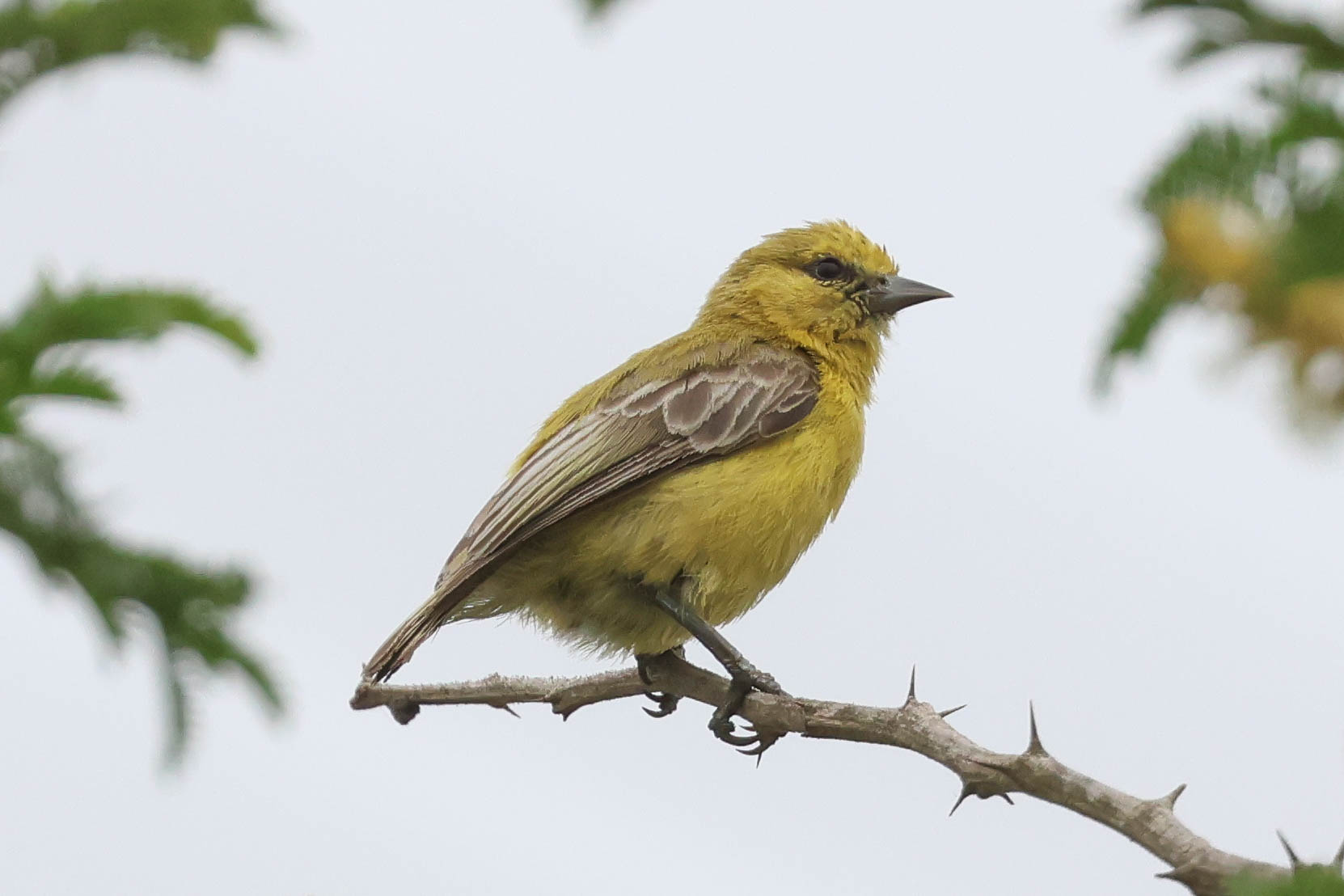
A family of Yellow-billed Shrikes dropped into the top of a tree nearby where a Fanti Sawwing was also perched – nice to see one that wasn’t just zooming round.
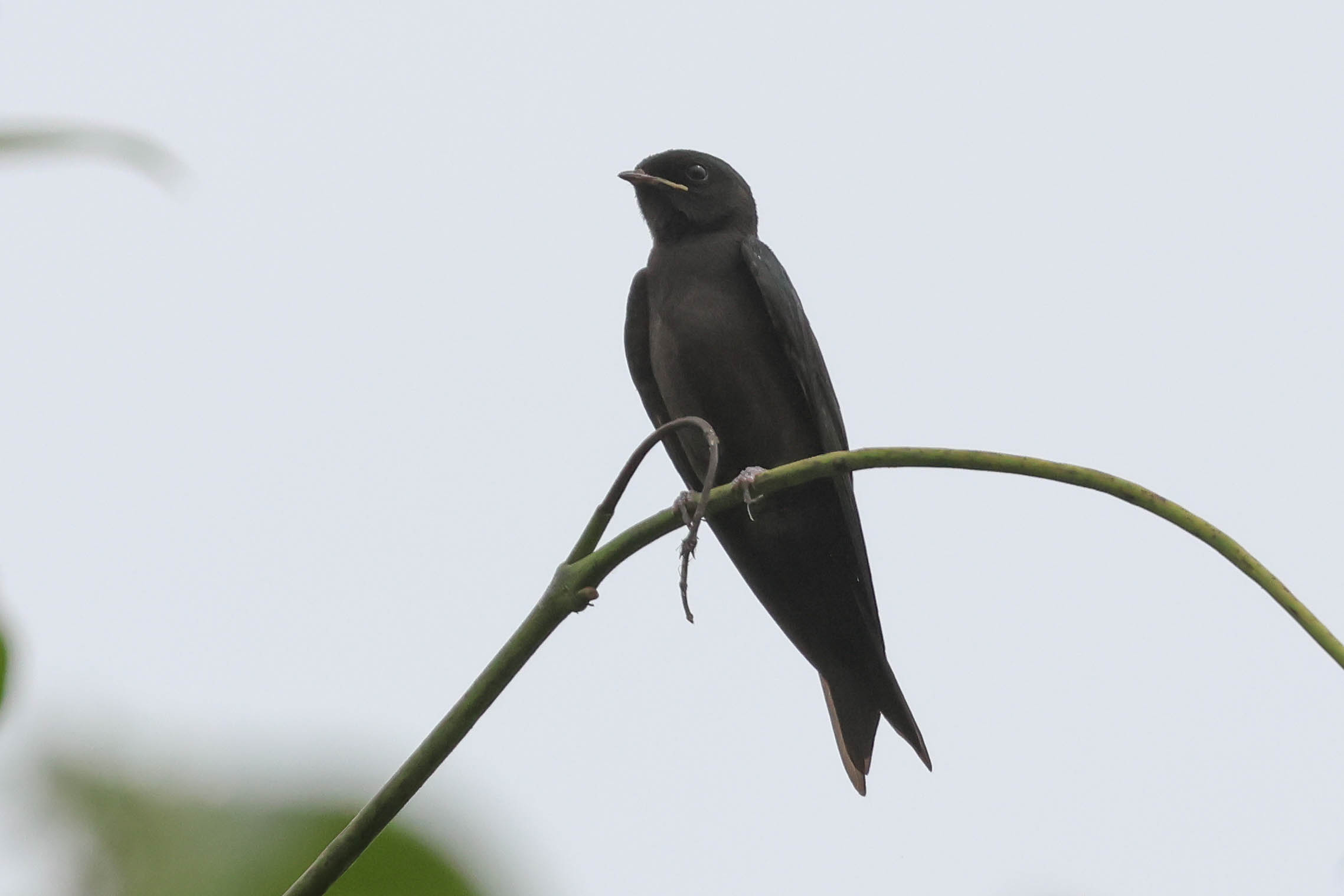
We had maximised the morning hours and been rewarded with so many new birds, but the time had flown and we walked back now to the bus and drove to a nearby lodge for a late but very welcome lunch break and a chance to rest for a while. Afterwards, we had a look around the grounds and the surrounding cultivations. There were lots of glossy starlings feeding in a fruit tree in the garden, including several Purple, a couple of Bronze-tailed, and a single Greater Blue-eared Starling.
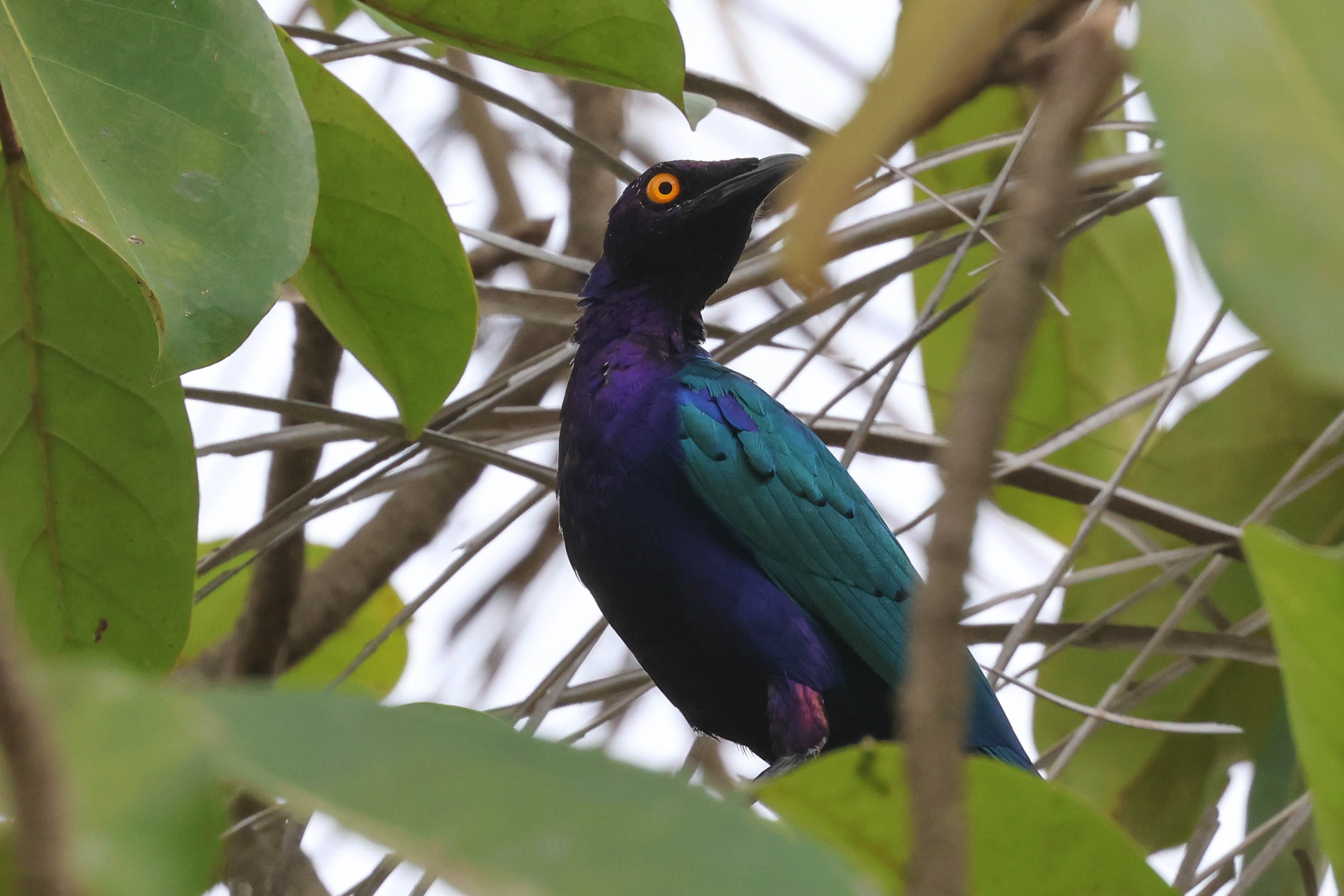
An African Harrier Hawk flew over and when all the weavers scattered from the nearby palms, we looked up to see an Ovambo Sparrowhawk fly across and land in a nearby tree. Several Speckled Pigeons and doves were coming down to feed on a small patch of grain put out between the huts and as we walked out through the gates there were lots of doves in the trees around the ricefields – very different from modern agriculture back home. A Mottled Spinetail lingered overhead now, giving us better views and a Grey Woodpecker appeared briefly in the trees behind us.

Then it was unfortunately time to head back. We got back to the hotel in good time again today, and sadly said our last farewells to Modou, Fanta and our bus driver.
Friday 25th November
We had to be checked out of the hotel by midday today, so it was a morning of leisure. Given that, it was perhaps a surprise to see so many of the group up and about for the start of breakfast again. There are plenty of birding opportunities just around the hotel grounds though and we wanted to make the most of the last few hours. A Grey Kestrel showed very well in the trees behind the beach, where a mixed but rather mobile flock of glossy starlings were also to be found early on.

It was a chance to try to get some last photos of the Blackcap and Brown Babblers, White-crowned Robin Chat, Western Red-billed Hornbills, Green Woodhoopoes, Hooded Vultures and more, though the local monkeys failed to put in an appearance today for their photo opportunity.
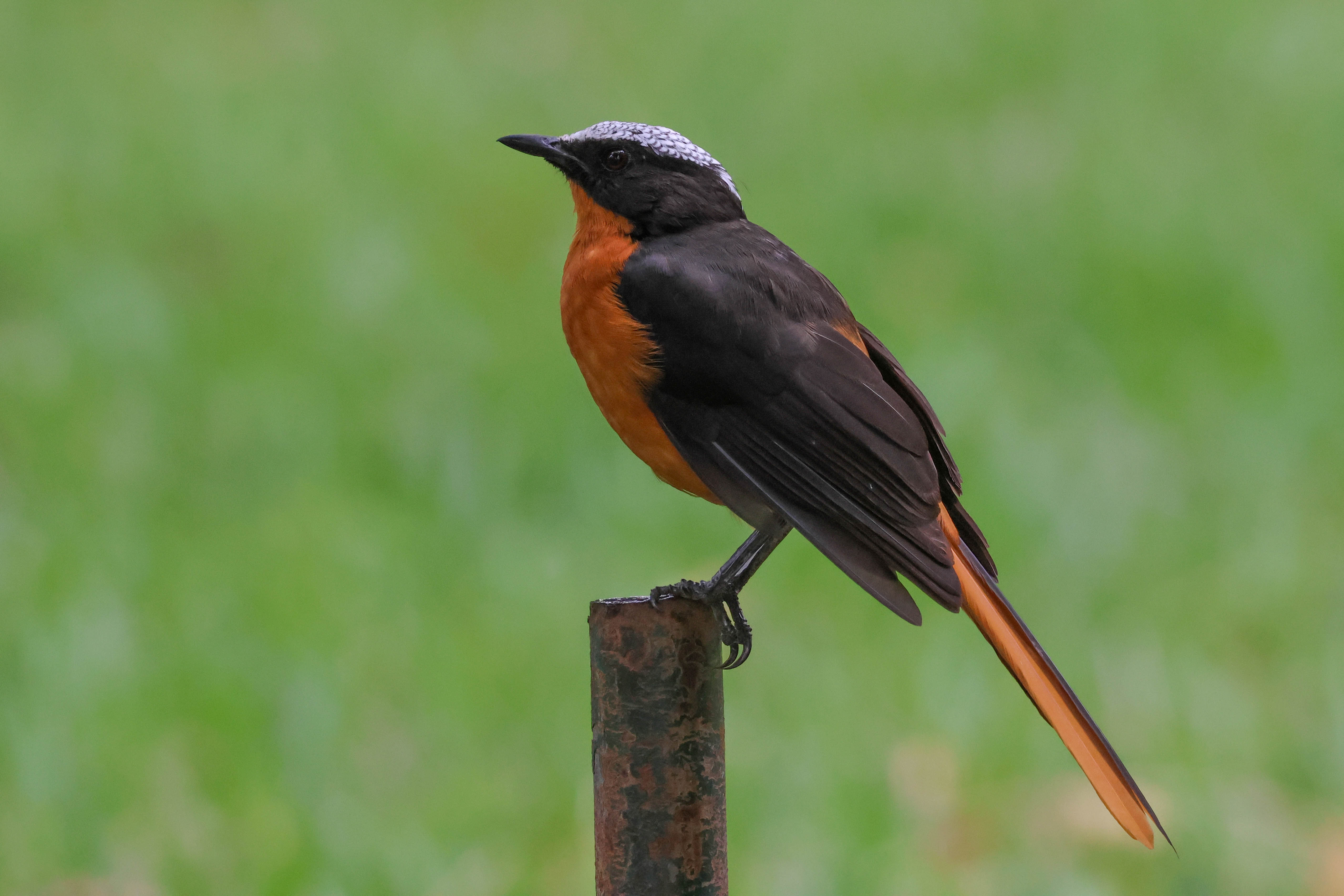
For those who wanted it, we met again for an early lunch down at the beach bar, although the ordering process was a bit chaotic and the food ended up taking longer to arrive than we had expected. Then time for a quick check out and the coach was already waiting outside to take us to the airport. Our flight left on time at 4pm and again arrived about half an hour early into Gatwick just after 10pm. The airport was fairly quiet at this time of night and we got out to baggage reclaim quickly, so it was even more of a surprise to find our bags already arriving on the carousel. Once everyone had got their bags, we said our final goodbyes.
What a visit to The Gambia – a great list of birds, well in excess of any of our expectations. Roll on the return in 2023!
















